OMB Number: 3235-0288 Expires: September 30, 2007 Estimated average burden Hours per response: 2631.00
OR SHELL COMPANY REPORT PURSUANT TO SECTION 13 OR 15(d) OF THE SECURITIES EXCHANGE ACT OF 1934 Date of event requiring this shell company report__________________ For the transition period from to
Securities registered or to be registered pursuant to Section 12(b) of the Act.
Securities registered or to be registered pursuant to Section 12(g) of the Act. COMMON SHARES
(Title of Class) Securities for which there is a reporting obligation pursuant to Section 15(d) of the Act.
this form are not required to respond unless the form displays a currently valid OMB control number
Indicate the number of outstanding shares of each of the issuer's classes of capital or common stock as of the close of the period covered by the annual report.
Indicate by check mark if the registrant is a well-known seasoned issuer, as defined in Rule 405 of the Securities Act.
If this report is an annual or transition report, indicate by check mark if the registrant is not required to file reports pursuant to Section 13 or 15(d) of the Securities and Exchange Act of 1934.
__X__Yes ____No Note - Checking the box above will not relieve any registrant required to file reports pursuant to Section 13 or 15(d) of the Securities Exchange Act of 1934 from their obligations under those sections.
Indicate by check mark whether the registrant (1) has filed all reports required to be filed by Section 13 or 15(d) of the Securities Exchange Act of 1934 during the preceding 12 months (or for such shorter period that the registrant was required to file such reports), and (2) has been subject to such filing requirements for the past 90 days.
Large accelerated filer _____ Accelerated filer _____ Non-accelerated filer __X___
Indicate by check mark which financial statement item the registrant has elected to follow.
(APPLICABLE ONLY TO ISSUERS INVOLVED IN BANKRUPTCY PROCEEDINGS DURING THE PAST FIVE YEARS)
Indicate by check mark whether the registrant has filed all documents and reports required to be filed by Sections 12, 13 or 15(d) of the Securities Exchange Act of 1934 subsequent to the distribution of securities under a plan confirmed by a court.
The table below presents selected statement of operations and balance sheet data for Royal Standard Minerals Inc. as at and for the fiscal years ended January 31, 2008, 2007, 2006, 2005, and 2004. The selected financial data presented herein is prepared in accordance with accounting principles generally accepted in Canada ("Canadian GAAP") and include the accounts of the Company and its wholly-owned subsidiaries, Southeastern Resources Inc., Pinon Exploration Corporation, Standard Energy Inc., and Manhattan Mining Co., all United States Companies.
A summary of the differences between accounting principles generally accepted in Canada ("Canadian GAAP") and those generally accepted in the United States ("US GAAP") which affect the Company is contained in Note 16 of the Consolidated Financial Statements included with this report.
1. For details see Note 2 of the Royal Standard Minerals Consolidated Financial Statements (Audited)for the Years ending January 31, 2008 and 2007.
Except where otherwise indicated, all dollar figures in this annual report on Form 20-F, including the financial statements, refer to United States currency. The following table sets forth, for the periods indicated, certain exchange rates based on the exchange rates reported by the Federal Reserve Bank of New York as the noon buying rates in New York City for cable transfers in foreign currencies as certified for customs purposes (the "Noon Buying Rate"). Such rates quoted are the number of U.S. dollars per Cdn $1.00 and are the inverse of rates quoted by the Federal Reserve Bank of New York for the number of Canadian dollars per U.S. $1.00.
(1) Based on the average exchange rates on the last day of each month during the applicable period.
The operations of Royal Standard involve a number of substantial risks and the securities of Royal Standard are highly speculative in nature. The following risk factors should be considered:
Trading of the Common Shares of Royal Standard on the TSX Venture Exchange and OTC Bulletin Board has been sporadic and very limited and no assurance can be given that an active trading market will develop or be sustained. Investment in Royal Standard is, therefore, not suitable for any investors who may have to liquidate their investments on a timely basis and should only be considered by investors who are able to make a long term investment in Royal Standard.
At January 31, 2008, the Company had an accumulated deficit of U.S. $16,070,582. There can be no assurance that the Company will ever achieve revenues from operations or that its operations will ever be profitable.
The terms of the Company's rights to its properties require that the Company expend significant funds on exploratory and other pre-production activities. Should the Company fail to make these expenditures on a timely basis, it would forfeit its rights to the particular projects, including the sums expended through the dates of such forfeitures. The Company's present capital resources are sufficient to fund these costs. There can be no assurance that the Company will be able to raise additional capital on acceptable terms or at all. In any event, any additional issuance of equity would be dilutive to the Company's current shareholders.
The Company is an exploration stage enterprise with no history of prior operations and no earnings. There can be no assurance that the Company's operations will become profitable in the future. The success of the Company will be dependent on the expertise of its management, the quality of its properties, and its ability to raise the necessary capital to carry out its business plan. If financing is unavailable for any reason, the Company will be unable to acquire and retain its mineral concessions and carry out its business plan.
Any exploration operations carried on by the Company are subject to government legislation, policies and controls relating to prospecting, development, production, environmental protection, mining taxes and labor standards. In addition, the profitability of any mining prospect is affected by the market for minerals which is influenced by many factors including changing production costs, the supply and demand for minerals, the rate of inflation, the inventory of mineral producers, the political environment and changes in international investment patterns.
There is significant competition for the acquisition of properties producing or capable of producing gold and precious minerals. The Company may be at a competitive disadvantage in acquiring additional mining properties since it must compete with other individuals and companies, many of which have greater financial resources and larger technical staffs than the Company. As a result of this competition, the Company may be unable to acquire attractive mining properties on terms it considers acceptable.
The validity of unpatented mining claims on public lands, which constitute most of the property holdings is often uncertain and may be contested and subject to title defects.
Certain directors and officers of the Company are also directors and officers of other natural resource and base metal exploration and development companies. As a result, conflicts may arise between the obligations of these directors to the Company and to such other companies.
The Company's success will be dependent upon the services of its President and Chief Executive Officer, Mr. Roland Larsen.
As of January 31, 2008, the Company had outstanding options and warrants to purchase an aggregate of 14,314,496 Common Shares. All of the foregoing securities represent the right to acquire Common Shares of the Company during various periods of time and at various prices. Holders of these securities are given the opportunity to profit from a rise in the market price of the Common Shares and are likely to exercise its securities at a time when the Company would be able to obtain additional equity capital on more favorable terms. Substantial sales of Common Shares pursuant to the exercise of such options and warrants could have a negative effect on the market price for the Common Shares.
The Company does not anticipate paying dividends in the foreseeable future.
Royal Standard Minerals Inc. herein referred to as "Royal Standard" or the "Company", was incorporated pursuant to the laws of Canada by articles of incorporation dated December 10, 1986 under its former name, Ressources Minieres Platinor Inc. ("Ressources"). On April 30, 1996, Royal Standard shareholders approved the acquisition of all the issued and outstanding shares of Southeastern Resources, Inc. ("Southeastern") in a reverse take-over transaction. Pursuant to this transaction, articles of amendment were filed effective May 14, 1996, pursuant to which the name of Royal Standard was changed to its current form of name and its shares issued and outstanding at that time were consolidated on a 7.5:1 basis. On June 28, 1996, the Common Shares commenced trading on the Montreal Exchange. The Company is continued under the New Brunswick Business Corporations Act and its common shares are listed on the TSX Venture Exchange symbol RSM. The Company also trades in the United States Overthe-Counter Bulletin Board symbol RYSMF.
The registered office of Royal Standard is located at 360 Bay Street, Suite 500, Toronto, Ontario M5H, 2V6 and the principal office of Royal Standard is located at 3258 Mob Neck Road, Heathsville, Virginia 22473. The Company also has an office at One Main Street, Manhattan, Nevada, 89022.
Royal Standard is a mineral exploration company engaged in locating, acquiring exploring and the development of gold and precious metal deposits in the state of Nevada. The Company owns a 100% interest in eight (7) projects in four (3) gold-silver districts in Nevada. These projects include the Goldwedge project in Nye County, the Pinon, Railroad and Dark Star projects in Elko County, Mustang Canyon, in Esmeraldo County, the Fondaway Canyon, Dixie-Comstock projects in Churchill.
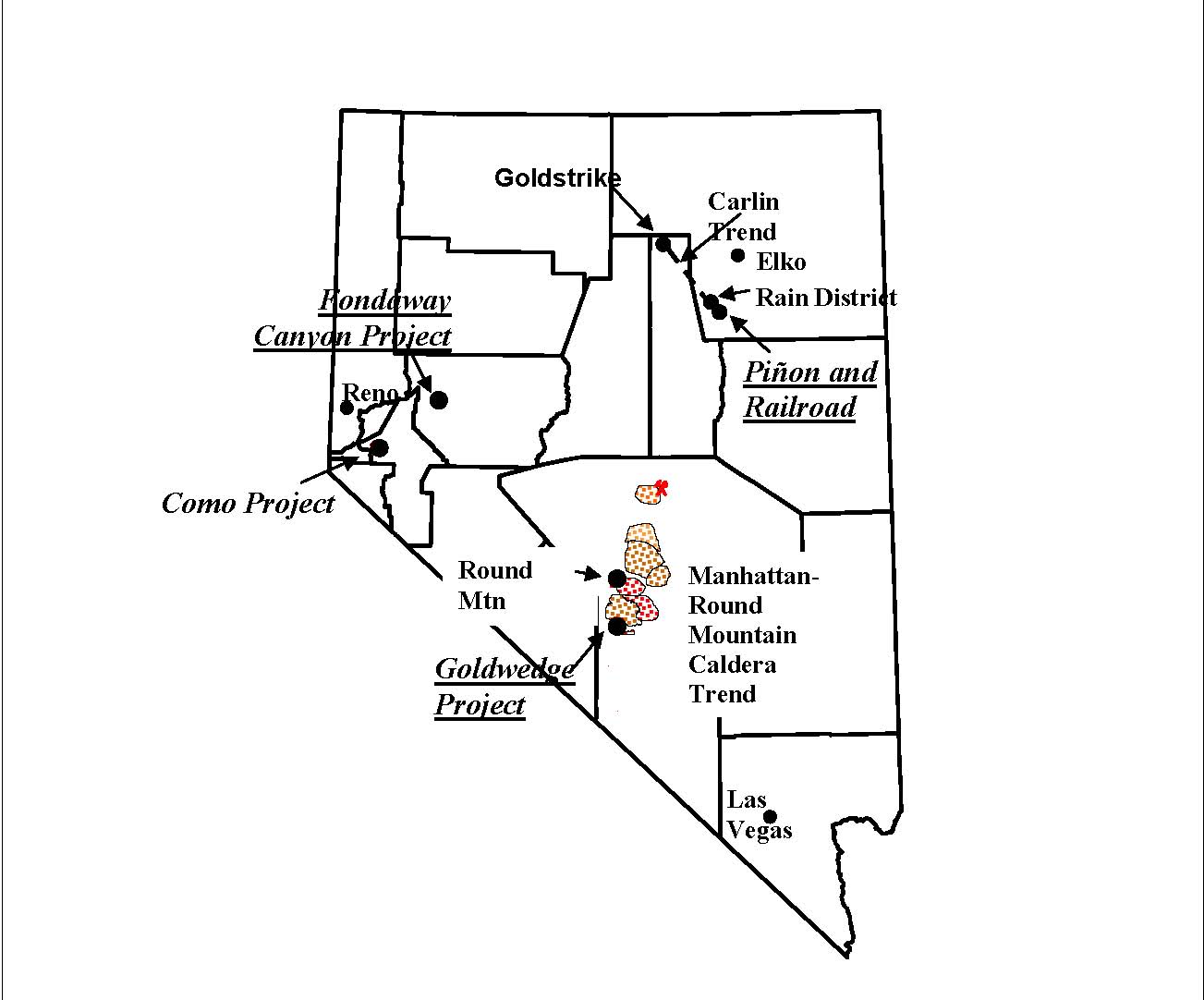
Goldwedge Project
The Goldwedge, one of several gold deposits in the area, is considered one of the best known projects in the district for development of an underground mine. The property contains excellent exploration potential for future growth. Based upon the results of approximately 75 drill holes primarily within the central zone over a strike length of 1,000+ feet and 100'-500' of vertical extent reveal continuous gold oxide mineralization of potential mineable thickness and quality. RSM has analyzed all of the drill data as part of a detailed geologic inventory of the deposit.
The project ownership includes staked BLM lands; options of BLM claims owned by others and patented mining claims owned by the Company. All payments, maintenance fees, option payments and taxes to state and federal authorities are current under state and federal guidelines.
The Goldwedge deposit occurs at the intersection of north and northwest trending faults. In the deposit area, the north trending Reliance fault is mineralized within the Ordovician Zanzibar limestone and siltstone. The target mineralization occurs within multiple high angle structures over a width of between 100-200 feet primarily within the Zanzibar limestone. RSM has evaluated all of the pertinent drill data as part of a detailed inventory of the deposit geometry, size and overall grade. The current exploration model suggests that the Goldwedge deposit and the extensions may contain an economically significant gold resource at depth near the contact with the Manhattan Caldera margin.
The first potential mine development program is the 100% owned Goldwedge deposit located within the Manhattan Mining District. The Goldwedge deposit is located approximately 8 miles south of the large Round Mountain gold mine. All mine and mill (plant) and water use permits were achieved in early, 2004. Also, in 2004 the Company constructed a 700 foot (underground) decline and cross cut to test one of the gold mineralized structures within a 100+ wide structural zone. Additionally, RSM completed the surface facilities necessary to process the material to be mined onsite to include silt ponds, ore pad and the onsite gold processing plant. The Company acquired a full production scale gold recovery (gravity) plant that will be utilized to process the mined material as part of the test mining program.
The underground bulk sampling and decline development program continued during 2007, although the underground effort was hampered by the effects of groundwater. A dewatering well was drilled in 2008 to reduce and control the water levels within the mine. In 2007 the treatment of lower grade mined material continued with the processing this material through an onsite (gravity) plant. The surface facilities and the gold recovery plant were completed in 2005 and modified in 2006-2007 as a means to improve gold recoveries.
During the year ending January 31, 2008, expenses on the Goldwedge project were $4,953,218 bringing total RSM expenses on this project to $11,866,061. Future expenditures are expected to be an additional $3 million over the next two years and relegated to underground development and drilling.
Currently Sierra Power, a commercial electric supplier, services this site. The Company has all of the necessary water rights secured from the State of Nevada.
This project is an advanced exploration project without known reserves and the proposed program is exploratory in nature.
The underground program has several objectives including a test mining program and the establishment of the appropriate mining methods that will be applied to the future development of the property. The underground development as well as surface and underground drilling will be directed toward expanding the resources on this property as well as the completion and testing of the recovery plant design. The gold recovery plant has been modified to included two ball mill circuits and will include a floatation circuit
Pinon and Railroad Projects-Carlin Trend South
This project is located south of the town of Carlin, Nevada in Elko County, Nevada. The project land position is located east of Nevada state route 276 and extends for 10+ miles in a north-south direction south of the town of Carlin. The best access to the project is via I-80 to Carlin and south on route 276 to the property position.
The land position includes unpatented BLM lands, patented lands and fee lands. All payments, maintenance fees to federal and state authorities are current. Landowner option payments are also current and in good standing for this more than 15,000 acre land position.
The Pinon properties are located on the southern portion of the Carlin gold belt about 10 miles south of Newmont's Rain mine Since its inception, various joint-venture partners have spent more than $10 MM on the project.
The Pinon and Railroad projects are located on the southern portion of the Carlin Trend immediately south of Newmont's Rain gold district. The Carlin Trend is one of the most prolific gold trends in the world and has produced more than 50 million ounces of gold. The properties are located within a well-mineralized region, which only adds to the potential for expanding the known gold deposits and making new discoveries. Much of the district wide exploration was undertaken prior to the start of the 1980's and 1990's. Since the mid-1990's the cumulative knowledge of "Carlin-type" gold deposits has expanded tremendously. This expanded knowledge can be used to re-interpret all of the available data, which may identify new exploration targets on the ground controlled by RSM. Also, during the past 10+ years numerous high-grade gold deposits have been discovered along the Carlin Trend that can be mined using underground techniques. Many of these deeper deposits are associated with surface oxidized gold deposits. Essentially no deeper exploration has been conducted under the Pinon and Railroad deposits, or at other places on the property. The exploration opportunity offers the possibility for discovery of additional gold deposits at Pinon-Railroad.
The Railroad project increased the property position within the district to approximately 10,500 acres of leases and includes unpatented and patented mining claims. This effort included the acquisition of nearly 500 unpatented and 19 patented mining claims that lie south of Newmont's Mining's Rain district in Elko County, Nevada.
The Webb Formation is mineralized above the Devils Gate limestone at both deposits. At Rain, the mineralization occurs within and closely associated with the Rain Fault. On the southern portion of the property position, the Pinon Au-Ag project, the known mineralization has not been connected to a strongly mineralized fault. However, higher-grade economic mineralization has been encountered at very shallow depths, mineralized oxide zones occur along a 1,300 feet strike length and occur less than 90 feet below the surface.
The Pinon and Railroad projects include approximately 17,000 acres comprising unpatented BLM lode mining claims, patents and leased fee lands. The focus of RSM's current effort is to identify and develop near surface oxide gold-silver deposits. Approximately 600 shallow drill holes have been completed on 6 near surface gold-silver deposits. The depth extensions of these deposits are not well understood, as deeper drilling has not been sufficient to develop an acceptable understanding of this mineralization.
The Company has developed the necessary construction plans for the Pinon-Railroad project including surface, heap leach facilities design and open pit modeling of the deposits. The 2004-2006 program involved work on the BLM permit application. All of this work has been completed in preparation for the filing of a mining permit application with the US Bureau of Mines (BLM) by year-end 2009. A second objective is to continue with the exploration drilling of the Railroad copper target and to further test the potential of expanding the gold system on the property.
Total exploration expenditures on this project have exceeded $10 million and an additional $20 million will be required to develop a 5,000 ton per day heap leach operation on this project. As of January 31, 2008, RSM and its partners have spent approximately $3.5 million on the Pinon and Railroad projects. Plans include the achievement of a mining permit in 2009 followed project financing.
The property is without known reserves and the proposed program is exploratory in nature.
Fondaway Canyon Project
The 100% controlled Fondaway Canyon gold project is located in Churchill County, Nevada in the Stillwater range. The project is accessible east from Fallon, Nevada via State of Nevada route 116 an unpaved road. The Fondaway deposit is located on the west flank of the Stillwater Range at Fondaway Canyon.
The Fondaway Canyon gold property consists of 148 unpatented BLM lode mining claims (approximately 3,000 acres) located on the western slope of the Stillwater Range. This area is included with the Stillwater Wilderness area. All of the maintenance filing fees are current and in good standing. Nearly-vertical, east-west trending mineralized shear zones host the Half Moon, Paperweight, Hamburger Hill and South Pit gold resources that is hosted within a Mesozoic sedimentary package. The Mesozoic sedimentary package has been intruded by a Mesozoic-Tertiary aged intrusive.
The vertical extent tested by recent drilling of the higher grade gold mineralized shear zones is greater than 1,000 feet. Horizontal continuation of gold mineralization as at the Paperweight and Hamburger Hill mineralized shear zone is 3,700 feet with widths commonly between 5'-20+ feet. Drilling and assay records indicate that 568 holes have been drilled for a total estimated footage of 200,000 feet of RC drilling and 22,000 feet of core drilling to include 455 reverse circulation, 49 core holes and 64 air track holes over a strike length of approximately 12,000 feet. Tenneco Minerals Inc., the most active company, drilled approximately 350 holes (130,000 feet) and drove a 500' adit for sulfide metallurgical sampling during the period 1987-1996. Tenneco also operated a small oxide gold open pit mine for a short time during this period. Nevada Contact Inc. (NCI) acquired the property in 2001 and drilled 11 reverse circulation holes, RSM acquired the property from NCI in early 2003 as part of a property swap with NCI retaining a 1% NSR overriding royalty in the Fondaway Canyon property and $25,000 advance minimum royalty payments to the claim holder until 2006 at which time the payments increase to $35,000 per year that includes a 3% NSR royalty until buyout. There is a buyout option of $600,000 for the owners' interest.
Drill testing the Tenneco heap leach pad in 2007 did not provide positive results. Plans to further drill test the sulfide resource as part of a program to upgrade the indicated and inferred resources on the property are expected when all of the State of Nevada permits are approved to commence this project. This effort will involve drilling underground within the Tenneco adit along with a surface drilling program. A bulk sampling program for metallurgical analysis of the sulfide resource will also be included as part of an effort to develop a gold recovery process that will achieve the desired results.
Estimates of prior expenditures on this property are approximately $5-6 million. The largest portion of these expenditures was contributed by Tenneco Minerals and Tundra Mines LTD. This work included extensive drilling, development of a small open pit production project and an advanced exploration adit on the property. As of January 31, 2008, RSM has spent $246,457 on this project.
The property is without known reserves and the proposed program is exploratory in nature.
Manhattan/Round Mountain Caldera Program
The project area is located southeast of the town of Round Mountain, Nevada east of State route 376. The town of Manhattan is located approximately 15 miles south of Round Mountain. The Manhattan project is located approximately 7 miles east of route 376 on route 377 and 1.5 miles west of the town of Manhattan.
The Manhattan/Round Mountain Caldera program is the Company's most advanced district play includes the Goldwedge advanced exploration program. The land position in the Manhattan Mining District is comprised of 70 unpatented and 3 patented lode-mining claims. An underground development program to include drill testing the extensions of the Goldwedge deposit in addition to the evaluation of several additional lode and placer properties that the Company controls in the district could significantly increase the gold resource estimates.
Freeport Gold, Tenneco (Echo Bay) recognized the potential of the district (to include the Goldwedge deposit that is currently under control by RSM) however, these deposits were not suited for open pit mining. At that time the large mining companies did not consider the underground development projects feasible. Although Sunshine Mining Co.
considered an underground mine development in 1988 on the Goldwedge deposit, continued exploration by Crown Resources and others on the Company's claims indicated sections (5+'-30') of potentially mineable grades greater than 0.5 opt gold. The continued downturn in the gold market, tightened corporate budgets and high holding costs for the properties forced many companies to turn back the land positions to the claim owners. Currently, the Company controls approximately 4,000 feet of strike length. Approximately 1,000-1,200 feet of this strike length has been drill tested indicating positive results.
C. Organizational structure.
The Company has four wholly owned subsidiaries, Southeastern Resources Inc., Pinon Exploration Corporation, Standard Energy Inc., and Manhattan Mining Co., all United States Companies.
D. Property, plants and equipment.
The registered office of Royal Standard is located at 360 Bay Street, Suite 500, Toronto, Ontario M5H, 2V6 and the principal office of Royal Standard is located at 3258 Mob Neck Road, Heathsville, Virginia 22473. The Company also has an office at One Main Street, Manhattan, Nevada, 89022.
Nevada Projects
Goldwedge Project
The Gold Wedge Project is located in the Manhattan Mining District, section 18, T8N, R43E, Mount Diablo Meridian, 1/2 mile west of the town of Manhattan in Nye County, Nevada, (Figure 1 below). Located within the southern Toquima Range of central Nevada, the elevation ranges from 6,800 feet to 7,800 feet. The topography is gently rising to rolling and ruggedly steep along the north-south trending mountain range. The resource occurs under a gravel covered dry drainage valley north of paved highway 377. The town of Tonopah is 50 miles south of the deposit and is considered the most favorable location for accommodations. Tonopah is also the county seat for Nye County.
Currently Sierra Power, a commercial electric supplier, services this site. The Company has all of the necessary water rights secured from the State of Nevada.
-
LOCATION MAP
Source: RSM 2003

The Goldwedge, one of several gold deposits in the area, is considered one of the best known projects in the district for POTENTIAL development of an underground mine. The property contains excellent exploration potential for future growth. Based upon the results of approximately 75 drill holes primarily within the central zone over a strike length of 1,000+ feet and 100'-500' of vertical extent reveal continuous gold oxide mineralization of potential mineable thickness and quality. RSM has analyzed all of the drill data as part of a detailed geologic inventory of the deposit.
The project ownership includes staked BLM lands; options of BLM claims owned by others and patented mining claims owned by the Company. All payments, maintenance fees, option payments and taxes to state and federal authorities are current under state and federal guidelines. The land position controlled by RSM on the Goldwedge Project area is shown below:
|
|---|
| Claim Name | Claim Type | BLM Serial # or Patent # |
|---|
| Goldwedge | Unpatented | NMC 96294 -96297 |
|---|
| Goldwedge 1-3 | Unpatented | NMC 96294-96297 |
|---|
| Orpahnt | Patents | 4095 |
|---|
| Copper Farm-Eldorado #2 | Patents | 2876 |
|---|
| GW 1-34 | Unpatented | NMC 826458-826460, 824432 |
|---|
| | 824436,826461-826476, 829859 |
|---|
| | 829863, 834113 |
|---|
Location of Claims
Goldwedge Deposit (option to Purchase 100% for $200,000)
North Plunge of Goldwedge Deposit and 1.5 miles of Mineralized Caldera Margin Trend (RSM owns 100% of Unpatented Claims)
South End of Goldwedge Deposit and East Caldera Margin Trend (RSM owns 100% of Patent Claim
# of Claims/Acres/Owner
4 Claims/50 Acres/Hill
34 Claims/450 Acres/RSM
1 Claim/20.03 Acres/RSM (Orphant Patent)
Importance to Development
90% of known measured deposit and most of know indicated deposit, 3% NSR, - 5-year lease term, renewable
Largest deep inferred and unexplored mineralized caldera margin
Approximately 5% of known deposit, Private Land for Decline and Plant Site, and 1,500 feet of mineralized caldera trend, facility site plan, 1% NSR
Goldwedge - Manhattan Project Area
Nye County Recorder Claim Name BLM Serial No. Book/Page
April Fool 117977 April Fool Fraction 117978 Tip Top 117979 War Eagle 117980 Future 117981 108/106 Future No. 01 117982 108/106 Future No. 02 117093 108/107 Future No. 03 117984 108/107 ABB No. 23 744305 ABB No. 24 744306
PATENTED CLAIMS Claim Name Parcel # Propert Loc.
Ida and Lottie 000-006-74 CLMS 2 LODE Wolftone and Wolftone Fraction 000-156-75 CLMS 2 LODE
KEYSTONE-JUMBO PROJECT AREA
Nye County Recorder Claim Name BLM Serial No. Book/Page WC. NO. 01 443681 367/82 WC. NO. 03 443682 367/84 WC. NO. 05 443683 367/86 WC. NO. 07 443684 367/88 WC. NO. 09 443685 367/90 WC. NO. 11 443687 367/92 WC. NO. 45 443704 367/126 WC. NO. 47 443705 367/128 WC. NO. 49 443706 367/130 WC. NO. 51 260915 367/132 WC. NO. 53 260917 367/134 WC. NO. 55 443707 367/136 WC. NO. 63 443712 367/144 WC. NO. 64 443713 367/145 WC. NO. 65 443714 367/146 WC. NO. 66 443715 367/147 WC. NO 67 443716 367/148 WC. NO. 68 443717 367/149 WC. NO. 145 443754 367/226 South Main NO. 11 443756 342/278 South Main NO. 13 241446 342/280
Nye County Recorder Claim Name BLM Serial No. Book/Page
CAPITAL 117967 88/15
CAPITAL NO. 01 117968 88/15
CAPITAL NO. 02 117969 88/16
CAPITAL NO. 03 117970 88/16
CAPITAL FRACTION 117971 91/373
KEYSTONE JR. 117967 46/9
APRIL FOOL NO. 01 117985 124/539
BIG SAM 117986 124/539
FORD 117987 124/537
FORD NO. 02 117988 124/537
FORD NO. 03 117989 124/538
BONANZA 117990 124/538
Wm. Michael Donovan Jr., Professional Land Surveyor #2617, surveyed the land holdings in the immediate vicinity of the deposit to determine the exact land boundaries in relation to the gold deposit. These boundary locations will be used for determining royalty allocation if the remaining leased property is not purchased prior to the start of production. RSM currently has a 3.0% NSR royalty obligation that can be purchased for US$200,000 minus past lease payments of $15,000. This purchase option may be exercised prior to any full production decision. The Project's land holdings have been properly filed in year 2004 with all title payments currently paid. Holding costs, buyout costs and royalties will be even lower with the lease purchase and have little impact on the project's economics.
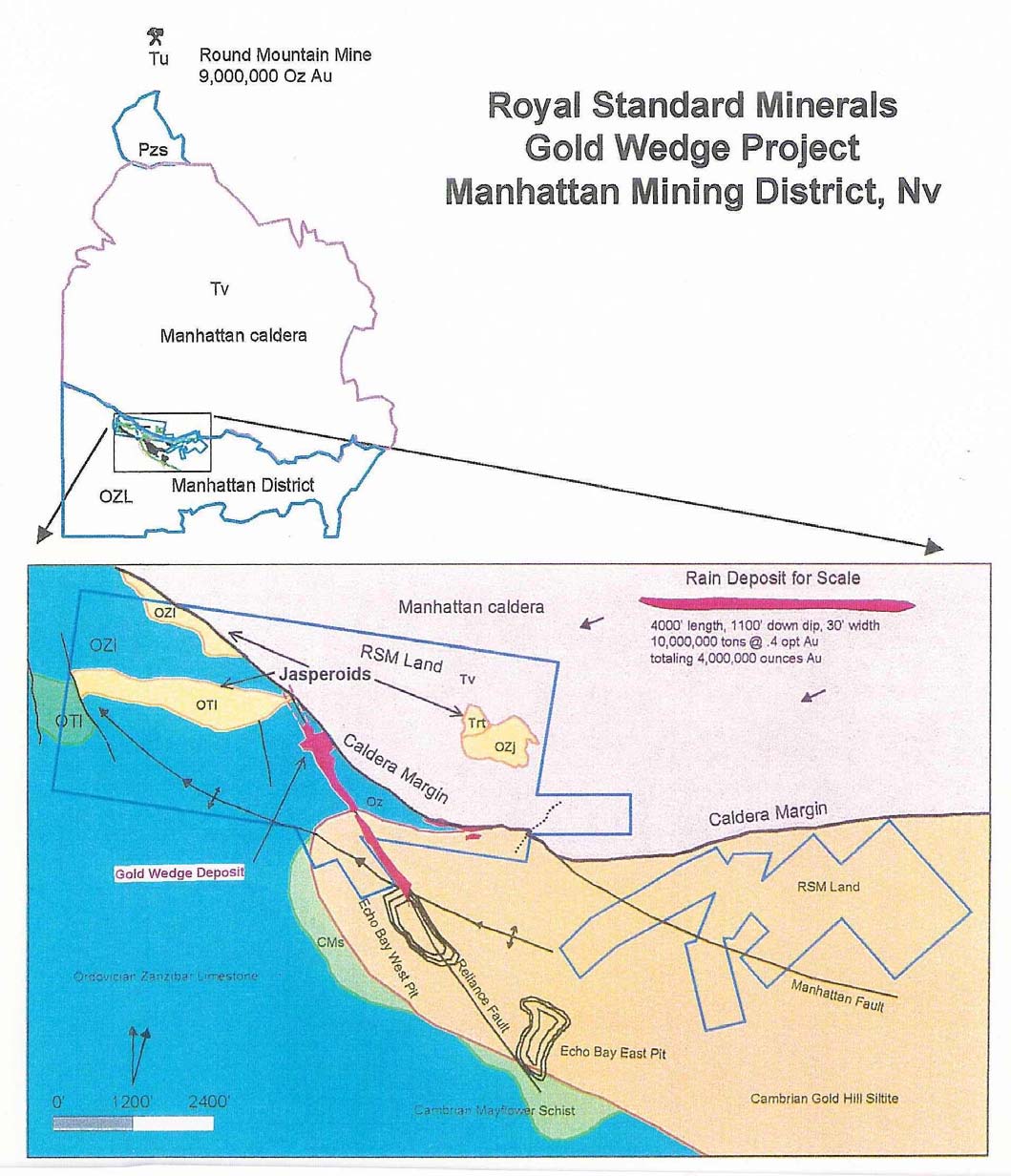
The Goldwedge deposit occurs at the intersection of north and northwest trending faults. In the deposit area, the north trending Reliance fault is mineralized within the Ordovician Zanzibar limestone and siltstone. The target mineralization occurs within multiple high angle structures over a width of between 100-200 feet primarily within the Zanzibar limestone. RSM has evaluated all of the pertinent drill data as part of a detailed inventory of the deposit geometry, size and overall grade. The current exploration model
131 suggests that the Goldwedge deposit and the extensions may contain an economically significant gold resource at depth near the contact with the Manhattan Caldera margin.
The first potential mine development program is the 100% owned Goldwedge deposit located within the Manhattan Mining District. The Goldwedge deposit is located approximately 8 miles south of the large Round Mountain gold mine. All mine and mill (plant) and water use permits were achieved in early, 2004. Also, in 2004 the Company constructed a 700 foot (underground) decline and cross cut to test one of the gold mineralized structures within a 100+ wide structural zone. Additionally, RSM completed the surface facilities necessary to process the material to be mined onsite to include silt ponds, ore pad and the onsite gold processing plant. The Company acquired a full production scale gold recovery (gravity) plant that will be utilized to process the mined material as part of the test mining program.
The underground bulk sampling and decline development program continued during 2007, although the underground effort was hampered by the effects of groundwater. A dewatering well was drilled in 2008 to reduce and control the water levels within the mine. In 2007 the treatment of lower grade mined material continued with the processing this material through an onsite (gravity) plant. The surface facilities and the gold recovery plant were completed in 2005 and modified in 2006-2007 as a means to improve gold recoveries.
During the year ending January 31, 2008, expenses on the Goldwedge project were $4,953,218 bringing total RSM expenses on this project to $11,866,061. Future expenditures are expected to be an additional $3 million over the next two years concentrating on underground development and drilling.
| Cumulative |
|---|
| from date of |
|---|
| Restated | Restated | inception of |
|---|
| For the years ending | January 31, 2008 | January 31, 2007(1) | January 31, 2006(1) | exploration phase |
|---|
| Gold Wedge Project |
|---|
| Opening balance | $6,912,843 | $2,857,531 | $1,494,980 | $0 |
|---|
| Property Acquisition costs | 93,463 | 171,376 | 184,892 | 599,862 |
|---|
| Travel | 77,588 | 77,737 | 70,862 | 290,141 |
|---|
| Mine development costs | 241,075 | 293,519 | 237,867 | 982,208 |
|---|
| Drilling | 606,223 | 53,185 | 78,790 | 884,639 |
|---|
| General exploration | 0 | 5,023 | 38,776 | 133,353 |
|---|
| Professional fees | 0 | 0 | 33,740 | 72,636 |
|---|
| Consulting | 1,146,119 | 1,377,706 | 243,297 | 3,471,045 |
|---|
| Office and general | 729,941 | 335,767 | 79,701 | 1,145,909 |
|---|
| Analysis and assays | 23,899 | 30,063 | 22,240 | 118,621 |
|---|
| Supplies, Equipment and | | | | |
|---|
| transportation | 1,389,747 | 1,171,969 | 186,254 | 2,762,848 |
|---|
| Amortization | 645,163 | 538,967 | 186,132 | 1,404,799 |
|---|
| Activity during the period | 4,953,218 | 4,055,312 | 1,362,551 | 11,866,061 |
|---|
| Closing balance | $11,866,061 | $6,912,843 | $2,857,531 | $11,866,061 |
|---|
(1) See note 2 of the Consolidated Financial Statements (Audited) for the Years ended January 31, 2008 and 2007.
The underground program has several objectives including a test mining program and the establishment of the appropriate mining methods that will be applied to the future development of the property.
The underground development as well as surface and underground drilling will be directed toward expanding the resources on this property as well as the completion and testing of the recovery plant design. The gold recovery plant has been modified to include two ball mill circuits and will include a floatation circuit.
The results of the last 12 months support further investment and a continuation of the mining and milling program for this project. The projected expenditures for the next 12 months are expected to be approximately $3 million. Funding will include approximately $2.5 million allocated to underground development and drilling as well as the continuation of the test mining and approximately $0.5 million of this funding will be allocated to an underground and surface drilling program. The balance of approximately $0.5 million will be allocated to plant modification to include the addition of another ball mill and other material handling improvements. All of this work will be supervised by the CEO and carried out by experienced miners and plant employees currently working for the Company. Consultants will be utilized in special instances to assist management with specific technical issues. Funding for this activity will come from the Company's current cash.
This project is an advanced exploration project without known reserves and the proposed program is exploratory in nature.
Pinon and Railroad Projects-Carlin Trend South
The Pinon property is located in the southeast end of the famous "Carlin Gold Trend" about 10 miles south of Newmont's Rain mine, 25 miles southwest of Elko, Nevada. The main access from Elko is west on Interstate 80 to Carlin (25 miles) then south on State Highway 51 for 22 miles to the Trout Creek access road. The project area is 7 miles east along a well-maintained BLM gravel-dirt road to the area of extensive drilling. There is no infrastructure in the vicinity of the property; the nearest power line is 7 miles to the west along State Highway 51.
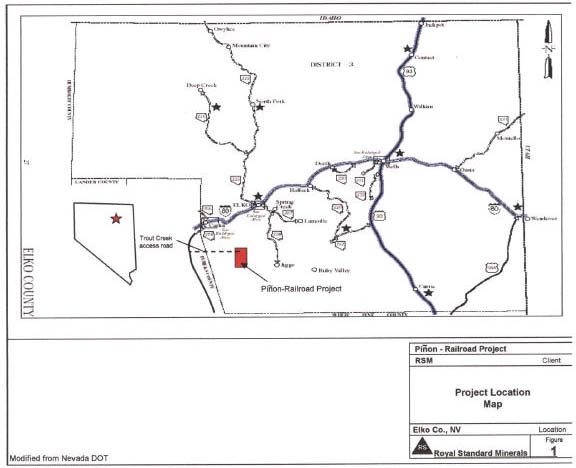
The TC claim group is under control (100%) of RSM. The TC claims are located on federal public domain lands that are managed (both surface and mineral estates) by the Bureau of Land Management ("BLM"). Initially staked in 1979, this ground was previously open to mineral location with no significant restrictions. Location certificates for all claims staked in the group were filed and recorded with the BLM and the Elko County Recorder's Office in Elko according to federal and state laws/regulations.
The TC claim group is surrounded by private fee lands containing a complicated mixture of severed surface and mineral estates that were previously controlled in part by the Pinon Joint Venture through various lease-option agreements. These lands have since been dropped by the joint venture. An ownership summary for several of the more important sections is shown below.
T30N, R53E
Section 21: All (640 acres)
Surface estate J. Tomera Ranch (100%)
Mineral estate J. Tomera family (50%)
Etcheverry family (16.7%)
Rudnick Trust (16.6%)
L&R Rudnick family (16.6%)
Section 27: NE1/4 NW1/4 , NE1/4, NE1/4 SE1/4 (640 acres)_
Surface estate Pereira Trust (100%)
Mineral estate Pereira Trust (50%)
Etcheverry family (16.67%)
O. Rudnick family (16.67%) Rudnick Trust (8.33%)
Section 27: NW1/4 NW1/4 , S1/2 NW1/4, SW1/4, NW1/4 SE1/4, S1/2 SE1/4 (640 acres)
Surface estate J. Tomera Ranch (100%)
Mineral estate J. Tomera family (50%)
Etcheverry family (16.67%)
O. Rudnick family (16.67%) Rudnick Trust (8.33%)
R. Rudnick family (8.3%)
The Pinon properties are located on the southern portion of the Carlin gold belt about 10 miles south of Newmont's Rain mine Since its inception, various joint-venture partners have spent more than $10 MM on the project.
Required Cash Project Payments to Optionors Royalty Exercise of Option
| Railroad Elko County | Commencing in fiscal 2003. $15,000 in the first year and increases by $5,000 each of the next six years | 5% NSR | August 2008 $2,000,000 |
|---|
| There are 493 Unpatented and 19 patented mining claims as follows: | |
| Patented Mining Claims |
|---|
| Parcel No. OPM-464-030 |
|---|
| NAME | ACRES |
|---|
| Standing Elk | 6.460 |
|---|
| Millsite | 4.590 |
|---|
| Cleveland | 12.730 |
|---|
| Hoffman | 8.800 |
|---|
| Hecia | 6.730 |
|---|
| Silver King | 6.520 |
|---|
| Bullion | 4.590 |
|---|
| Sky Blue | 18.870 |
|---|
| Tripoli | 4.590 |
|---|
| Tripoli East Loade | 20.080 |
|---|
| Webfoot | 5.980 |
|---|
| Mounted Lodge | 20.660 |
|---|
| Grey Eagle | |
|---|
| Blue Eagle | |
|---|
| Blue Jay | |
|---|
| Tom Boy | |
|---|
| Lucky Boy | |
|---|
| Kansas City | |
|---|
| Safety pin | 105.766 |
|---|
| TOTAL 226.366 |
|---|
| Unpatented Mining Claims | |
|---|
| NAME | BLM NMC NUMBER | NO. OF CLAIMS |
|---|
| Black | 75973 | 1 |
|---|
| Blue | 75974 | 1 |
|---|
| Burke Fraction | 75975 | 1 |
|---|
| Canary | 75976 | 1 |
|---|
| Dike No. 1-4 | 75977-75980 | 4 |
|---|
| Dike No. 6-9 | 75981-75984 | 4 |
|---|
| Dike No. 11 | 75985 | 1 |
|---|
| Eagle | 75986 | 1 |
|---|
| Gold | 75987 | 1 |
|---|
| Green | 75988 | 1 |
|---|
| Hoffman Fraction | 75989 | 1 |
|---|
| Holdup | 75990 | 1 |
|---|
| Homestake | 75991 | 1 |
|---|
| Key | 75992 | 1 |
|---|
| Lark | 75993 | 1 |
|---|
| Last Chance | 75994 | 1 |
|---|
NAME BLM NMC NUMBER NO. OF CLAIMS
Mahogany 75995 1 Mendota 75996 1 Moon 75997 1 Moon No. 1-2 75998-75999 2 Nevada 76000 1 Owl 76001 1 Pink 76002 1 Portal 76003 1 Portal Fraction 76004 1 Red 76005 1 Snowbird 76006 1 Spring 76007 1 Star 76008 1 Storm King 76009 1 Uhalde-Borne 76010 1 Uhalde-Borne North 76011 1 Selco 1-89 75884-75972 89 John 75876 1 Bardy 75877 1 Maggie 75878 1 Rob 75879 1 Hannah 75880 1 Ken 75881 1 Peter 75882 1 Pam 75883 1 B 1-5 138543-138547 5 Home 1-18 164143-164160 18 Home 19-31 190211-190223 13 Home 41-52 227247-227257 11 RR 1-39 320216-320254 39 RR 40-54 426606-426620 15 RR 55-64 486934-466943 10 CISS 1-87 407849-407935 87 CISS 106-119 407954-407967 14 CISS 124-137 407968-407981 14 LT 1-27 504170-504176 27 WRN 1-12 602701-602712 12 RF 1-8 403753-403760 8 New 56-63 202156-202163 8 New 65-72 202165-202172 8 New 135-138 227243-227246 4 Pine 1-18 407779-407796 18 Pine 58-66 407836-407844 9 RN 1-25 602676-602700 25 PIN 1-12 696494-696505 12
The Pinon and Railroad projects are located on the southern portion of the Carlin Trend immediately south of Newmont's Rain gold district. The Carlin Trend is one of the most prolific gold trends in the world and has produced more than 50 million ounces of gold. The properties are located within a well-mineralized region, which only adds to the potential for expanding the known gold deposits and making new discoveries. Much of the district wide exploration was undertaken prior to the start of the 1980's and 1990's. Since the mid-1990's the cumulative knowledge of "Carlin-type" gold deposits has expanded tremendously. This expanded knowledge can be used to re-interpret all of the available data, which may identify new exploration targets on the ground controlled by RSM. Also, during the past 10+ years numerous high-grade gold deposits have been discovered along the Carlin Trend that can be mined using underground techniques. Many of these deeper deposits are associated with surface oxidized gold deposits. Essentially no deeper exploration has been conducted under the Pinon and Railroad deposits, or at other places on the property. The exploration opportunity offers the possibility for discovery of additional gold deposits at Pinon-Railroad.
The Railroad project increased the property position within the district to approximately 10,500 acres of leases and includes unpatented and patented mining claims. This effort included the acquisition of nearly 500 unpatented and 19 patented mining claims that lie south of Newmont's Mining's Rain district in Elko County, Nevada.
The Webb Formation is mineralized above the Devils Gate limestone at both deposits. At Rain, the mineralization occurs within and closely associated with the Rain Fault. On the southern portion of the property position, the Pinon Au-Ag project, the known mineralization has not been connected to a strongly mineralized fault. However, higher-grade economic mineralization has been encountered at very shallow depths, mineralized oxide zones occur along a 1,300 feet strike length and occur less than 90 feet below the surface.
The Pinon and Railroad projects include approximately 17,000 acres comprising unpatented BLM lode mining claims, patents and leased fee lands. The focus of RSM's current effort is to identify and develop near surface oxide gold-silver deposits. Approximately 600 shallow drill holes have been completed on 6 near surface gold-silver deposits. The depth extensions of these deposits are not well understood, as deeper drilling has not been sufficient to develop an acceptable understanding of this mineralization.
The Company has developed the necessary construction plans for the Pinon-Railroad project including surface, heap leach facilities design and open pit modeling of the deposits. The 2004-2006 program involved work on the BLM permit application. All of this work has been completed in preparation for the filing of a mining permit application with the US Bureau of Mines (BLM) by year-end 2009. A second objective is to continue with the exploration drilling of the Railroad copper target and to further test the potential of expanding the gold system on the property.
Total exploration expenditures on this project have exceeded $10 million and an additional $20 million will be required to develop a 5,000 ton per day heap leach operation on this project. As of January 31, 2008, RSM and its partners have spent approximately $3.5 million on the Pinon and Railroad projects. Plans include the achievement of a mining permit in 2007 followed project financing. Following is a detailed table of RSM's expenditures.
Cumulative
from date of |
|---|
| Restated | Restated | inception of |
|---|
| For the years ending | January 31, 2008 | January 31, 2007(1) | January 31, 2006(1) | exploration phase |
|---|
| Pinon Project |
|---|
| Opening balance | $1,148,259 | $762,285 | $600,538 | $0 |
|---|
| Property Acquisition costs | 19,017 | 34,047 | 40,258 | 444,587 |
|---|
| Travel | 14,978 | 0 | 801 | 26,828 |
|---|
| Drilling | 0 | 8,333 | 72,780 | 130,600 |
|---|
| General exploration | 0 | 0 | 0 | 7,765 |
|---|
| Professional fees | 0 | 0 | 0 | 66,273 |
|---|
| Office and general | 54,413 | 15,296 | 2,698 | 98,120 |
|---|
| Geologist | 0 | 0 | 25,008 | 32,653 |
|---|
| Consulting | 207,590 | 151,133 | 19,537 | 402,492 |
|---|
| Reclamation costs | 0 | 167,785 | 0 | 167,785 |
|---|
| Analysis and assays | 7,171 | 9,380 | 382 | 74,042 |
|---|
| Supplies, Equipment and | | | | |
|---|
| transportation | 0 | 0 | 283 | 283 |
|---|
| Activity during the period | 303,169 | 385,974 | 161,747 | 1,451,428 |
|---|
| Closing balance | $1,451,428 | $1,148,259 | $762,285 | $1,451,428 |
|---|
| Railroad Project | | | | |
|---|
| Opening balance | $215,813 | $175,670 | $175,670 | $0 |
|---|
| Property Acquisition costs | 115,633 | 40,143 | 0 | 331,446 |
|---|
| Activity during the period | 115,633 | 40,143 | 0 | 331,446 |
|---|
| Closing balance | $331,446 | $215,813 | $175,670 | $331,446 |
|---|
(1) See note 2 of the Consolidated Financial Statements (Audited) for the Years ended January 31, 2008 and 2007.
The Pinon gold-silver project has been intensively explored with more than 300 drill holes in this Carlin-type surface bulk mineable target. In 2007, the Company completed drilling of the deposits for environmental data and completed drilling for similar information on the proposed leach pad. These data will be included in various state and federal applications toward achieving a mining permit for this project. The cost in 2007 was approximately $200,000 for this drilling program. Engineering and analytical costs including report preparation is expected to be an additional $100,000 this calendar year. Consulting environmental engineering, Dyer and Associates of Sparks, Nevada are completing the environmental reports. If more site work is required additional capital will have to be utilized to collect additional data.
In regard to the Railroad project, the Company expects to continue with the surface drilling program on the Copper-Molybdenum-precious metal target utilizing the one-two Company owned core drilling rigs. A total of five 5 core drill holes were completed on this project in 2007 at a cost of approximately $175,000. Experienced drillers are employed by the Company to operate our own drill rigs. Plans for this program in 2008 will include the continuation of this drilling program at a cost not to exceed $350,000.
The funding for these programs will come from the Company's current cash on its balance sheet.
The property is without known reserves and the proposed program is exploratory in nature.
Fondaway Canyon Project
The 100% controlled Fondaway Canyon gold project is located in Churchill County, Nevada in the Stillwater range. The Fondaway property is accessible from Fallon east along U.S. Highway 50, then north on Hwy 116 to the settlement of Stillwater, then north on an improved gravel road for 30 miles along the front range of the Stillwater Mountains to Fondaway Canyon. The elevation of the property ranges from 5000 to 6000 feet. Access east into Fondaway Canyon is steep but adequate with existing mine roads. The Fondaway deposit is located on the west flank of the Stillwater Range in Sections 1 and 2, T22N, R33E, and Sections 5 and 6, T22N, R34E.
Sierra Pacific Power Co exists on the property. RSM has the current water rights to the property.
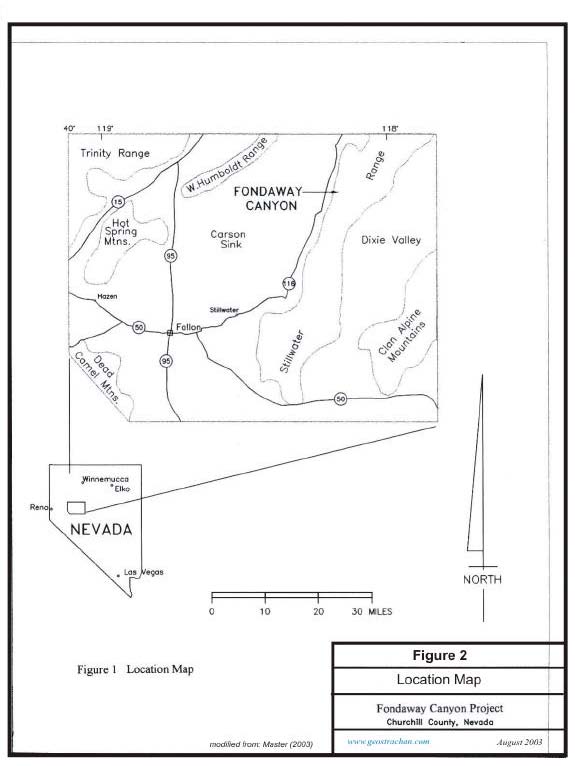
The Fondaway Canyon property consists of 148 contiguous unpatented lode-mining claims (approximately 3000 acres) on BLM land held under a lease agreement assigned from Nevada Contact Inc. (NCI) to Royal Standard Minerals Inc. (RSM). Eighteen claims were staked NCI, quitclaimed to the owner, and included in the assignment to RSM. The lease terms include a 3% net smelter return royalty to the owner Richard Fisk and advanced royalty payments of $25,000 per year. The annual payments graduate to $35,000 in 2006 and years following. Details of the option agreement are as follows:
| Required Cash Payments to Optionors | Royalty | Exercise of Option |
| Commencing in fiscal 2003. $25,000 in year one, $30,000 in years two and three and $35,000 each of the next seven years |
3% NSR |
July 2013
$600,000 |
All of the maintenance filing fees are current and in good standing.
Nearly-vertical, east-west trending mineralized shear zones host the Half Moon, Paperweight, Hamburger Hill and South Pit gold resources that is hosted within a Mesozoic sedimentary package. The Mesozoic sedimentary package has been intruded by a Mesozoic-Tertiary aged intrusive.
The vertical extent tested by recent drilling of the higher grade gold mineralized shear zones is greater than 1,000 feet. Horizontal continuation of gold mineralization as at the Paperweight and Hamburger Hill mineralized shear zone is 3,700 feet with widths commonly between 5'-20+ feet. Drilling and assay records indicate that 568 holes have been drilled for a total estimated footage of 200,000 feet of RC drilling and 22,000 feet of core drilling to include 455 reverse circulation, 49 core holes and 64 air track holes over a strike length of approximately 12,000 feet. Tenneco Minerals Inc., the most active company, drilled approximately 350 holes (130,000 feet) and drove a 500' adit for sulfide metallurgical sampling during the period 1987-1996. Tenneco also operated a small oxide gold open pit mine for a short time during this period. Nevada Contact Inc. (NCI) acquired the property in 2001 and drilled 11 reverse circulation holes, RSM acquired the property from NCI in early 2003 as part of a property swap with NCI retaining a 1% NSR overriding royalty in the Fondaway Canyon property and $25,000 advance minimum royalty payments to the claim holder until 2006 at which time the payments increase to $35,000 per year that includes a 3% NSR royalty until buyout. There is a buyout option of $600,000 for the owners' interest.
Drill testing of the Tenneco leach pad was unsuccessful. RSM plans are to further drill test the sulfide resource as part of a program to upgrade the indicated and inferred resources on the property. This effort will involve drilling underground within the Tenneco adit along with a surface drilling program. A bulk sampling program for metallurgical analysis of the sulfide resource will also be included as part of an effort to develop a gold recovery process that will achieve the desired results. This effort is subject to achieving the necessary state of Nevada permits.
Estimates of prior expenditures on this property are approximately $5-6 million. The largest portion of these expenditures was contributed by Tenneco Minerals and Tundra Mines LTD. This work included extensive drilling, development of a small open pit production project and an advanced exploration adit on the property. As of January 31, 2008, RSM has spent $162,778 on this project. A table of detailed expenditures follows:
| Cumulative |
|---|
| from date of |
|---|
Restated | Restated | inception of |
|---|
January 31, | January 31, | January 31, | exploration |
|---|
| For the years ending | 2008 | 2007(1) | 2006(1) | phase |
|---|
| Fondaway Project | | | | |
|---|
| Opening balance | $162,778 | $127,652 | $96,028 | $0 |
|---|
| Property Acquisition costs | 64,754 | 35,126 | 31,624 | 227,181 |
|---|
| Travel | 3,279 | 0 | 0 | 3,279 |
|---|
| Drilling | 15,646 | 0 | 0 | 15,646 |
|---|
| Analysis and assays | 0 | 0 | 0 | 351 |
|---|
| Activity during the period |
83,679 |
35,126 |
31,624 |
246,457 |
|---|
| Closing balance | $246,457 | $162,778 | $127,652 | $246,457 |
|---|
(1) See note 2 of the Consolidated Financial Statements (Audited) for the Years ended January 31, 2008 and 2007.
Project expenditures included a small sonic drilling program to test the Tenneco Minerals leach pad on this property. In 2008 the only program will include the completion of a ground magnetics survey of the entire property at a projected cost of approximately $50,000. These data will be utilized to plan a program of further drilling, possibly in 2009. This work will be completed by our employee, an experienced geophysicist. Funding will come from the cash on hand.
The property is without known reserves and the proposed program is exploratory in nature.
Manhattan/Round Mountain Caldera Program
The project area is located southeast of the town of Round Mountain, Nevada east of State route 376. The town of Manhattan is located approximately 15 miles south of Round Mountain. The Manhattan project is located approximately 7 miles east of route 376 on route 377 and 1.5 miles west of the town of Manhattan.
The Manhattan/Round Mountain Caldera program is the Company's most advanced district play includes the Goldwedge advanced exploration program. The land position in the Manhattan Mining District is comprised of 70 unpatented and 3 patented lode-mining claims. An underground development program to include drill testing the extensions of the Goldwedge deposit in addition to the evaluation of several additional lode and placer properties that the Company controls in the district could significantly increase the gold resource estimates. Details of the option agreement are as follows:
On June 29, 2005 the Company entered into a 5-year Purchase Option Agreement with a private individual for all of his patented and unpatented mining claims in the Manhattan Mining District located in Nye County, Nevada. The land package totals approximately 1600 acres (4 patented, 70 unpatented claims). This property position adjoins the Company's Goldwedge Mine. The land package includes a number of exploration targets which are of interest to the Company. In addition, the Company's option includes the Dixie Comstock claim group located in Churchill County, Nevada. The Dixie Comstock is a 1500 acre property containing an epithermal gold system that has been explored by a number of major mining companies over the past 20 years. It is considered to be an attractive advanced exploration project. The Company is currently engaged in the completion of a 43-101 property report. The Company has agreed to pay $35,000 upon the execution of the Agreement. Annual option payments of $48,000 are to be applied to a total purchase price of $600,000 - there are no royalties.
Freeport Gold, Tenneco (Echo Bay) recognized the potential of the district (to include the Goldwedge deposit that is currently under control by RSM) however, these deposits were not suited for open pit mining. At that time the large mining companies did not consider the underground development projects feasible. Although Sunshine Mining Co. considered an underground mine development in 1988 on the Goldwedge deposit, continued exploration by Crown Resources and others on the Company's claims indicated sections (5+'-30') of potentially mineable grades greater than 0.5 opt gold. The continued downturn in the gold market, tightened corporate budgets and high holding costs for the properties forced many companies to turn back the land positions to the claim owners. Currently, the Company controls approximately 4,000 feet of strike length. Approximately 1,000-1,200 feet of this strike length has been drill tested indicating positive results.
Expenses to date by Royal Standard are as follows:
| Cumulative |
|---|
| from date of |
|---|
Restated | Restated | inception of |
|---|
January 31, | January 31, | January 31, | exploration |
|---|
| For the years ending | 2008 | 2007(1) | 2006(1) | phase |
|---|
| Manhattan Project | | | | |
|---|
| Opening balance | $0 | $0 | $191,065 | $0 |
|---|
| Property Acquisition costs | 0 | 0 | 0 | 27,707 |
|---|
| Travel | 0 | 0 | 0 | 28,253 |
|---|
| General Exploration | 0 | 0 | 1,458 | 63,219 |
|---|
| Consulting | 0 | 0 | 0 | 47,743 |
|---|
| Analysis and assays | 0 | 0 | 0 | 25,601 |
|---|
| Written off | 0 | 0 | (192,523) | (192,523) |
|---|
| Activity during the period | 0 | 0 | (191,065) | 0 |
|---|
| Closing balance | $0 | $0 | $0 | $0 |
|---|
(1) See note 2 of the Consolidated Financial Statements (Audited) for the Years ended January 31, 2008 and 2007.
The Company does not plan to complete any exploration program on this property in 2008.
The property is without known reserves and the proposed program is exploratory in nature.
Item 5. Operating and Financial Review and Prospects
A. Operating results.
Royal Standard is an exploration and pre-development stage enterprise and is in the process of exploring its resource properties and has not determined whether the properties contain economically recoverable reserves. The recovery of the amounts shown for the resource properties and the related deferred expenditures is dependent upon the existence of economically recoverable reserves, confirmation of the Company's interest in the underlying mineral claims, the ability of the Company to obtain necessary financing to complete the exploration and, upon future profitable production.
Royal Standard is an exploration-pre-development stage enterprise and, as such, currently has no producing properties and no operating income or cash flow, other than interest earned on funds invested in short-term deposits (see Item 3.D. - Key Information - Risk Factors).
Year Ended January 31, 2008 Compared to the Year Ended January 31, 2007
The net loss for the year ending January 31, 2008 was $2,019,479 as compared to the net loss of $4,511,483 for the year ending January 31, 2007. The decrease of $2,492,004 is principally the result of Stock Option Compensation of $853,953 for the year ending January 31, 2008 as compared to $3,838,926 for the year ending January 31, 2007.
General and administrative expenses increased from $618,962 for the year ending January 31, 2007 to $872,321 for the year ending January 31, 2008 an increase of $253,359 of which $157,472 was caused by increases in professional fees, the major portion of which were related to the settled litigation described in Note 14 of the consolidated financial statements as of January 31, 2008. The other increases are a direct result of continued activity on the Company's mineral projects. Consulting, wages and salaries increased from $443,693 for the year ending January 31, 2007 to $482,123 for the year ending January 31, 2008, an increase of $38,430.
During the period ended January 31, 2008, the Company changed its accounting policy with regards to the amortization of its exploration equipment. In prior years, the Company recorded such amortization as an operating expense. As the Company is still in the exploration stage, the Company's management determined that it would be more appropriate to defer the amortization of the exploration equipment until the Company ceases to be in the exploration stage and enters the production stage. The effect of this change on the January 31, 2007 year-end balance sheet is an increase in mineral properties by $759,636 and a corresponding decrease in the accumulated deficit by the same amount. The effect of this change on the net loss and the accumulated deficit for the years ended January 31, 2007 and 2006 is a decrease of $538,967 and $186,132 respectively and a corresponding increase in mineral properties. The opening accumulated deficit for the years ended January 31, 2007 and 2006 decreased by $220,669 and $34,537 respectively and a corresponding increase in opening balance in mineral properties.
Year Ended January 31, 2007 Compared to the Year Ended January 31, 2006
The net loss for the year ending January 31, 2007 was $5,431,480 as compared to the net loss of $1,611,057 for the year ending January 31, 2006. The difference of $3,820,423 is principally the result of compensation expense resulting from stock options granted to officers, directors and a consultant during the current year in the amount of $3,838,926 versus $739,006 in the prior year for an increase of $3,099,920.
General and Administrative expenses increased from $266,505 for the year ended January 31, 2006 to $618,962 for the year ended January 31, 2007. The increase of $352,457 is mainly the result of Professional Fees which increased by $221,269, Corporate Development Expense which increased by $57,618 and Advertising Expense which increased by $45,539. Amortization increased from $191,877 in 2006 to $540,289 in 2007, for an increase of $348,412, and consulting fees which increased from $295,707 for the year ended January 31, 2006 to $443,693 for the year ending January 31, 2007, for an increase of $147,986. All increases are a direct result of increased activity on the Company's mineral projects.
Offsetting the aforementioned increases in expenses is interest income of $391,420 for the year ended January 31, 2007 versus none for the same period in 2006. In addition, the Company wrote off exploration properties amounting to $367,467 during the year ending January 31, 2006 versus none for the year ending January 31, 2007.
Year Ended January 31, 2006 Compared to the Year Ended January 31, 2005
The net loss for the year ending January 31, 2006 was $1,611,057 as compared to $475,409 for the year ending January 31, 2005, a difference of $1,135,648. The majority of this difference is a result of stock-option compensation which increased from $150,606 in 2005 to $739,006 in 2006. During fiscal 2006 2,380,000 options were granted to employees and directors of the company, 200,000 were exercised and 695,000 were cancelled or expired (see note 9 of the January 31, 2006 audited financial statements for details).
Also contributing to the increased loss were write-offs of exploration properties totaling $367,467. During the year the Company wrote-off $192,523 of exploration expenditures relating to the Manhattan, Nye County project and $174,944 relating to smaller projects that the Company was evaluating.
General and Administrative expenses increased from $193,287 for the year ending January 31, 2005 to $266,505 for the year ending January 31, 2006. Consulting fees increased from $213,504 for the year ending January 31, 2005 to $295,707 for the year ending January 31, 2006. These increases are a direct result of increased activity on the Company's mineral projects.
Year Ended January 31, 2005 Compared to the Year Ended January 31, 2004
The net loss for the year ended January 31, 2005 was $475,409 as compared to $554,626 for the year ended January 31, 2004. General and Administrative expenses and Consulting fees decreased by a total of $103,832. However, Stock Option Compensation increased by $110,266 resulting in little change in total Expenses. Expenses were $578,632 for the year ended January 31, 2005 as compared to $565,907 for the year ended January 31 2004. The increase in Stock Option Compensation is attributed to the granting of 775,000 stock options to employees and directors of the Company on May 4, 2004.
The Corporation owns 100% interest in five (5) projects in four (4) gold-silver districts in Nevada. These projects include the Gold Wedge, Nye County, Pinon and Railroad Projects, Elko County, Fondaway Canyon, Churchill County and Como, Lyon County, Nevada.
The Gold Wedge project represents the most advanced project located in the Manhattan district about eight (8) miles south of the Round Mountain mine and has been issued a mine and mill permit by the Nevada Department of Environmental Protection (NDEP). In March, 2004 the Company completed a $2.2 CDN million private placement. These funds were directed toward the construction of a 700 foot (underground) decline and cross cut to test one of the gold mineralized structures within a 100+ wide structural zone. Additionally, RSM completed the surface facilities necessary to process the material to be mined onsite to include silt ponds, ore pad and the onsite gold processing plant. The Company acquired a full production scale gold recovery (gravity) plant that will be utilized to process the mined material as part of the test mining program.
Nevada Projects In fiscal 2003 and 2002, the Company entered into certain option agreements to purchase up to 100% interest in patented and unpatented lode-mining claims in Nye, Elko and Lyon Counties, Nevada. Details of the option agreements are as follows:
| Project Gold Wedge Nye County | Required Cash Payments to Optionors Commencing in fiscal 2002. $5,000 each in first two years; $10,000 in third year; $15,000 in fourth year and $20,000 in fifth and sixth years | Royalty(1) 3% NSR | Exercise of Option July 2006 $200,000 |
| Manhattan Nye County Project | Commencing in fiscal 2002. $1,000 per month from August 2001 to August 2002; $2,000 per month from September 2002 to July, 2006 Required Cash Payments to Optionors | 5% NSR Royalty(1) | August 2006 $500,000 Exercise of Option |
| Fondaway Canyon Churchill County | Commencing in fiscal 2003. $25,000 in year one, $30,000 in years two and three and $35,000 each of the next seven | 3% NSR | July 2013 $600,000 |
| years | | |
| Como Lyon County | Commencing in fiscal 2003. $25,000in years one and two covering years three and four, $20,000 in year five, $25,000 in year six | 4% NSR | May 2008 $1,000,000 |
| Railroad | Commencing in fiscal 2003. | 5% NSR | August 2008 |
| Elko County | $15,000 in the first year and | | $2,000,000 |
| increases by $5,000 each of the | | |
| next six years | | |
(1) NSR - Net Smelter Royalty
Gold Wedge Project
On June 29, 2005 the Company entered into a 5-year purchase option agreement with a private individual for all of his patented and unpatented mining claims in the Manhattan Mining District located in Nye County, Nevada. The land package totals approximately 1600 acres (4 patented, 70 unpatented claims). This property position adjoins the Company's Goldwedge Mine. The land package includes a number of exploration targets which are of interest to the Company. In addition, the Company's option includes the Dixie-Comstock claim group located in Churchill County, Nevada. The Dixie Comstock is a 1500 acre property containing an epithermal gold system that has been explored by a number of major mining companies over the past 20 years. It is considered to be an attractive advanced exploration project. The Company has yet to complete a 43-101 property report. The Company agrees to pay $35,000 upon the execution of the Agreement. Annual option payments of $48,000 are to be applied to a total purchase price of $600,000 - there are no royalties.
The Company has recorded an asset retirement obligation on its Gold Wedge Project, representing the estimated costs of the Company's obligation to restore the Gold Wedge properties to their original condition as required by the State of Nevada regulatory authorities. At the present time, the Company cannot reasonably estimate the fair value of these costs. As such, the Company has recorded an asset retirement obligation in the amount of $181,767, the amount of the reclamation bond posted by the Company with the State of Nevada.
Como Project
On September 15, 2004, the Company granted an option (the "Option") to Sharpe Resources Corporation ("Sharpe") to acquire a 60% interest in the Company's gold project located in Lyon County, Nevada (the "Project"), in consideration for which Sharpe has issued 2,000,000 common shares to the Company at a deemed value of $78,125 ($100,000 CDN). To exercise the option, Sharpe must maintain the unpatented and patented mining claims on the Project, must pay all required options, annual advanced minimum royalty payments and deliver a completed positive feasibility study in compliance with National Instrument 43-101 in respect of the Project.
On December 5, 2006, Sharpe withdrew from this project without any further financial obligations. Subsequent to the year ending January 31, 2008, the Company decided not to pursue the exploration of this project and to write off all accumulated deferred exploration costs.
Pinon Project - Cord Lease
In August 2002, the Company entered into a mining lease agreement to lease certain properties located in Elko County, Nevada for a period of five years. The lessors will retain a 5% net smelter royalty with no option to purchase. These properties are to be extended in 2007. In 2006 RSM leased section 25 and 13 from the Periera Trust. The Dark Star gold-silver resources lie within Section 25. Additionally, in 2007 RSM was able to lease portions of sections 27, 15, and 23 that it previously did not control.
Pinon Project - Tomera Lease
In August 2002, the Company entered into a mining lease agreement to lease certain properties located in Elko County, Nevada for a period of seven years. The lessor will retain a 5% net smelter royalty.
In addition, the Company entered into an irrevocable lease agreement with the surface and minerals rights owners of the Pinon Project properties.
Other Projects
During 2006, the Company wrote-off $192,523 of exploration expenditures relating to the Manhattan, Nye County project and $174,944 relating to smaller projects that the Company was evaluating. Exploration expenditures written-off during fiscal 2006 amounted to $367,467. No expenditures were written off during fiscal 2007.
The Company signed an Exploration and Option Agreement with Metallic Ventures ("Metallic") to explore the Mustang Canyon Project in Esmeralda County, Nevada. The agreement gives the Company the exclusive option to acquire 50% interest in the Mustang Canyon Project by spending $20,000 per year in exploration expenditures with the objective to identify a measured resource by June 30, 2010. Upon identification of a measured resource and completion of a 43-101 report, the Company will earn a 50% interest in the project. The Company may terminate the Agreement at any time after spending the initial $20,000 by providing 30 days written notice to Metallic. When the Company has exercised its option to acquire a 50% interest in the project, Metallic and the Company will establish a Joint Venture in respect to the project, on a 50/50 basis. Further expenditures on the Mustang Canyon Project will then be made by the Joint Venture. The Company will be the operator of the joint venture as long as it has at least a 50% interest in the joint venture.
B. Liquidity and capital resources.
Year Ended January 31, 2008 Compared to the Year Ended January 31, 2007
The Company's Cash and cash equivalents balance as of January 31, 2008 was $7,209,173 compared to $9,654,288 at January 31, 2007, a decrease of $2,445,115. The Company also had $117,761 in short term investments at January 31, 2008, as compared to $433,699 at January 31, 2007, a decrease of $315,938.
On April 27, 2006, the Company completed a private placement of 12,975,967 units of the Company at $1.15 CDN per unit raising gross proceeds of $13,286,762 ($14,922,362 CDN). Each unit consisted of one common share of the Company and one-half of one common share purchase warrant. Each whole common share purchase warrant is exercisable at $1.75 CDN into one common share of the Company until April 26, 2008. The fair value of the common share purchase warrants was estimated, on the date of closing, using the Black-Scholes option pricing model, with the following assumptions: dividend yield 0%, expected volatility of 98%, risk-free interest rate of 4.13% and an expected life of 24 months. The value assigned to the warrants is $2,847,058 ($3,198,582 CDN).
Current assets as at January 31, 2008 were $8,006,287 as compared to $10,438,324 at January 31, 2007. Mineral properties at January 31, 2008 were $13,895,392 compared to $8,547,743 at January 31, 2007 which represents an increase of $5,347,649, primarily reflecting the increased investment at the Company's Gold Wedge project. Equipment decreased from $2,056,392 at January 31, 2007 to $1,483,690 at January 31, 2008, primarily as a result of amortization. Total assets as at January 31, 2008 were $23,588,555 as compared to $21,224,226 at January 31, 2007. This represents an increase of $2,364,329 and is principally due to proceeds received from the exercise of stock options and warrants.
Current liabilities as at January 31, 2008 were $220,737 compared to $202,157 at January 31, 2007, and represent current trade payables.
Management believes that, subject to the achievement of significant revenue producing operations, equity and debt financings will remain the single major source of cash flow for the Corporation. However, there is no assurance that the Company can successfully obtain such financings in future periods.
Year Ended January 31, 2007 Compared to the Year Ended January 31, 2006
The Company's cash and cash equivalents balance as of January 31, 2007 was $9,654,288 compared to $795,095 at January 31, 2006, an increase of $8,859,193. The increase is attributable to the private placement offerings completed during the first quarter of 2006. The Company also had $433,699 in short term investments at January 31, 2007, compared to $436,378 in 2006.
On April 27, 2006, the Company completed a private placement of 12,975,967 units of the Company at $1.15 CDN per unit raising gross proceeds of $13,286,762 ($14,922,362 CDN). Each unit consists of one common share of the Company and one-half of one common share purchase warrant. Each whole common share purchase warrant is exercisable at $1.75 CDN into one common share of the Company until April 26, 2008. The fair value of the common share purchase warrants was estimated, on the date of closing, using the Black-Scholes option pricing model, with the following assumptions: dividend yield 0%, expected volatility of 98%, risk-free interest rate of 4.13% and an expected life of 24 months. The value assigned to the warrants is $2,847,058 ($3,198,582 CDN).
Current assets as at January 31, 2007 were $10,438,324 as compared to $1,445,200 at January 31, 2006. Exploration properties at January 31, 2007 were $7,788,107 compared to $3,810,519 at January 31, 2006 and represent an increase of $3,977,588. Equipment increased from $1,258,994 at January 31, 2006 to $2,056,392 at January 31, 2007 resulting in an increase of $797,398, net of amortization. Both increases are the result of continued construction at the Gold Wedge Project. Total assets as at January 31, 2007 were $20,464,590 as compared to $6,646,480 at January 31, 2006. This represents an increase of $13,818,110 and is due primarily to cash remaining from the aforementioned private placement offerings and continued operations on the Gold Wedge project.
Current liabilities as at January 31, 2007 were $202,157 compared to $221,733 at January 31, 2006, and represent current trade payables.
Year Ended January 31, 2006 Compared to the Year Ended January 31, 2005
The Company's cash balance as of January 31, 2006 was $795,095 compared to $392,697 at January 31, 2005. The Company also had $436,378 (market value) in short term investments at January 31, 2006 compared to $0 in 2005. The increases are attributable to the private placement offerings completed during the first two quarters of 2005.
On March 31, 2005 the Company completed the first round of a private placement by issuing 8,750,000 units at a price of $0.35 CDN for gross proceeds of $2,531,829 ($3,062,500 CDN). Each unit consisted of one common share and one-half common share purchase warrant. Each whole warrant will entitle the holder to subscribe for one additional share at a price of $0.50 CDN until March 31, 2007.
In addition, the agent for the offering, as partial compensation for its services, received 82,000 common shares and 1,353,500 warrants. Each warrant entitles the agent to acquire one additional common share of the Company at an exercise price of $0.50 CDN until March 31, 2007.
A second round of the financing was completed on April 26, 2005, whereby 1,500,000 units were issued at a price of $0.35 CDN for gross proceeds of $426,615 ($525,000 CDN). Each unit consists of one common share and one-half common share purchase warrant. Each whole warrant entitles the holder to subscribe for one additional share of the Company's common stock at a price of $0.50 CDN per share until April 26, 2007.
As partial compensation for their services, the agents for this financing received 45,000 common shares and 247,500 warrants. Each warrant entitles the agents to acquire one additional common share of the Company at an exercise price of $0.50 CDN until April 26, 2007.
On April 29, 2005, the Company issued 50,000 units at a price of $0.35 CDN per unit for gross proceeds of $14,296 ($17,500 CDN). Each unit consists of one common share and one-half common share purchase warrant. Each whole warrant entitled the holder to subscribe for one additional share of common stock at a price of $0.50 CDN per share until April 29, 2007.
On May 5, 2005, the Company completed the third and final round of private placements by issuing 1,831,000 units at a price of $0.35 CDN for gross proceeds of $495,808 ($640,850 CDN). Each unit consists of one common share and one-half common share purchase warrant. Each whole warrant entitled the holder to subscribe for one additional share of common stock at a price of $0.50 CDN per share until May 5, 2007.
Current assets as at January 31, 2006 were $1,445,200. Total assets as at January 31, 2006 were $6,646,480 as compared to $3,375,464 at January 31, 2005. This represents an increase of $3,271,016 due to the increased financing activity. Exploration properties at January 31, 2006 were $3,810,519 compared to $2,664,127 at January 31, 2005. This represents an increase of $1,146,392 resulting from continued construction at the Gold Wedge Project.
Current liabilities as at January 31, 2006 were $221,733 compared to $104,087 at January 31, 2005, and represent current trade payables.
Year Ended January 31, 2005 Compared to the Year Ended January 31, 2004
The Company's cash balance as of January 31, 2005 was $392,697 compared to $189,732 at January 31, 2004. The increase in the cash balance is attributable to the private placement offerings completed during the fiscal year 2004. On February 3, 2004, the Company closed a private placement offering of 1,075,000 units at a price of $0.25 CDN per unit for gross proceeds of $268,750 CDN. Each unit consisted of one common share and one-half common share purchase warrant. Each whole purchase warrant entitled the holder to subscribe for one additional common share at a price of $0.30 CDN until February 2, 2005.
On April 16, 2004, the Company closed a private placement offering o 6,320,000 units at a price of $0.35 CDN per unit for gross proceeds of $2,212,000 CDN. Each unit consisted of one common share and one-half common share purchase warrant. Each whole purchase warrant entitles the holder to subscribe for one additional common share at a price of $0.50 CDN until April 15, 2006.
Current assets as at January 31, 2005 were $541,835. Total assets as at January 31, 2005 were $3,237,383 as compared to $1,579,391 at January 31, 2004. This represents an increase of $1,657,992 from 2004 due to the increased activity on the Company's projects, particularly at the Gold Wedge Project where the Company completed construction of a 700 foot (underground) decline and cross cut. Additionally, RSM completed the surface facilities necessary to process the material to be mined onsite including silt ponds, ore pad and the onsite gold processing plant. Additionally, the Company acquired a full production scale gold recovery (gravity) plant that will be utilized to process the mined material as part of the test mining program.
Current liabilities as at January 31, 2005 were $104,087 compared to $106,178 in 2004, and represent current trade payables.
On a forward going basis equity and debt financings will remain the single major source of cash flow for the Company. The primary reason is that current production cash flow is insufficient to allow the Company to grow at a rate to increase the necessary production capacity to achieve profitability in the near term. As revenue from operations improve the capital requirement of the Company will also improve. However, debt and equity financings will continue to be a source of capital to expand the Corporation's activities in the future.
The Company is authorized to issue an unlimited number of Common Shares of which 43,143,518 are outstanding as at January 31, 2005. As at January 31, 2005 the Corporation had outstanding options to purchase 4,185,000 common shares with exercise prices from $0.17-0.40 per share and expiration dates ranging from May 2005 to May 2009.
Due to the nature of the Company's mining business, the acquisition, exploration, and, if warranted, the development of mining properties requires significant expenditures prior to achieving commercial production. Royal Standard will seek to finance such expenditures through the sale of equity, joint venture arrangements with other mining companies or the sale of interests in its properties. There can be no assurance, however, that the Company will be successful in raising capital on acceptable terms or in amounts sufficient to finance exploration expenditures and/or satisfy its commitments under its agreements with third parties. In the event that the Company does not raise capital as planned, it will forfeit its rights to the properties, including the sums expended through the dates of such forfeitures. See Item 3.D. - Key Information - Risk Factors.
C. Research and development, patents and licenses, etc.
See Items 4.B, 4D, and 5.A. above.
D. Trend information.
See Items 4.B. and 5.A. above.
E. Off balance sheet arrangements.
None
F. Tabular disclosures of contractual obligations.
More
Contractual
Obligations | Total | Less Than 1 Year | 1-3 Years | 3-5 Years | Than 5 Years |
| Asset Retirement | | | | | |
| Obligation (1) | $203,186 | | | | $203,186 |
(1) The Company is required to recognize a liability for a legal obligation to perform asset retirement activities, including decommissioning, reclamation and environmental monitoring activities once any of its projects are permanently closed. Although these activities are conditional upon future events, the Company is required to make a reasonable estimate of the fair value of the liability. Based on the existing level of terrestrial disturbance and water treatment and monitoring requirements, the undiscounted asset retirement obligation ("ARO's") were estimated to be $203,186 as at January 31, 2008, assuming payments made over a five year period.
Determination of the undiscounted ARO and the timing of these obligations were based on internal estimates using information currently available, existing regulations, and estimates of closure costs.
G. Safe harbor.
Not applicable.
Item 6. Directors, Senior Management and Employees
A. Directors and senior management.
The following table sets out the names of and related information concerning each of the officers and directors of Royal Standard.
| NAME | OFFICE HELD | SINCE | BOARD TERM EXPIRES |
|---|
| Roland M. Larsen Heathsville, VA | President, Chief Executive Officer and Director Corporate Governance Committee | May, 1996 | June, 2009 |
| MacKenzie I. Watson Monteral, Quebec | Director Audit Committee Corporate Governance Committee | May, 1996 | June, 2008 |
| James C. Dunlop Toronto, Ontario | Director, Audit Committee | May, 1996 | June, 2008 |
| Kimberly L. Koerner Brambleton, VA | Director, Secretary/Treasurer Corporate Governance Committee | May, 2001 | June, 2008 |
Robert N. Granger
Hillier, Ontario | Director
Audit Committee | July, 2007 | June, 2008 |
The following discussion provides information on the principal occupations of the above-named directors and executive officers of the Company within the preceding five years.
Roland M. Larsen
Mr. Larsen has 30 years of experience in the natural resource industry, both in exploration and management roles. From November 1993 to the present, he has been serving as the President of Sharpe Resources Corporation, a junior natural resource issuer. From 1981 to 1991, Mr. Larsen served District/Regional Exploration Manager with Inc. and BHP Minerals, Inc., both of which are junior natural resource issuers. Earlier in his career, he worked with BHP Minerals International Inc. for a period of ten years, where he was the Exploration Manager of the Eastern United States and the North Atlantic Region. Prior to that, he was the Senior Geologist for NL Industries, Inc. In addition, he has several years of experience working with consulting engineering firms including Derry, Michner and Booth, and Watts Griffis & McOuat Limited. He is a member of the Society of Economic Geologists, the American Association of Professional Geologists and the Society of American Institute of Mining, Metallurgy, and Exploration Inc. Mr. Larsen holds a B.Sc. and M.Sc. degrees in geology.
MacKenzie I. Watson
From October 1986 to the present, Mr. Watson has been the Chief Executive Officer and a director of Freewest Resources Inc., a junior natural resource issuer. A geological consultant, he also serves as a director of Sharpe and as President and a director of Consolidated Gold Hawk Resources Inc., a junior natural resource issuer. He was involved in the discovery of the Holloway Gold deposit in the Province of Ontario with Hemlo Gold Mines. Earlier in his career, he was President and Exploration Manager of Lynx-Canada Exploration Ltd., which, under his leadership, discovered numerous precious, base metals and coal deposits. Prior thereto, he was a project geologist for the Icon Syndicate, where he participated in the discovery of the Sullivan Mines in Chibougamau, Quebec. He is currently a director of the Prospectors and Developers Association of Canada. Mr. Watson holds a B.Sc. from the University of New Brunswick.
James C. Dunlop
From October 1994 to the present, Mr. Dunlop has been serving as the Managing Director of Canada Trust Investment Group Inc., a subsidiary of Canada Trust. He also serves as a director of Sharpe. From October 1986 to October 1994, he served as the Senior Vice President of CIBC-Investment Management Corp. Since graduating with a
B.A. from University of Western Ontario in 1972, Mr. Dunlop has worked at increasingly senior positions within the Canadian investment community. Royal Standard benefits from Mr. Dunlop's counsel on economic and commodity matters and from his contacts in the investment community.
Kimberly L. Koerner
Ms. Koerner is a Financial Analyst and Consultant. She has been serving as the Treasurer of the Company from May 1996 to the present. Ms. Koerner has also been serving as the Secretary and Treasurer of Sharpe Energy Company, a U.S. subsidiary of Sharpe Resources Corporation, from November, 1995 to the present. From April 1992 to February 1994, she served as the Assistant Director of the National Association of Printing and Publishing Technology, a trade association. Ms. Koerner has B.Sc. degree in Finance from the University of South Carolina. Ms. Koerner is the daughter of Roland
M. Larsen, President, Chief Executive Officer and a Director.
Robert N. Granger
Mr. Granger is a former corporate and securities lawyer who practiced in Toronto, Canada. He has had considerable experience in the mining industry having previously been the CEO of Landmark Corporation and Anvil Range Mining Corporation. He is currently the Chairman and CEO of Hurricane River Mining Corporation which is exploring its gold property in Val d'Or, Quebec and of Copper Reef Mining Corporation which is primarily involved in exploring for base metals in the Flin Flon, Manitoba greenstone belt.
B. Compensation.
Compensation of Officers
The following table summarizes, for the three most recently completed financial years of the Corporation, information concerning the compensation earned by the Chief Executive Officer of the Corporation, the Chief Financial Officer of the Corporation, each the Corporation's three most highly compensated executive officers of the Corporation who was serving as an executive officer as at the end of the most recently completed financial year or who was not serving as an officer of the Corporation at the end of the most recently completed financial year-end, and whose aggregate compensation exceeded $150,000 (the "Named Executive Officer").
Summary Compensation Table Summary Compensation Table
| Name and Principal Position | Year | Annual Compensation | Long Term Compensation | All Other Compensation (US$) |
|---|
| Salary (US$) | Bonus (US$) | Other Annual Compen -sation (US$) | Securities Under Options Granted (#) | Restricted Shares or Restricted Share Units (US$) | LTIP Payouts (US$) |
| Roland M. Larsen, President and CEO | 2008 2007 2006 | $249,995 $252,621 $96,000 | $117,678 $170,000 Nil | Nil Nil Nil | 775,000 1,408,000(1) 1,130,000 (2) | Nil Nil Nil | Nil Nil Nil | Nil Nil Nil |
|---|
| Samuel Gulko, Chief Financial Officer (3) | 2008 2007 | $60,008 $7,155 | Nil Nil | Nil $5,000 | 100,000 Nil | Nil Nil | Nil Nil | Nil Nil |
|---|
| Kimberly Koerner Corporate Secretary and Director | 2008 | Nil | $270,433(4) | Nil | 360,000 | Nil | Nil | Nil |
|---|
Notes:
- (1)
- Mr. Larsen was granted 1,408,000 options on May 2, 2006 having an exercise price of Cdn$1.44 and expiring May 2, 2006;
- (2)
- Mr. Larsen was granted 400,000 options on April 13, 2005 having an exercise price of Cdn$0.39 expiring April 13, 2010; 600,000 options issued on May 16, 2005 having an exercise price of Cdn$0.29 expiring May 16, 2010; 130,000 options issued on January 20, 2006 having an exercise price of Cdn$0.87 expiring January 20, 2011.
- (3)
- Mr. Gulko was appointed Chief Financial Officer of the Company, on a part-time basis, effective November 1, 2006. Under his contract of employment, Mr. Gulko is entitled to the award of options to purchase 100,000 shares of common stock at the price of US$0.60 a share. These options have yet to be awarded. Had he been employed by the Company for the entire fiscal year (also on a part-time basis), he could have earned approximately US$60,000 in salary and approximately Nil in bonuses. These amounts are estimates only and are based on a grossed-up calculation of the amounts Mr. Gulko actually received in the fiscal year ended January 31, 2007. Prior to Mr. Gulko's appointment, the Company did not have a have Chief Financial Officer, and the Corporate Secretary of the Company, Kimberly Koerner, acted in this capacity for the fiscal period ended January 31, 2006.
- (4)
- As of January 31, 2008, it has been agreed upon between the Company and Mr. Larsen that the bonus amount paid to Ms. Koerner will be treated as a debt owed by Mr. Larsen to the Company, which will be required to be repaid within 36 months of that date and which will be subject to interest at the rate of 4% per annum.
Stock Option Plan
The Corporation maintains a "rolling" stock option plan (the "Plan") for directors, officers, consultants who provide ongoing services, and employees of the Corporation and its affiliates. The purpose of the Plan is to develop the interest of bona fide Officers, Directors, Employees, Management Corporation Employees, and Consultants of Royal Standard Minerals Inc. and it subsidiaries in the growth and development of the Corporation by providing them with the opportunity through stock options to acquire an increased proprietary interest in the Corporation. The Plan is administered by the Board of Directors of the Corporation. The Board may from time to time designate those to whom options to purchase common shares of the Corporation may be granted, and the number of Common Shares to be optioned to each, provided that:
- (a)
- the total number of Common Shares issuable pursuant to the Plan shall not exceed 10% of the issued and outstanding Common Shares, subject to adjustment as set forth in section 10 of the Plan and further subject to the applicable rues and regulations of all regulatory authorities to which the Corporation is subject;
- (b)
- the number of Common Shares reserved for issuance, within a one-year period, to any one Optionee shall not exceed 5% of the Outstanding Common Shares;
- (c)
- the number of Common Shares reserved for issuance, within a one-year period, to any one Consultant of the Corporation may not exceed 2% of the Outstanding Common Shares;
- (d)
- the aggregate number of Common Shares reserved for issuance, within a one-year period, to Employees or Consultants conducting Investor Relations Activities may not exceed 2% of the Outstanding Common Shares.
- (e)
- In the case of Options granted to Employees, Consultants, or Management Corporation Employees, the Company represents that the Optionee is a bona fide Employee, Consultant or Management Corporation Employee, as the case may be.
Compensation of Directors
Directors who are not officers of the corporation are not currently paid any fees for their services as directors; however, such directors are entitled to receive compensation from the corporation to the extent that they provide services to the corporation. Any such compensation is based on rates that would be charged by such a director for such services to an arm's length party. During the twelve months ended January 31, 2008, no such services were rendered and, accordingly, no compensation was paid.
All directors are reimbursed for their expenses and travel incurred in connection with attending directors meetings. Special remuneration, at per diem rates, may be paid to any director (other than executive officers of the Corporation) undertaking special services, at the request of the directors, any committee of the directors or the President of the Corporation, beyond those services ordinarily required of a director of the Corporation.
Directors who are not officers are also entitled to participate in the Corporation's Stock Option Plan and, at the time of joining the board, directors may be granted options to purchase Common Shares. During the twelve months ended January 31, 2008, options were granted to acquire 2,015,000 common shares of the Corporation to directors of the Corporation under the Corporation's Stock Option Plan.
Other Compensation Matters
There were no long-term incentive awards made to the executive officers of the Corporation during the twelve months ended January 31, 2008. There are no pension plan benefits in place for the Named Executive Officer. In addition, there are no plans in place with respect to the Named Executive Officer for termination of employment or change in responsibilities.
Compensation Policy
The executive compensation policy of the Corporation is determined with a view to securing the best possible talent to run the Corporation. Executives expect to reap additional income from the appreciation in the value of the Common Shares they hold in the Corporation, including stock options.
Salaries are commensurate with those in the industry with additional options awarded to executive officers in lieu of higher salaries. Bonuses may be paid in the future for significant and specific achievements, which have a strategic impact on the fortunes of the Corporation. Salaries and bonuses are determined on a judgmental basis after review by the board of directors of the contribution of each individual, including the executive officers of the Corporation. Although they may be members of the board of directors, the executive officers do not individually make any decisions with respect to their respective salary or bonus. In certain cases, bonuses of certain individuals, other than the executive officers, may be tied to specific criteria put in place at the time of engagement.
The grant of stock options under the Corporation's Stock Option Plan is designed to give each option holder an interest in preserving and maximizing shareholder value in the longer term and to reward employees for both past and future performance. Individual grants are determined by an assessment of an individual's current and expected future performance, level of responsibilities and the importance of his/her position with and contribution to the Corporation.
Employment Contracts
There are current employment contracts in place between the Company and each of the Chief Executive Officer, Mr. Larsen, and Chief Financial Officer, Mr. Gulko. Other than as described herein or in the financial statements accompanying this Circular, there are no other employment contracts between either the Company or its subsidiaries and the above-named executive officers.
The employment contract of Mr. Larsen has been renewed twice, each time for a five year term. The contract was last renewed on January 1, 2006 and includes a base salary of US$250,000 per year and provides for an additional annual bonus payments. The contract also includes an early termination compensation clause which would entitle Mr. Larsen to receive, should the contract be terminated prior to the end of its specified term, the total amount still outstanding for the remainder of the specified term of the contract.
Neither the Company or any of its subsidiaries has any plan or arrangement with respect to compensation to its executive officers which would result from the resignation, retirement or any other termination of employment of the executive officers' employment with the Company and its subsidiaries or from a change of control of the Company or any subsidiary of the Company or a change in the executive officers' responsibilities following a change in control, where in respect of an Executive Officer the value of such compensation will be subject to the employment contract currently in place.
C. Board practices.
Information regarding the current term of office and length of service of the members of the Board of Directors is shown on item 6A.
In April 2003 the Company implemented new corporate governance policies pursuant to which the Company has begun to implement new, improved corporate governance practices.
Responsibilities of the Board of Directors
The Board recognizes it is responsible for the stewardship of the business and affairs of the Company and has adopted a set of principles and practices setting out its stewardship responsibilities. Under its mandate, the Board seeks to discharge such responsibility by reviewing, discussing and approving the Company's strategic planning and organizational structure, and supervising management to ensure that the foregoing enhance and preserve the underlying value of the Company for the benefit of all shareholders. As part of the strategic planning process, the Board contributes to the development of a strategic direction for the Company by reviewing, on an annual basis, the Company's principal opportunities, the processes that are in place to identify such opportunities and the full range of business risks facing the Company, including strategic, financial, operational, leadership, partnership and reputation risks. On an ongoing basis, the Board also reviews with management how the strategic environment is changing, what key business risks and opportunities are appearing and how they are managed, including the implementation of appropriate systems to manage these risks and opportunities. The performance of management, including the Company's Chief Executive Officer, is also supervised to ensure that the affairs of the Company are conducted in an ethical manner. The Board, directly and through its committees, ensures that the Company puts in place, and reviews at least on an annual basis, comprehensive communication policies to address how the Company (i) interacts with analysts, investors, other key stakeholders and the public, and (ii) complies with its continuous and timely disclosure obligations and avoids selective. Finally, the Board monitors the integrity of corporate internal control procedures and management information systems to manage such risks and ensure that the value of the underlying asset base is not eroded.
The Board from time to time delegates to senior executives the authority to enter into certain types of transactions, including financial transactions, subject to specified limits. According to the Company's policy, investments and other similar expenditures above the specified limits, including major capital projects as well as material transactions outside the ordinary course of business, whether on or off balance sheet, are reviewed by, and subject to, the prior approval of the Board.
Following are the principles of the Company's corporate governance arrangements:
- Subject to the relatively small size of the Company and to business needs, the size of the Board must be kept to a sufficiently low number to facilitate open and effective dialogue and full participation and contribution of each Director.
- The Board must function as a cohesive team, with shared responsibilities and accountabilities that are clearly defined, understood and respected.
- The Board must have the ability to exercise all its supervisory responsibilities independent of any influence by management.
- The Board must have access to all the information needed to carry out its full responsibilities. Information must be available in a timely manner and in a format conducive to effective decision making.
- The Board must develop, implement, and measure effective corporate governance practices, processes and procedures.
Committees of the Board
There are currently two committees of the board of directors. The board does not have, nor does it currently intend to form, a nominating committee. It is the view of the board of directors that its current size (five) is small enough to make such additional committees counter productive. In addition to regularly scheduled meetings of the board, its members are in continuous contact with one another and with the members of senior management. If the size of the board were to be enlarged or if the Company were to undergo a substantial change in its business and operations, consideration would at that point be given to the formation of additional committees, including a nominating committee. The mandate and activities of each of the Company's committees are as follows:
Audit Committee
The Audit Committee shall be composed of three members or such greater number as the board of directors may from time to time determine. A majority of the members of the Audit Committee shall be resident Canadians and unrelated to the Corporation and all members of the Audit Committee shall be non-management directors. Members shall be appointed annually from among the members of the board of directors. The Chair of the Audit Committee shall be appointed by the board of directors. All members of the Audit Committee shall be financially literate. An Audit Committee member who is not financially literate may be appointed to the Audit Committee provided that the member becomes financially literate within a reasonable period of time. The following persons have been initially appointed to the Audit Committee, with the Chair to be as designated:
James C. Dunlop (Chair) Mackenzie I. Watson Robert N. Granger
The Audit Committee's primary duties and responsibilities are to:
a) Identify and monitor the management of the principal risks that could impact the financial reporting of the Corporation; b) Monitor the integrity of the Corporation's financial reporting process and system of internal controls regarding financial reporting and accounting compliance; c) Monitor the independence and performance of the Corporation's external auditors; d) Provide an avenue of communication among the external auditors, management and the Board of Directors.
The Audit Committee has the authority to conduct any investigation appropriate to fulfilling its responsibilities, and it has direct access to the external auditors as well as anyone in the organization. The Audit Committee has the ability to retain, at the Corporation's expense, special legal, accounting, or other consultants or experts it deems necessary in the performance of its duties.
The Audit Committee shall, in addition to any other duties and responsibilities specifically assigned or delegated to it from time to time by the board of directors:
a) Meet with the independent external auditors (the "auditors") and the senior management of the Corporation to review the year-end audited financial statements of the Corporation which require approval by the board of directors, prior to the issuance of any press release in respect thereof; b) Review with senior management and, if necessary, the auditors, the interim financial statements of the Corporation prior to the issuance of any press release in respect thereof; c) Review the MD&A and press releases containing financial results of the Corporation; d) Review all prospectuses, material change reports and annual information forms; e) Review the audit plans and the independence of the auditors; f) Meet with the auditors independently of management; g) In consultation with senior management, review annually and recommend for approval by the board of directors:
- (i)
- the appointment of auditors at the annual general meeting of shareholders of the Corporation;
- (ii)
- the remuneration of the auditors; and
(iii) pre-approve all non audit services to be provided to the Corporation
by the external auditor; h) review with the auditors:
- (i)
- the scope of the audit;
- (ii)
- significant changes in the Corporation's accounting principles, practices or policies; and
(iii) new developments in accounting principles, reporting matters or industry practices which may materially affect the financial statements of the Corporation;
i) review with the auditors and senior management the results of the annual audit, and make appropriate recommendations to the board of directors, having regard to, among other things:
- (i)
- the financial statements;
- (ii)
- management's discussion and analysis and related financial disclosure contained in continuous disclosure documents;
(iii) significant changes, if any, to the initial audit plan;
- (iv)
- accounting and reporting decisions relating to significant current year events and transactions;
- (v)
- the audit findings report and management letter, if any, outlining the auditors' findings and recommendations, together with management's response, with respect to internal controls and accounting procedures; and
- (vi)
- any other matters relating to the conduct of the audit, including the review and opportunity to provide comments in respect of any press releases announcing year end financial results prior to issue and such other matters which should be communicated to the Audit Committee under generally accepted auditing standards;
j) Review with the auditors the adequacy of management's internal control procedures and management information systems and inquiring of management and the auditors about significant risks and exposures to the Corporation that may have a material adverse impact on the Corporation's financial statements, and inquiring of the auditors as to the efforts of management to mitigate such risks and exposures; k) Monitor policies and procedures for reviewing directors' and officers' expenses and perquisites, and inquire about the results of such reviews; l) Review and approve written risk management policies and guidelines including the effectiveness of the overall process for identifying the principal risks affecting financial reporting; m) Review issues relating to legal, ethical and regulatory responsibilities to monitor management's efforts to ensure compliance Including any legal matters that could have a significant impact on the Corporation's financial statements, the Corporation's compliance with applicable laws and regulations and inquiries received from regulators of governmental agencies; and, n) Establish procedures for:
- a.
- the receipt, retention and treatment of complaints received by the issuer regarding accounting, internal accounting controls, or auditing matters; and
- b.
- the confidential, anonymous submission by employees of the issuer of concerns regarding questionable accounting or auditing matters.
Corporate Governance Committee
The Corporate Governance Committee is responsible for the development, maintenance, and disclosure of the Company's corporate governance practices. The mandate of the committee includes:
- developing criteria governing the size and overall composition of the Board;
- conducting an annual review of the structure of the Board and its committees, as well as of the mandates of such committees;
- recommending new nominees for the Board (in consultation with the Chairman and the Chief Executive Officer); and
- recommending the compensation of directors ensuring that the Company's policy on disclosure and insider trading, including communication to the different stakeholders about the Company and its subsidiaries, documents filed with securities regulators, written statements made in documents pertaining to the Company's continuous disclosure obligations, information contained on the Company's Web site and other electronic communications, relationships with investors, the media and analysts is timely, factual and accurate, and broadly disseminated in accordance with all applicable legal and regulatory requirements.
The committee also coordinates the annual evaluation of the Board, the committees of the Board and individual directors. All issues identified through this evaluation process are then discussed by the Corporate Governance Committee and are reported to the Board. Finally, it also has the responsibility for annually initiating a discussion at the Board level on the performance evaluation and remuneration of the President and Chief Executive Officer.
Conflicts of Interest
Some of the directors and officers of Royal Standard also serve as directors and officers of other companies involved in the resource exploration sector. Consequently, there exists a possibility for any such officer or director to be placed in a position of conflict. Each such director or officer is subject to fiduciary duties and obligations to act honestly and in good faith with a view to the best interests of the Company. Similar duties and obligations will apply to such other companies. Thus any future transaction between the Company and such other companies will be for bona fide business purposes and approved by a majority of disinterested directors of the Company.
D. Employees.
In addition to the listed officers, at January 31, 2008, the Company had twenty-nine full- time and one part-time employee.
E. Share ownership.
| Name | Office Held | Number of Common Shares Beneficially Owned or Over Which Control is Exercised(1)(2) |
|---|
| Roland M. Larsen | President, CEO & Director | 1,977,000 |
| | |
| Mackenzie I. Watson | Director | 228,500 |
| | |
| James C. Dunlop | Director | Nil |
| | |
| Kimberly L. Koerner | Director | 925,686 |
| | |
| Robert N. Granger | Director | Nil |
- (1)
- The information as to shares beneficially owned or over which control or direction is exercised not being within the knowledge of the corporation has been furnished by the respective individuals.
- (2)
- Pursuant to a Settlement Agreement and Mutual General Release among the Company and certain shareholders of the Company (the "Settlement Agreement"), dated November 29, 2007, such shareholders agreed that for a period of thirty-six (36) months from the date of the Settlement Agreement, they will vote or cause to be voted the shares owned, controlled or directed by them, being a total of 8,229,000 shares, as directed by the Board, except in the event of an unsolicited take-over bid for the Company that is not solicited or encouraged by such shareholders. A press release in respect of the Settlement Agreement was issued by the Company on December 13, 2007. These shares are not included in the above table.
Item 7. Major Shareholders and Related Party Transactions
A. Major Shareholders
As of May 7, 2008, to the knowledge of the directors and officers of the Company, no person beneficially owned, directly or indirectly, or exercised control or direction over, 10% or more of the Company's outstanding common shares, except the following:
Number of Common Percentage of Common Name of Shareholder Shares Owned Shares Outstanding (1)
Sprott Asset 13,279,000 15.8%
Management(2)
Notes:
- (1)
- Based on 84,079,875 Common Shares issued and outstanding as at May 5, 2008.
- (2)
- This is a nominee account. To the knowledge of the Company, there is no beneficial ownership of these shares by this nominee. The shares are held by a number of securities dealers and other intermediaries holding shares on behalf of their clients who are the beneficial owners.
B. Related party transactions.
No director, senior officer, principal holder of securities or any associate or affiliate thereof of Royal Standard or the Company has any material interest, direct or indirect, in any transaction since the commencement of the Corporation's last completed financial year or in any proposed transaction which, in either case, has or will materially affect the Corporation, except as disclosed in the financial statements included herein.
C. Interests of experts and counsel.
Not Applicable.
Item 8. Financial Information
A. Consolidated Statements and Other Financial Information
Following is a list of financial statements filed as part of the annual report under Item #17
− Auditor's Report for Royal Standard Minerals Inc. for the years ended January 31, 2008, 2007, 2006, 2005 − Consolidated Balance Sheets of Royal Standard Minerals Inc. as at January 31, 2008 and 2007 − Consolidated Statements of Operations and Deficit of Royal Standard Minerals Inc. for the years ended January 31, 2008, 2007, 2006 − Consolidated Statements of Cash Flows of Royal Standard Minerals Inc. for the years ended January 31, 2008, 2007, 2006 − Notes to the Consolidated Financial Statements of Royal Standard Minerals Inc. − Management's Discussion and Analysis for the year ending January 31, 2008
The consolidated financial statements of Royal Standard Minerals Inc. were prepared in accordance with generally accepted accounting principles in Canada and are expressed in United States dollars. For a discussion of the reconciliation of such financial statements to United States generally accepted accounting principles, see note #18 of the notes to the consolidated financial statements of Royal Standard Minerals Inc.
B. Significant Changes.
Accounting Changes
Effective February 1, 2007, the Company adopted the Canadian Institute of Chartered Accountants ("CICA") Section 1506, "Accounting Changes". This section prescribes the criteria for changing accounting policies, together with the accounting treatment and disclosure of changes in accounting policies, changes in accounting estimates and correction of errors.
Change in accounting policy with retroactive application
During the year ended January 31, 2008, the Company changed its accounting policy with regards to the amortization of its exploration equipment. In prior periods, the Company recorded such amortization as an operating expense. As the Company is still in the exploration stage, the Company's management determined that it would be more appropriate to defer the amortization of the exploration equipment until the Company ceases to be in the exploration stage and enters the production stage. The effect of this change on the January 31, 2007 year-end balance sheet is an increase in mineral properties by $759,636 and a corresponding decrease in the accumulated deficit by the same amount. The effect of this change on the net loss and the accumulated deficit for the years ended January 31, 2007 and 2006 is a decrease of $538,967 and $186,132 respectively and a corresponding increase in mineral properties. The Opening accumulated deficit for the years ended January 31, 2007 and 2006 decreased by $220,669 and $34,537 respectively and a corresponding increase in opening balance in mineral properties.
Financial instruments, comprehensive income (loss) and hedges
In January 2005, the CICA issued Handbook Sections 3855, "Financial Instruments - Recognition and Measurement", 1530, "Comprehensive Income", 3861, "Financial Instruments - Disclosure and Presentation" and 3865, "Hedges". These new standards are effective for interim and annual financial statements relating to fiscal years commencing on or after October 1, 2006 on a prospective basis; accordingly, comparative amounts for prior periods have not been restated. The Company has adopted these new standards effective February 1, 2007.
(a) Financial instruments - recognition and measurement
Section 3855 prescribes when a financial instrument is to be recognized on the balance sheet and at what amount. It also specifies how financial instrument gains and losses are to be presented. This Section requires that:
- All financial assets be measured at fair value on initial recognition and certain financial assets to be measured at fair value subsequent to initial recognition;
- All financial liabilities be measured at fair value if they are classified as held for trading purposes. Other financial liabilities are measured at amortized cost using the effective interest method; and
- All derivative financial instruments be measured at fair value on the balance sheet, even when they are part of an effective hedging relationship.
- (b)
- Comprehensive income (loss)
Section 1530 introduces a new requirement to temporarily present certain gains and losses from changes in fair value outside net income. It includes unrealized gains and losses, such as: changes in the currency translation adjustment relating to self-sustaining foreign operations; unrealized gains or losses on available-for-sale investments; and the effective portion of gains or losses on derivatives designated as cash flow hedges or hedges of the net investment in self-sustaining foreign operations.
- (c)
- Financial Instruments - disclosure and presentation
Section 3861 establishes standards for presentation of financial instruments and nonfinancial derivatives, and identifies the information that should be disclosed about them. Under the new standards, policies followed for periods prior to the effective date generally are not reversed and therefore, the comparative figures have not been restated except for the requirement to restate currency translation adjustments as part of other comprehensive income.
- (d)
- Hedges
Section 3865 provides alternative treatments to Section 3855 for entities which choose to designate qualifying transactions as hedges for accounting purposes. It replaces and expands on Accounting Guideline 13 "Hedging Relationships", and the hedging guidance in Section 1650 "Foreign Currency Translation" by specifying how hedge accounting is applied and what disclosures are necessary when it is applied.
- (e)
- Impact upon adoption of Sections 1530, 3855, 3861 and 3865
The primary impact on the consolidated financial statements resulting from the adoption of sections 1530 and 3855 is as follows:
- (1)
- The Company's marketable securities are classified as "available-for-sale" and are measured at fair value. Changes in fair value are recognized in other comprehensive income until their disposition, at which time they are transferred to net income. Investments in securities having quoted market values and which are publicly traded on a recognized securities exchange and for which no sales restrictions apply are recorded at values based on the current bid prices.
The Company's investments in equity securities that do not have a quoted market price in an active market are measured at cost. As at January 31, 2008 the Company did not have any such investments.
As at January 31, 2007, marketable securities are carried at cost. At January 31, 2008, the Company's marketable securities are carried at fair market value.
- (2)
- The Company has recorded the following transition adjustments in its interim consolidated financial statements as at February 1, 2007 resulting from the adoption of sections 1530 and 3855:
i) an increase of $32,596, representing a fair value adjustment to the value of marketable securities; and ii) an increase in accumulated other comprehensive income of $32,596, representing the fair value adjustment of marketable securities of $32,596, net of taxes of $5,887 and recovery of capital loss carry forwards of $5,887.
- (3)
- The Company has evaluated the impact of section 3861 and 3865 on its consolidated financial statements and determined that no adjustments are currently required.
The adoption of these Handbook Sections had no impact on opening deficit.
Accounting policy choice for transaction costs
On June 1, 2007, the Emerging Issues Committee of the CICA issued Abstract No.166, Accounting Policy Choice for Transaction Costs (EIC-166). This EIC addresses the accounting policy choice of expensing or adding transaction costs related to the acquisition of financial assets and financial liabilities that are classified as other than held-for-trading. Specifically, it requires that the same accounting policy choice to be applied to all similar financial instruments classified as other than held-for-trading, but permits a different policy choice for financial instruments that are not similar. The Company has adopted EIC-166 effective October 31, 2007 which requires retroactive application to all transaction costs accounted for in accordance with CICA Handbook Section 3855, Financial Instruments - Recognition and Measurement. The Company has evaluated the impact of EIC-166 and determined that no adjustments are currently required.
Future accounting changes
Capital Disclosures and Financial Instruments - Disclosures and Presentation
On December 1, 2006, the CICA issued three new accounting standards: Handbook Section 1535, Capital Disclosures, Handbook Section 3862, Financial Instruments - Disclosures, and Handbook Section 3863, Financial Instruments - Presentation. These new standards are effective for interim and annual consolidated financial statements for the Company's reporting period beginning on February 1, 2008.
Section 1535 specifies the disclosure of (i) an entity's objectives, policies and processes for managing capital; (ii) quantitative data about what the entity regards as capital; (iii) whether the entity has complied with any capital requirements; and (iv) if it has not complied, the consequences of such non-compliance. .
The new Sections 3862 and 3863 replace Handbook Section 3861, Financial Instruments
— Disclosure and Presentation, revising and enhancing its disclosure requirements, and carrying forward unchanged its presentation requirements. These new sections place increased emphasis on disclosures about the nature and extent of risks arising from financial instruments and how the entity manages those risks.
The Company is currently assessing the impact of these new accounting standards on its consolidated financial statements.
Item 9. The Offer and Listing
A. Offer and listing details.
The only share capital of Royal Standard is its Common Shares. The Common Shares of Royal Standard are without nominal or par value. Each Common Share ranks equally with all other Common Shares with respect to dissolution, liquidation or winding-up of Royal Standard and payment of dividends. The holders of Common Shares are entitled to one vote for each share held of record on all matters to be voted on by such holders and are entitled to receive pro rata such dividends as may be declared by the board of directors of Royal Standard out of funds legally available therefore and to receive pro rata the remaining property of Royal Standard on dissolution. The holders of Common Shares have no pre-emptive or conversion rights. The rights attaching to the Common Shares can only be modified by the affirmative vote of at least two-thirds of the votes cast at a meeting of shareholders called for that purpose.
The following table sets forth the reported high and low sales prices (stated in Canadian currency) and the average daily trading volume of the outstanding Common Shares on the Montreal Exchange for the periods January 1998 through September 2001 and the TSX Venture Exchange for the periods October 2001 through June 2008.
Average Daily
| High | Low | Volume |
|---|
| January 1, 1998 | to | March 31, 1998 | $0.80 | $0.27 | 10,533 |
|---|
| April 1, 1998 | to | June 30, 1998 | $0.45 | $0.15 | 14,033 |
|---|
| July 1, 1998 | to | September 30, 1998 | $0.40 | $0.10 | 23,100 |
|---|
| October 1, 1998 | to | December 31, 1998 | $0.20 | $0.05 | 22,200 |
|---|
| January 1, 1999 | to | March 31, 1999 | $0.25 | $0.10 | 32,900 |
|---|
| April 1, 1999 | to | June 30, 1999 | $0.13 | $0.05 | 14,666 |
|---|
| July 1, 1999 | to | September 30, 1999 | $0.19 | $0.05 | 43,833 |
|---|
| October 1, 1999 | to | December 31, 1999 | $0.12 | $0.03 | 21,133 |
|---|
| January 1, 2000 | to | March 31, 2000 | $0.17 | $0.03 | 42,933 |
|---|
| April 1, 2000 | to | June 30, 2000 | $0.39 | $0.13 | 57,033 |
|---|
| July 1, 2000 | to | September 30, 2000 | $0.28 | $0.11 | 10,467 |
|---|
| October 1, 2000 | to | December 31, 2000 | $0.27 | $0.11 | 25,867 |
|---|
| January 1, 2001 | to | March 31, 2001 | $0.30 | $0.11 | 11,500 |
|---|
| April 1, 2001 | to | June 30, 2001 | $0.18 | $0.06 | 7,789 |
|---|
| July 1, 2001 | to | September 30, 2001 | $0.13 | $0.06 | 7,667 |
|---|
| October 1, 2001 | to | December 31, 2001 | $0.09 | $0.04 | 9,750 |
|---|
| January 1, 2002 | to | March 31, 2002 | $0.34 | $0.07 | 52,546 |
|---|
| April 1, 2002 | to | June 30, 2002 | $0.48 | $0.20 | 76,899 |
|---|
| July 1, 2002 | to | September 30, 2002 | $0.35 | $0.17 | 51,437 |
|---|
| October 1, 2002 | to | December 31, 2002 | $0.36 | $0.20 | 31,354 |
| January 1, 2003 | to | March 31, 2003 | $0.00 | $0.00 | 0 |
| April 1, 2003 | to | June 30, 2003 | $0.40 | $0.21 | 13,728 |
| July 1, 2003 | to | September 30, 2003 | $0.40 | $0.20 | 151,583 |
| October 1, 2003 | to | December 31, 2003 | $0.47 | $0.25 | 53,416 |
| January 1, 2004 | to | March 31, 2004 | $0.46 | $0.25 | 78,814 |
| April 1, 2004 | to | June, 30, 2004 | $0.46 | $0.30 | 79,530 |
| July 1, 2004 | to | September 30, 2004 | $0.42 | $0.29 | 21,137 |
| October 1, 2004 | to | December 31, 2004 | $0.47 | $0.26 | 90,704 |
| January 1, 2005 | to | March 31, 2005 | $0.45 | $0.26 | 37,522 |
| April 1, 2005 | to | June 30, 2005 | $0.43 | $0.28 | 25,394 |
| July 1, 2005 | to | September 30, 2005 | $0.75 | $0.33 | 259,892 |
| October 1, 2005 | to | December 31, 2005 | $1.00 | $0.61 | 257,685 |
| January 1, 2006 | to | March 31, 2006 | $1.45 | $0.83 | 258,527 |
| April 1, 2006 | to | June 30, 2006 | $1.65 | $0.93 | 321,319 |
| July 1, 2006 | to | September 30, 2006 | $1.15 | $0.67 | 51,767 |
| October 1, 2006 | to | December 31, 2006 | $0.79 | $0.40 | 128,733 |
| January 1, 2007 | to | March 31, 2007 | $0.64 | $0.41 | 39,533 |
| April 1, 2007 | to | June 30, 2007 | $0.85 | $0.45 | 55,800 |
| July 1, 2007 | to | September 30, 2007 | $0.67 | $0.35 | 127,998 |
| October 1, 2007 | to | December 31, 2007 | $0.58 | $0.39 | 111,618 |
| January 1, 2008 | to | March 31, 2008 | $0.53 | $0.23 | 98,037 |
| April 1, 2008 | to | June 30, 2008 | $0.31 | $0.18 | 149,619 |
B. Plan of Distribution
Not Applicable
C. Markets
The Common Shares have been listed for trading on the TSX Venture Exchange (formerly the CDNX) since October 2001 under the trading symbol "RSM". The common shares were traded on the Montreal Exchange from June 28, 1996 until October 2001. Prior to such date, there was no established trading market for the Common Shares and no quotations or prices are available because of the sporadic and very limited trading that took place.
The common shares are also listed on the US-OTC Bulletin Board under the symbol "RYSMF".
D. Selling shareholders.
Not Applicable
E. Dilution.
Not Applicable
F. Expenses of the issue.
Not Applicable
Item 10. Additional Information
A. Share capital.
Not applicable
B. Memorandum and articles of association.
These documents were filed with the registration statement in November 1996.
C. Material contracts.
- On January 1, 2006, the Company entered into a management agreement with the President of the Company for management and consulting services for $250,000 per annum which expires in January 1, 2011. On January 1, 2007 and on each January 1 during the term of the agreement, the compensation may be increased by 10% per annum. This agreement can be renewed for an additional five years.
- The Company is obligated to incur an additional $96,000 in option costs before July 1, 2009 pursuant to the agreement of the Gold Wedge Project.
- The Company is obligated to incur an additional $40,000 in option costs before the end of fiscal 2010 pursuant to the agreement of the Railroad Project.
- The Company is obligated to incur an additional $225,000 in exploration expenditures and $30,720 in option costs before July 31, 2011 pursuant to the agreement of the Darkstar gold property.
- The Company is obligated to incur an additional $140,000 in option costs before the end of fiscal 2012 pursuant to the agreement of the Fondaway Project.
D. Exchange controls.
There is no law, governmental decree or regulation in Canada that restricts the export or import of capital, including foreign exchange controls, or that affects the remittance of dividends, interest or other payments to non-resident holders of Common Shares, other than withholding tax requirements and potential capital gain on the disposition of the Common Shares under certain circumstances. (See Item 10. E. - Taxation.)
There is no limitation imposed by Canadian law or by the Articles or other charter documents of the Company on the right of a non-resident to hold or vote Common Shares, other than as provided by the Investment Canada Act (Canada) as amended, including as amended by the World Trade Organization Implementation Act (Canada). The following summarizes the principal features of the Investment Canada Act for non-Canadians who propose to acquire Common Shares.
The Investment Canada Act (the "Act") enacted on June 20, 1985, as amended, including as amended by the World Trade Organization Implementation Act (Canada), requires notification and, in certain cases, advance review and approval by the Government of Canada of the acquisition by a "non-Canadian" of "control" of a "Canadian business," all as defined in the Act. "Non-Canadian" generally means an individual who is not a Canadian citizen or permanent resident, or a Corporation, partnership, trust or joint venture that is ultimately controlled by non-Canadians. For purposes of the Act, "control" can be acquired through the acquisition of all or substantially all of the assets used in the Canadian business, or the direct or indirect acquisition of voting interests or shares in an entity that carries on a Canadian business or which controls the entity which carries on the Canadian business whether or not the controlling entity is Canadian. Under the Act, control of a Corporation is deemed to be acquired through the acquisition of a majority of the voting shares of a Corporation, and is presumed to be acquired where at least one-third, but less than a majority, of the voting shares of a Corporation or of an equivalent undivided ownership interest in the voting shares of a Corporation are acquired unless it can be established that the Corporation is not controlled in fact through the ownership of voting shares. Other rules apply with respect to the acquisition of non-corporate entities.
All investments to acquire control of a Canadian business are notifiable, unless they are reviewable. Investments requiring review and approval include: (i) a direct acquisition of control of a Canadian business with assets with a value of Cdn. $5,000,000 or more; (ii) an indirect acquisition of control of a Canadian business where the value of the assets of the Canadian business and of all other Canadian entities the control of which is acquired directly or indirectly is Cdn. $50,000,000 or more; and (iii) an indirect acquisition of control of a Canadian business and of all other Canadian entities the control of which is acquired directly or indirectly is Cdn. $5,000,000 or more and represents greater than 50% of the total value of the assets of all of the entities, control of which is being acquired. Subject to certain exceptions, where an investment is made by a "WTO Investor" (generally, nationals or permanent residents of World Trade Organization member states, or entities controlled by residents or nationals of WTO member states) or the Canadian business is controlled by a WTO Investor, the monetary thresholds discussed above are higher. In these circumstances the monetary threshold with regard to direct acquisitions is Cdn. $160,000,000 in constant 1995 dollars as determined in accordance with the Act. Indirect acquisitions of Canadian businesses by or from WTO Investors are not subject to review. The United States is a WTO member state.
Special rules apply with respect to investments by non-Canadians (including WTO Investors) to acquire control of Canadian businesses that engage in certain specified activities, including financial services, transportation services and activities relating to Canada's cultural heritage or national identity.
If an investment is reviewable, an application for review in the form prescribed by regulation is normally required to be filed with the Investment Review Division of Industry Canada prior to the investment taking place and the investment may not be normally implemented until the review has been completed and ministerial approval obtained.
The Investment Review Division will submit the application for review to the Minister of Industry (Canada), together with any other information or written undertakings given by the acquirer and any representations submitted to the division by a province that is likely to be significantly affected by the investment. The Minister will then determine whether the investment is likely to be of "net benefit to Canada," taking into account the information provided and having regard to certain factors of assessment prescribed under the Act. Among the factors considered are: (i) the effect of the investment on the nature and level of economic activity in Canada, including the effect on employment, on resource processing, on the utilization of parts, components and services produced in Canada, and on exports from Canada; (ii) the degree and significance of participation by Canadians in the Canadian business and in any industry in Canada of which it forms a part; (iii) the effect of the investment on productivity, industrial efficiency, technological development, product innovation and product variety in Canada; (iv) the effect of the investment on competition within any industry or industries in Canada; (v) the compatibility of the investment with national industrial, economic and cultural objectives enunciated by the government or legislature of any province likely to be significantly affected by the investment; and (vi) the contribution of the investment to Canada's ability to compete in world markets.
Within 45 days after completed application for review has been received, the Minister must notify the investor that (a) he is satisfied that the investment is likely to be of "net benefit to Canada," or (b) he is unable to complete his review in which case he shall have 30 additional days to complete his review (unless the investor agrees to a longer period) or (c) he is not satisfied that the investment is likely to be of "net benefit to Canada." If the Minister is unable to complete his review and no decision has been taken within the prescribed or agreed upon time, the Minister is deemed to be satisfied that the investment is likely to be of "net benefit to Canada."
Where the Minister has advised the investor that he is not satisfied that the investment is likely to be of "net benefit to Canada," the acquirer has the right to make representations and submit undertakings within 30 days of the date of notice (or any further period that is agreed upon between the investor and the Minister). On the expiration of the 30-day period (or an agreed extension), the Minister must notify the investor whether or not he is satisfied that the investment is likely to be of "net benefit to Canada." In the latter case, the investor may not proceed with the investment, or if the investment has already been implemented, must divest itself of control of the Canadian business.
No securities of the Company are subject to escrow.
Pursuant to an escrow agreement dated June 17, 1996, (the "Escrow Agreement"), among the Company, Montreal Trust Company (the "Trustee"), and Sharpe, as the escrowed shareholder, an aggregate of 5,061,615 Common Shares of the Company are held by the Trustee in escrow. The Escrow Agreement was entered into as a condition of the Montreal Exchange approving the listing of the Company's Common Shares on the Montreal Exchange. The first 250,000 Common Shares are released in accordance with the provisions of Section 5 of General Policy Q-4 of the Quebec Securities Commission, and the balances are released upon a mineral property being placed in commercial production. The escrow agreement expired on November 30, 2001 and as a result the Quebec Securities Commission canceled all of the escrow shares granted under the June 17, 1996 agreement.
E. Taxation
The following is a summary of certain Canadian federal income tax provisions applicable to United States corporations, citizens and resident alien individuals purchasing Common Shares. The discussion is only a general summary and does not purport to deal with all aspects of Canadian federal taxation that may be relevant to shareholders, including those subject to special treatment under the income tax laws. Shareholders are advised to consult their own tax advisors regarding the Canadian federal income tax consequences of holding and disposing of the Company's Common Shares, as well as any consequences arising under US federal, state or local tax laws or tax laws of other jurisdictions outside the United States. The summary is based on the assumption that, for Canadian tax purposes, the purchasers or shareholders (i) deal at arm's-length with the Company, (ii) are not residents of Canada, (iii) hold the Common Shares as capital property and (iv) do not use or hold Common Shares in, or in the course of, carrying on business in Canada (a "Non-Resident Holder").
Dividends paid to US residents by the Company on the Common Shares generally will be subject to Canadian non-resident withholding taxes. For this purpose, dividends will include amounts paid by the Company in excess of the paid-up capital of the Common Shares on redemption or a purchase for cancellation of such shares by the Company (other than purchases on the open market). For US corporations owning at least 10% of the voting stock of the Company, the dividends paid by the Company are subject to a withholding tax rate of 6% in 1996 and 5% thereafter under the Canada-U.S. Income Tax Convention (1980), as amended by the Protocol signed on March 17, 1995 (the "Treaty"). For all other US shareholders, the Treaty reduces the withholding tax rate from 25% to 15% of the gross dividend. Other applicable tax treaties may reduce the Canadian tax rate for other Non-Resident Holders.
A Non-Resident Holder will generally not be subject to tax in Canada on capital gains realized from disposition of Common Shares, unless such shares are "taxable Canadian property" within the meaning of the Income Tax Act (Canada). Generally, the Common Shares would not be taxable Canadian property unless the Non-Resident Holder, together with related parties, at any time during the five years prior to the disposition of the Common Shares owned not less than 25% of the issued shares of any class of the capital stock of the Company. Under the Treaty, a resident of the United States will not be subject to tax under the Income Tax Act (Canada) in respect of gains realized on the sale of Common Shares which constitute "taxable Canadian property", provided that the value of the Common Shares at the time of disposition is not derived principally from real property located in Canada.
F. Dividends and paying agents.
Not applicable.
G. Statement by experts
Not applicable.
H. Documents on display.
Company documents can be reviewed at 3258 Mob Neck Road, Heathsville, VA 22473 or One Main Street, Manhattan, Nevada, 89022. You can also obtain copies by writing to either of these addresses.
I. Subsidiary Information
Not applicable.
Item 11. Quantitative and Qualitative Disclosures about Market Risk.
At January 31, 2008, the Company's financial instruments consisted of cash and cash equivalents, receivables and payables and accruals. The Company estimates that the fair value of its other financial assets and liabilities approximates the carrying values due to their short-term nature.
It is management's opinion that the Company is not exposed to significant interest, currency or credit risks arising from these financial instruments.
Item 12. Description of Securities Other than Equity Securities.
Not applicable.
PART II
Item 13. Defaults, Dividend Arrearages and Delinquencies.
Not applicable.
Item 14. Material Modifications to the Rights of Security Holders and Use of Proceeds.
Not applicable.
Item 15. Controls and Procedures
As of the end of the period covered by this report and based on their evaluation the Company's principal executive officer and principal financial officer have concluded that the Company's disclosure controls and procedures (as defined in Exchange Act Rules 13a-15(e) and 15d-15(e)) and internal control over financial reporting (as defined in Exchange Act Rules 13a-15(f) and 15d-15(f)) were effective to ensure that the information required to be disclosed by the Company in reports that it files or submits under the Exchange Act is recorded, processed, summarized and reported within the time period specified in Securities and Exchange Commission rules and forms. There were no significant changes in the Company's internal controls or in other factors that could significantly affect these controls subsequent to the date of their evaluation, including any corrective actions with regard to significant deficiencies and material weaknesses.
Item 16. [Reserved]
Item 16A. Audit Committee Financial Expert.
The board of directors has determined that Director and Audit Committee Member Mr. James Dunlop has the necessary attributes and independence for designation as the audit committee's financial expert and has designated Mr. Dunlop as the financial expert.
Item 16B. Code of Ethics.
The company has adopted a Code of Ethics that applies to its Directors and Executive Officers. The Code of Ethics can be viewed at 3258 Mob Neck Road, Heathsville, Virginia 22473. It can also be obtained, without charge, by writing to this address.
Item 16C. Principal Accountant Fees and Services.
For the fiscal years ended January 31, 2008, 2007 and 2006 the aggregate amounts billed in for professional services rendered by the Company's auditors, McCarney Greenwood LLP, to the Company and its subsidiaries were:
Years Ending January 31, (CDN $) 2008 2007 2006
Audit Fees $86,122 $42,500 $35,500 Audit Related Fees $0 $0 $0 Tax Fees $2,500 $2,500 $2,500 All Other Fees $1,378 $680 $568
Policies and Procedures
The Audit Committee, in consultation with senior management, reviews annually and recommends for approval by the board of directors;
- the appointment of independent auditors at the annual general meeting of shareholders of the Corporation;
- the remuneration of the auditors; and
- pre-approval of all non-audit services to be provided to the Corporation by the external auditor.
Since the commencement of the Corporation's most recently completed financial year, every recommendation of the Audit Committee to nominate or compensate an external auditor was adopted by the Board of Directors.
Item 16D. Exemptions from the Listing Standards for Audit Committees.
The Company is relying on the exemption in section 6.1 in Multilateral Instrument 52-110-Audit Committees ("MI 52-110") which provides that venture issuers (as that term is defined therein) are not required to comply with certain audit committee composition requirements and have different reporting obligations, as specified by MI 52-110..
Item 16E. Purchases of Equity Securities by the Issuer and Affiliated Purchasers.
Not applicable.
PART III
Item 17. Financial Statements.
Following is a list of financial statements filed as part of the annual report.
− Auditor's Report for Royal Standard Minerals Inc. for the year ended January 31, 2008, 2007, 2006, 2005 − Consolidated Balance Sheets of Royal Standard Minerals Inc. as at January 31, 2008 and 2007 − Consolidated Statements of Operations and Deficit of Royal Standard Minerals Inc. for the years ended January 31, 2008, 2007 2006 − Consolidated Statements of Cash Flows of Royal Standard Minerals Inc. for the years
ended January 31, 2008, 2007, 2006 − Notes to the Consolidated Financial Statements of Royal Standard Minerals Inc. − Management's Discussion and Analysis for the year ending January 31, 2008
The consolidated financial statements of Royal Standard Minerals Inc. were prepared in accordance with generally accepted accounting principles in Canada and are expressed in United States dollars. For a discussion of the reconciliation of such financial statements to United States generally accepted accounting principles, see note #18 of the notes to the consolidated financial statements of Royal Standard Minerals Inc.
Auditors' Report
To the Shareholders of Royal Standard Minerals Inc.
We have audited the consolidated balance sheets of Royal Standard Minerals Inc. as at Monday, January 31, 2005 and 2004 and the consolidated statements of exploration properties, operations and deficit and cash flows for each of the years then ended. These financial statements are the responsibility of the company's management. Our responsibility is to express an opinion on these financial statements based on our audits.
We conducted our audits in accordance with auditing standards generally accepted in Canada and the standards issued by the Public Company Accounting Oversight Board "United States". Those standards require that we plan and perform an audit to obtain reasonable assurance whether the financial statements are free of material misstatement. An audit includes examining on a test basis, evidence supporting the amounts and disclosures in the financial statements. An audit also includes assessing the accounting principles used and significant estimates made by management, as well as evaluating the overall financial statement presentation.
In our opinion, these consolidated financial statements present fairly, in all material respects, the financial position of the company as at Monday, January 31, 2005 and 2004 and the results of its operations and its cash flows for each of the years then ended in accordance with Canadian generally accepted accounting principles.
The consolidated statements of exploration properties, operations and deficit and cash flows for the year ended January 31, 2003 were audited by other auditors who expressed an opinion without reservation on the financial statements in their report dated April 17, 2003.
"McCarney Greenwood LLP" Toronto, Canada McCarney Greenwood LLP Chartered Accountants
Comments by Auditors on United States of America-Canada Reporting Difference
United States of America reporting standards require the addition of an explanatory paragraph when the financial statements are affected by conditions and events that cast doubt on the company's ability to continue as a going concern, such as those described in note 1 to the financial statements. Although we conducted our audits in accordance with both United States of America and Canadian generally accepted auditing standards, our report to the shareholders dated March 29, 2005 is expressed in accordance with Canadian reporting standards which do not permit a reference to such conditions and events in the auditor's report when these are adequately disclosed in the financial statements.
"McCarney Greenwood LLP" Toronto, Canada McCarney Greenwood LLP Chartered Accountant
April 25, 2006, except for Note 15, which is as of May 2, 2006
REPORT OF INDEPENDENT REGISTERED PUBLIC ACCOUNTING FIRM
To the Shareholders of Royal Standard Minerals Inc.
We have audited the consolidated balance sheets of Royal Standard Minerals Inc. as at January 31, 2006 and 2005 and the consolidated statements of exploration properties, operations and deficit and cash flows for each of the years in the three-year period ended January 31, 2006. These financial statements are the responsibility of the Company's management. Our responsibility is to express an opinion on these financial statements based on our audits.
We conducted our audits in accordance with Canadian generally accepted auditing standards and with the standards of the Public Company Accounting Oversight Board (United States). Those standards require that we plan and perform an audit to obtain reasonable assurance whether the financial statements are free of material misstatement. An audit includes examining on a test basis, evidence supporting the amounts and disclosures in the financial statements. An audit also includes assessing the accounting principles used and significant estimates made by management, as well as evaluating the overall financial statement presentation.
In our opinion, the consolidated financial statements referred to above present fairly, in all material respects, the financial position of the Company as at January 31, 2006 and 2005 and the results of its operations and its cash flows for each of the years in the three-year period ended January 31, 2006 in accordance with Canadian generally accepted accounting principles.
"McCarney Greenwood LLP"
Toronto, Canada McCarney Greenwood LLP Chartered Accountants
Comments by Auditors on United States of America-Canada Reporting Difference
In the United States, reporting standards for auditors require the addition of an explanatory paragraph (following the opinion paragraph) when the financial statements are affected by conditions and events that cast doubt on the Company's ability to continue as a going concern, such as those described in Note 1 to the consolidated financial statements. Our report to the shareholders dated April 25, 2006, except for Note 15, which is as of May 2, 2006, is expressed in accordance with Canadian reporting standards which do not require a reference to such conditions and events in the auditor's report when these are adequately disclosed in the financial statements.
"McCarney Greenwood LLP"
Toronto, Canada McCarney Greenwood LLP Chartered Accountants
- 2 -
March 28, 2008
REPORT OF INDEPENDENT REGISTERED PUBLIC ACCOUNTING FIRM
To the Shareholders of Royal Standard Minerals Inc.
We have audited the consolidated balance sheets of Royal Standard Minerals Inc. (An Exploration Stage Company) as at January 31, 2008 and 2007 and the consolidated statements of mineral properties, operations, comprehensive loss and accumulated other comprehensive income (loss), changes in shareholders' equity and cash flows for each of the three years ended January 31, 2008. These financial statements are the responsibility of the Company's management. Our responsibility is to express an opinion on these financial statements based on our audits.
We conducted our audits in accordance with Canadian generally accepted auditing standards and with the standards of the Public Company Accounting Oversight Board (United States of America). Those standards require that we plan and perform an audit to obtain reasonable assurance whether the financial statements are free of material misstatement. An audit includes examining on a test basis, evidence supporting the amounts and disclosures in the financial statements. An audit also includes assessing the accounting principles used and significant estimates made by management, as well as evaluating the overall financial statement presentation.
In our opinion, the consolidated financial statements referred to above present fairly, in all material respects, the financial position of the Company as at January 31, 2008 and 2007 and the results of its operations and its cash flows for each of the three years ended January 31, 2008 in accordance with Canadian generally accepted accounting principles.
"McCarney Greenwood LLP" Toronto, Canada
McCarney Greenwood LLP
Chartered Accountants
Licensed Public Accountants
Comments by Auditors on United States of America-Canada Reporting Difference
In the United States of America, reporting standards for auditors require the addition of an explanatory paragraph (following the opinion paragraph) when the financial statements are affected by conditions and events that cast doubt on the Company's ability to continue as a going concern, such as those described in Note 1 to the consolidated financial statements. Our report to the shareholders dated March 28, 2008 is expressed in accordance with Canadian reporting standards which do not require a reference to such conditions and events in the auditor's report when these are adequately disclosed in the financial statements.
"McCarney Greenwood LLP" Toronto, Canada
McCarney Greenwood LLP
Chartered Accountants
Licensed Public Accountants
-

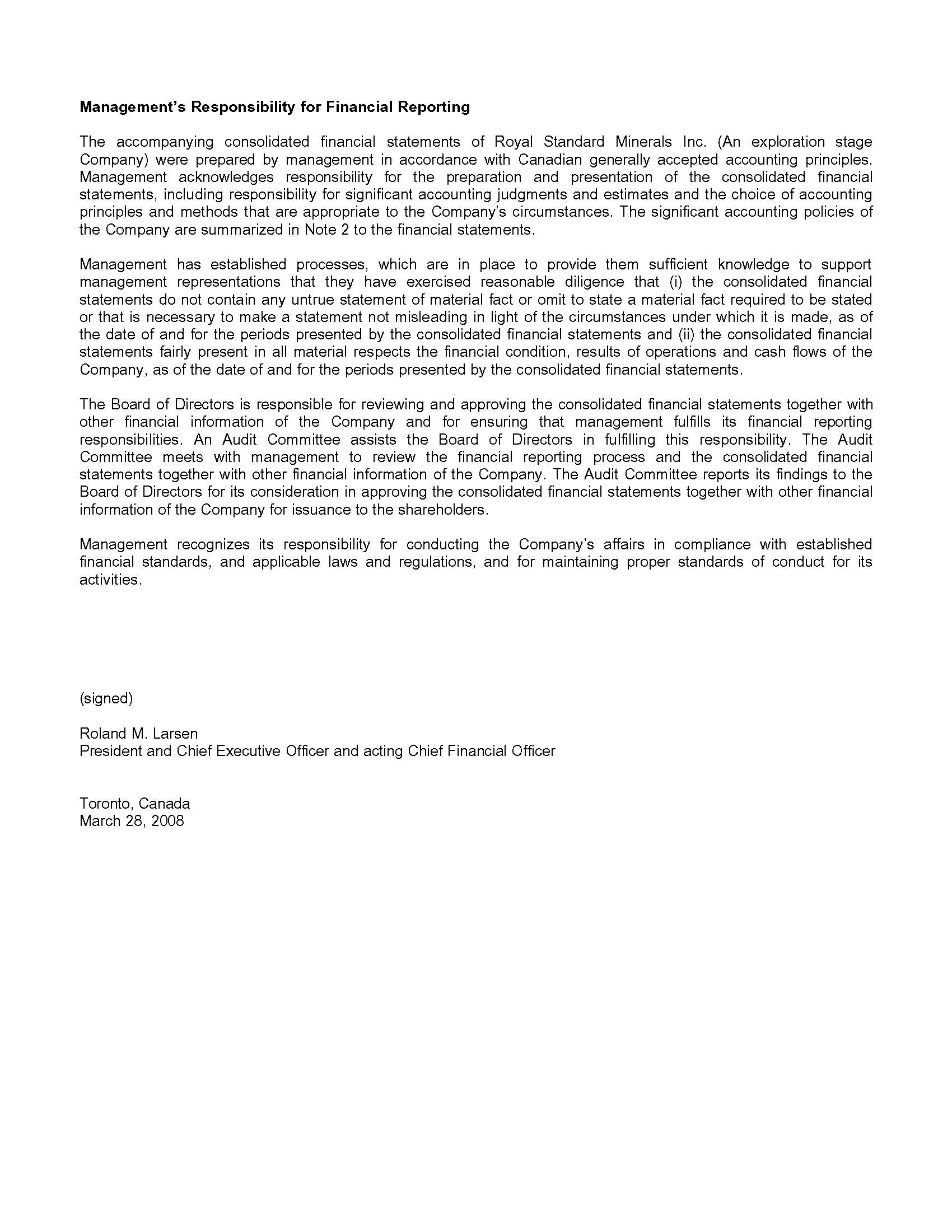

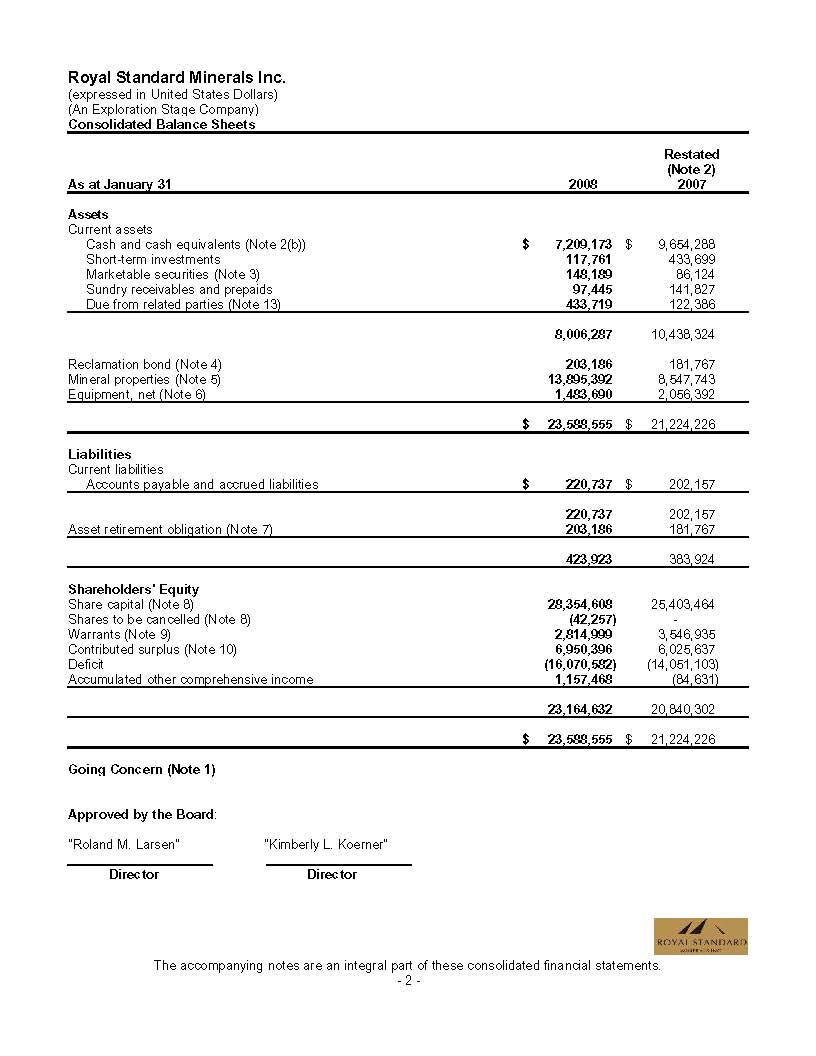
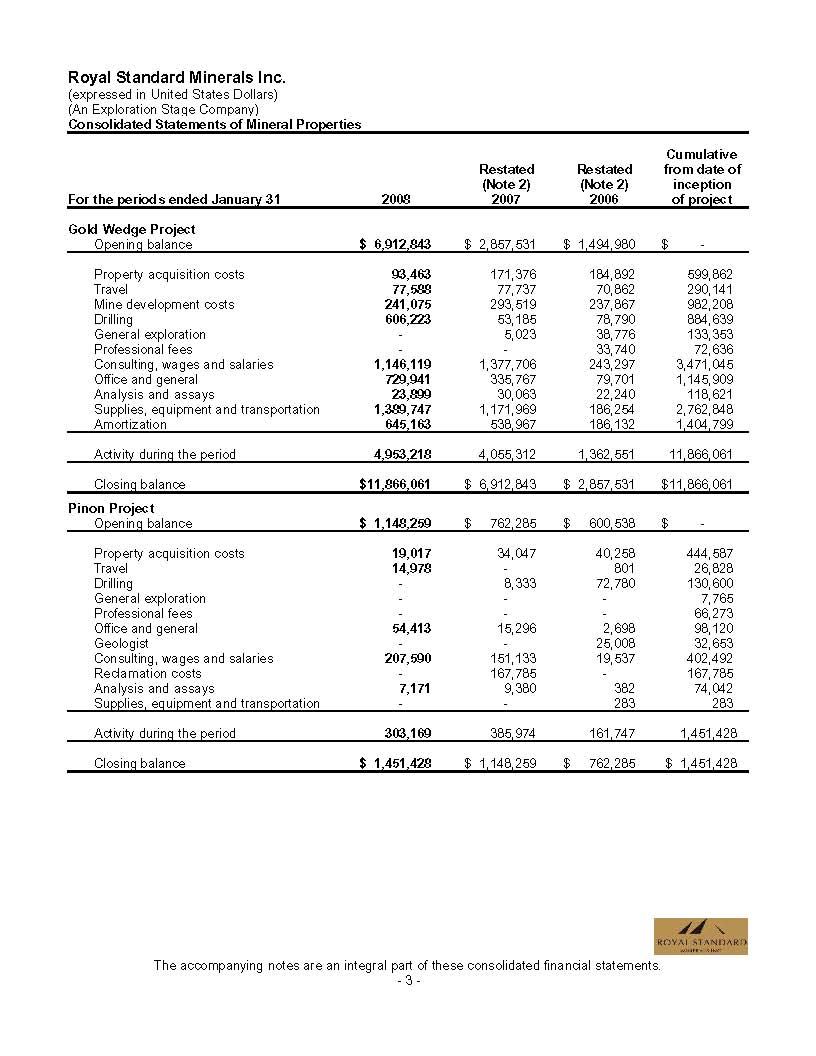
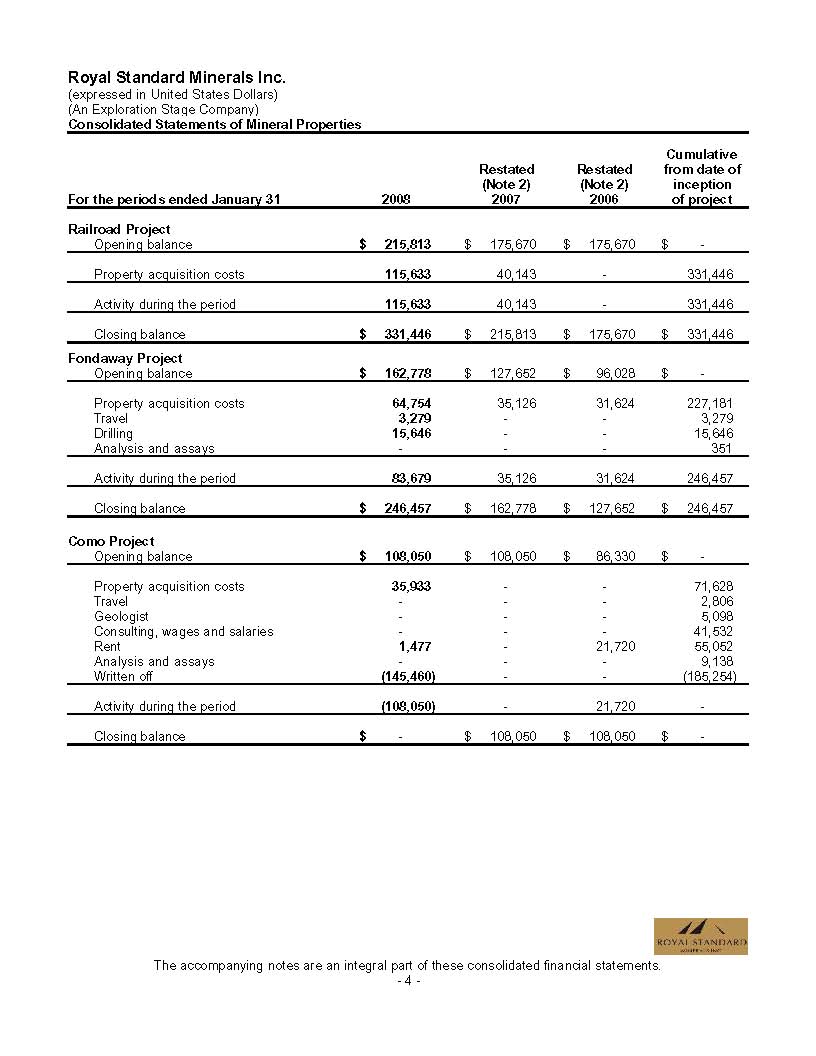
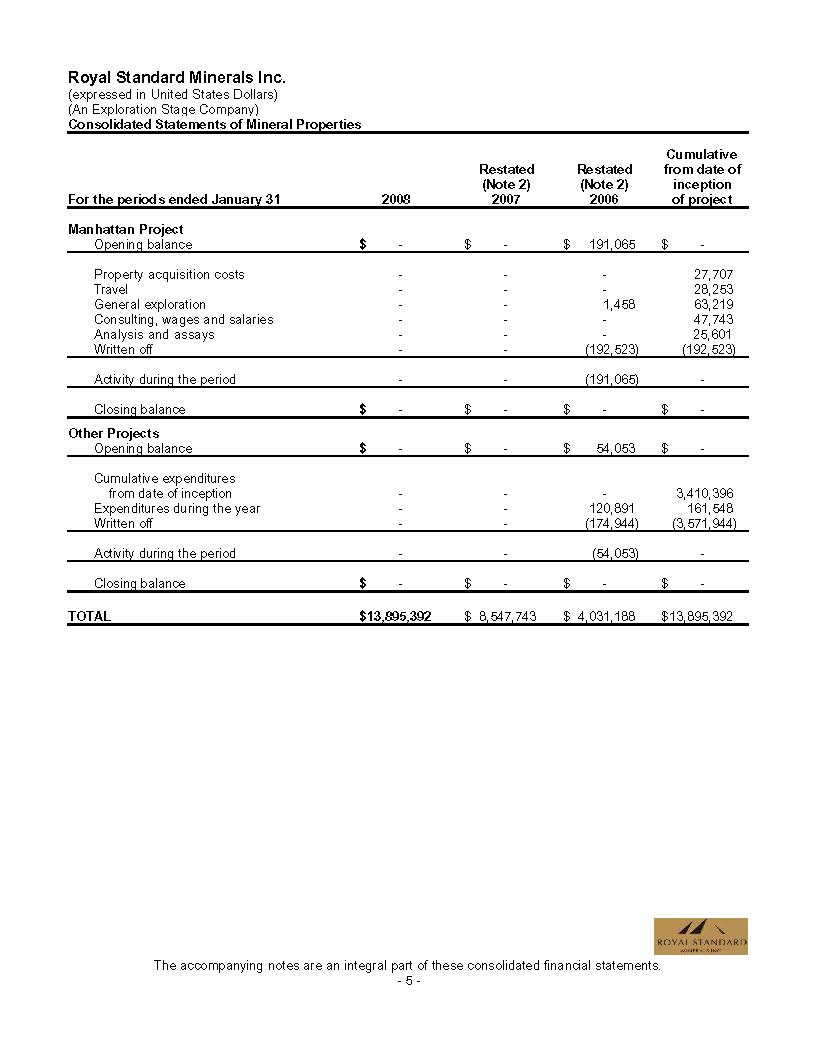

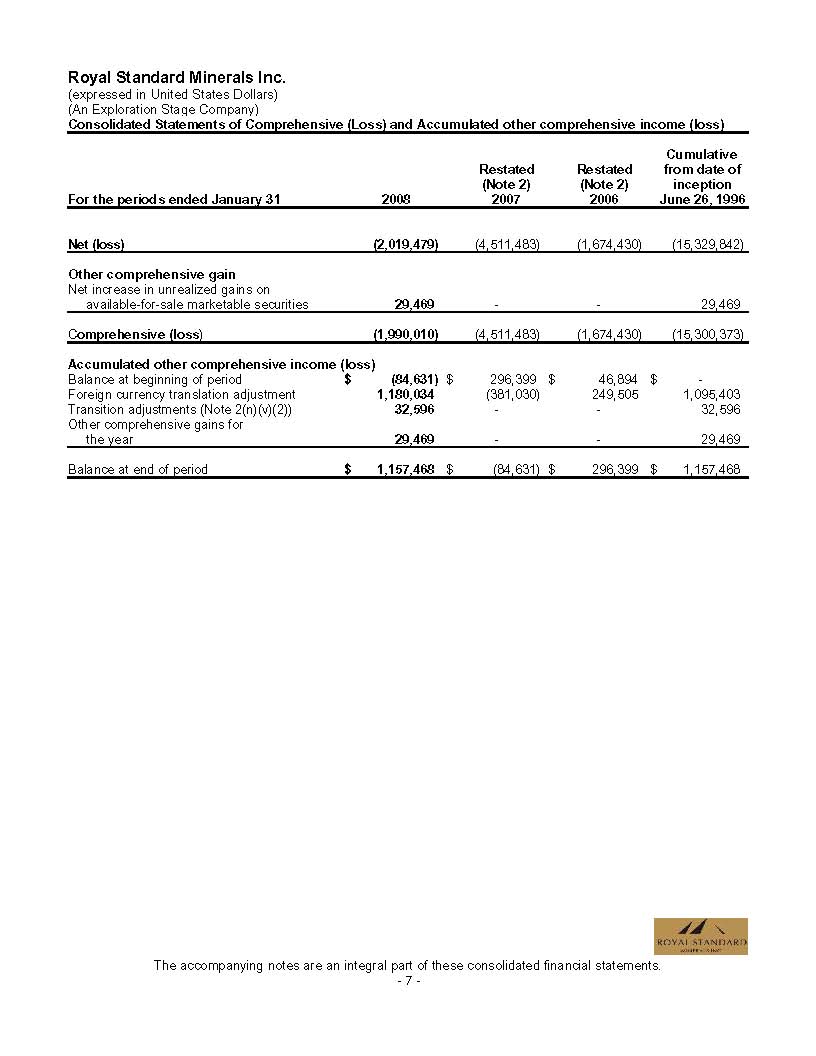
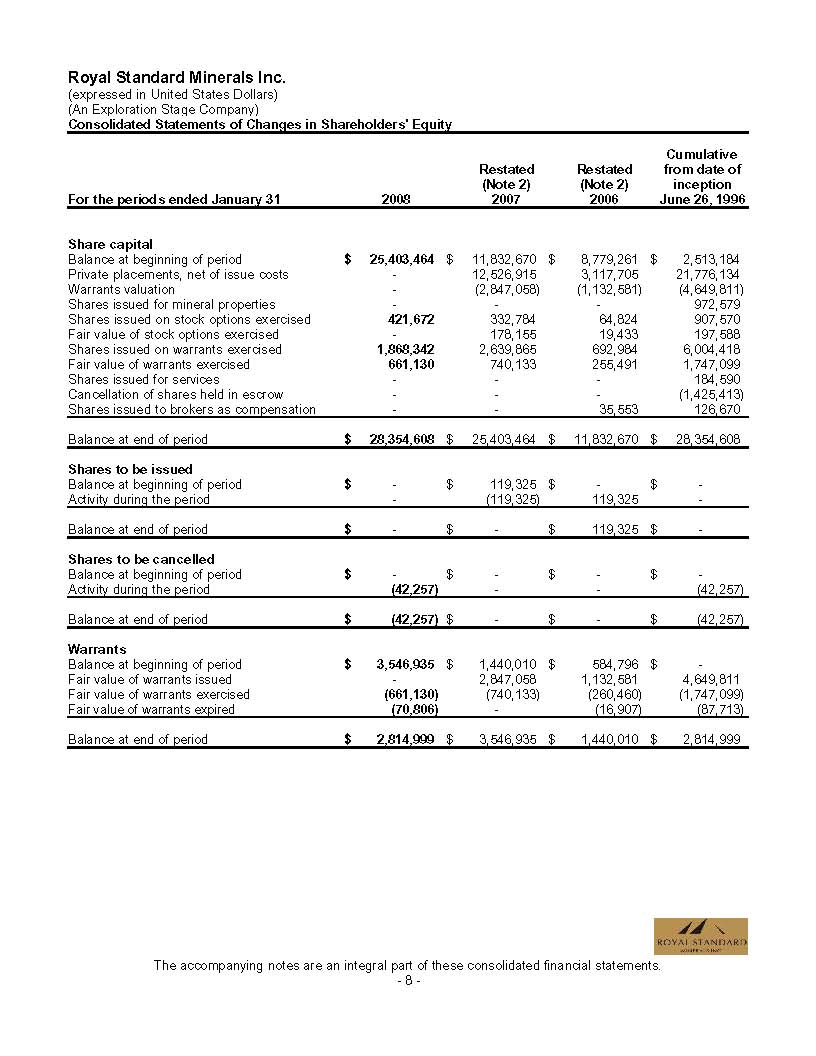
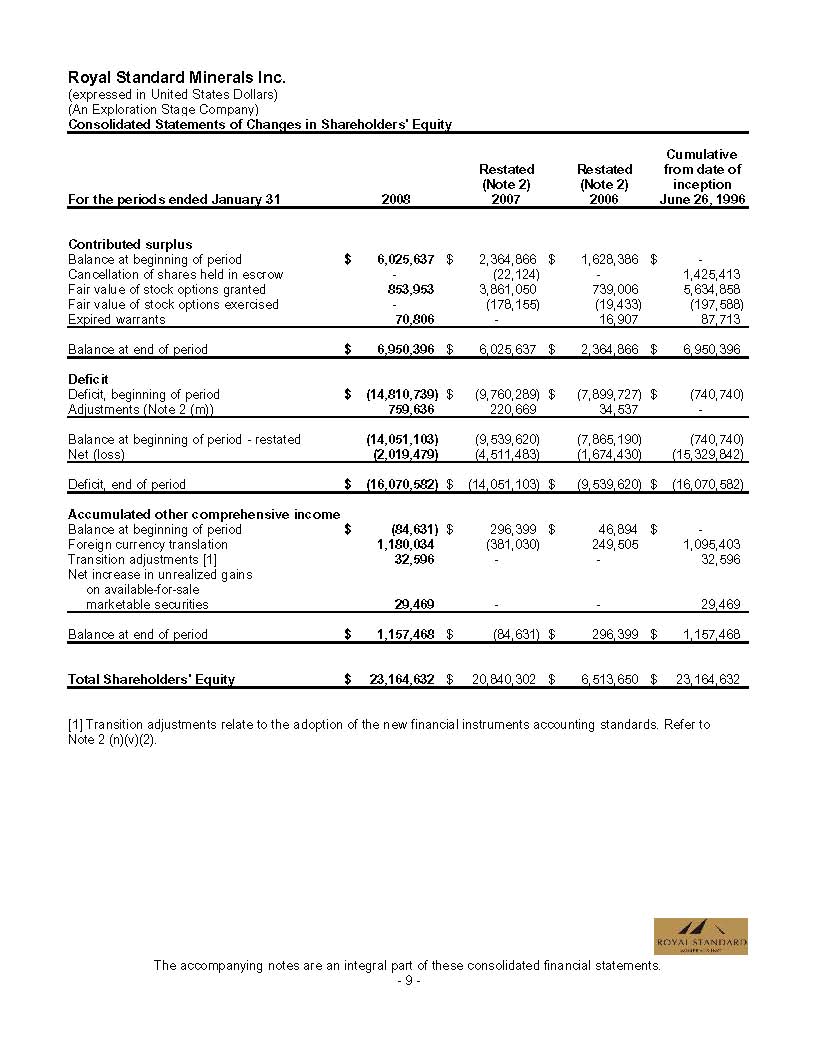
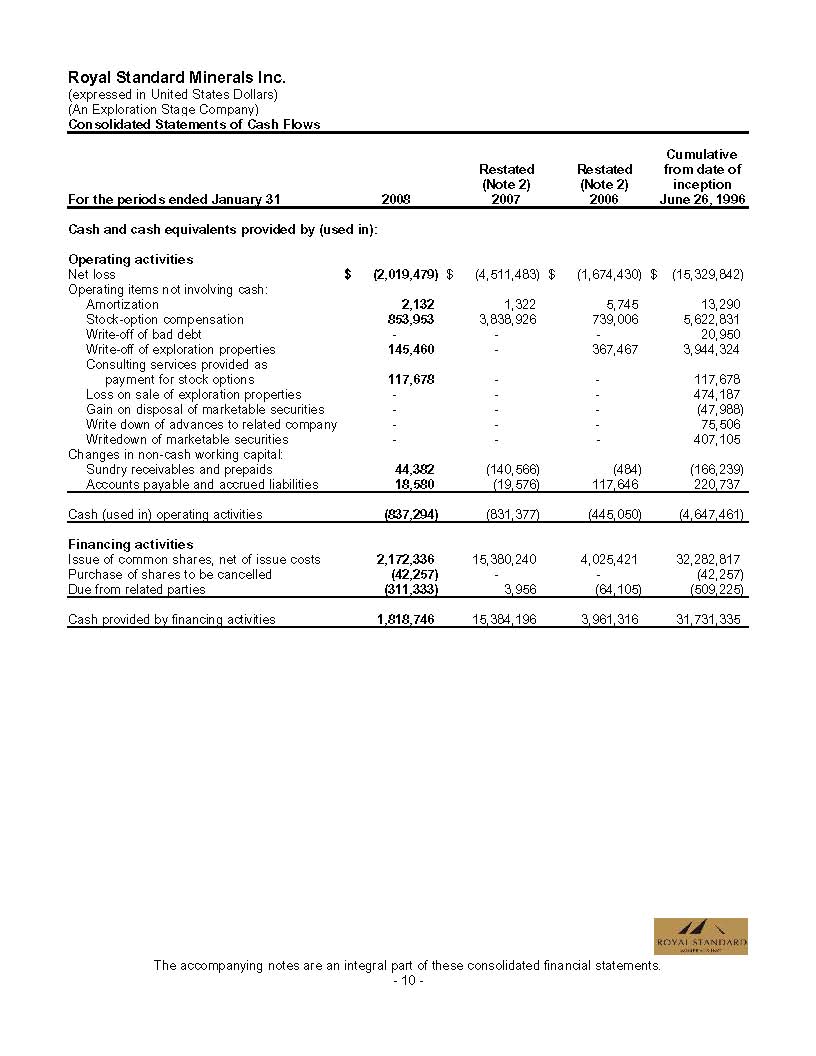
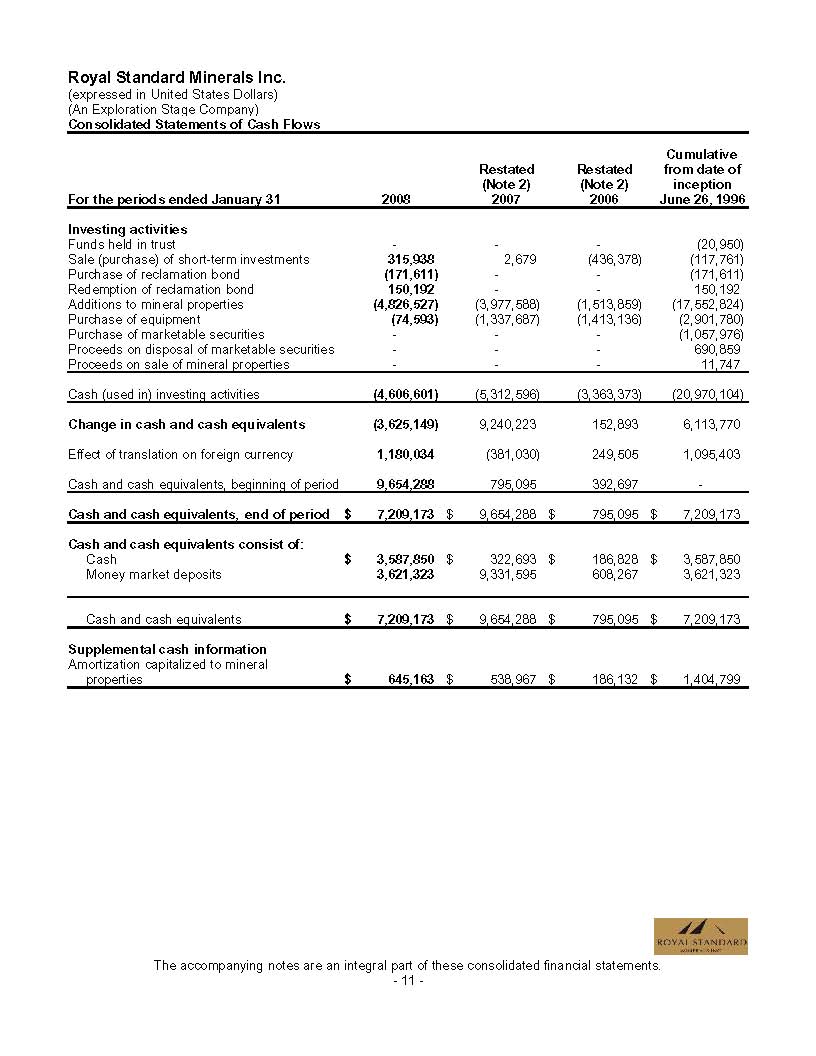
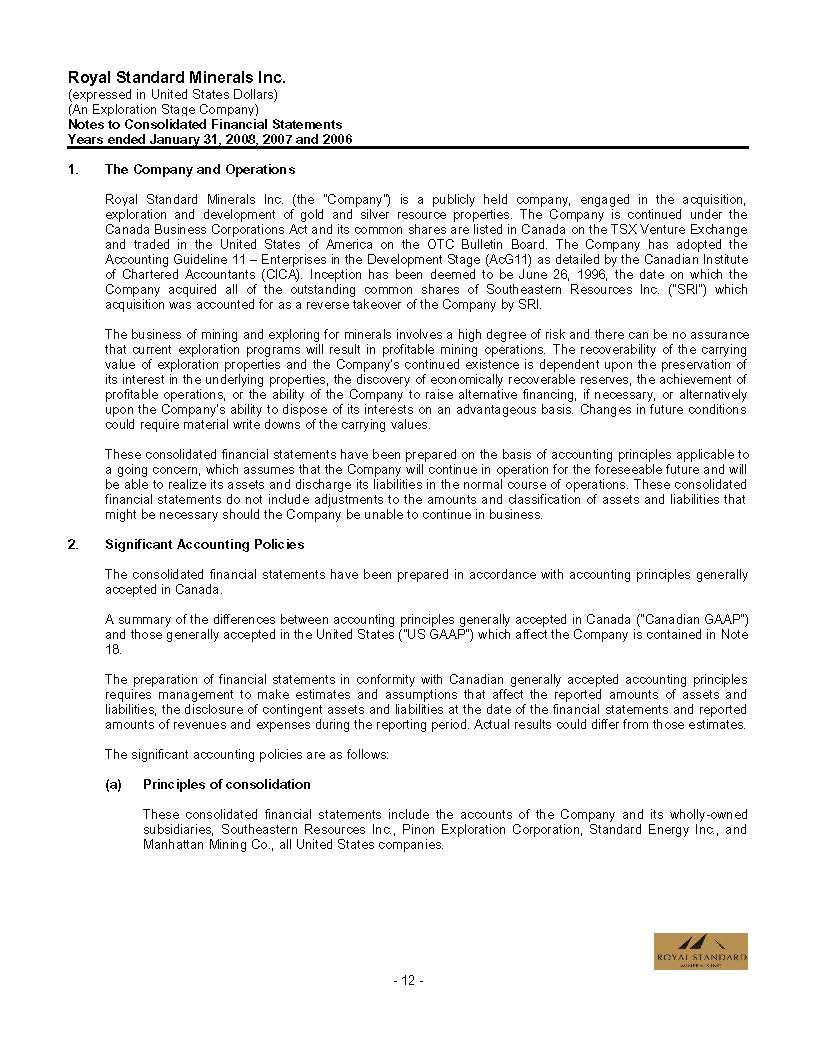
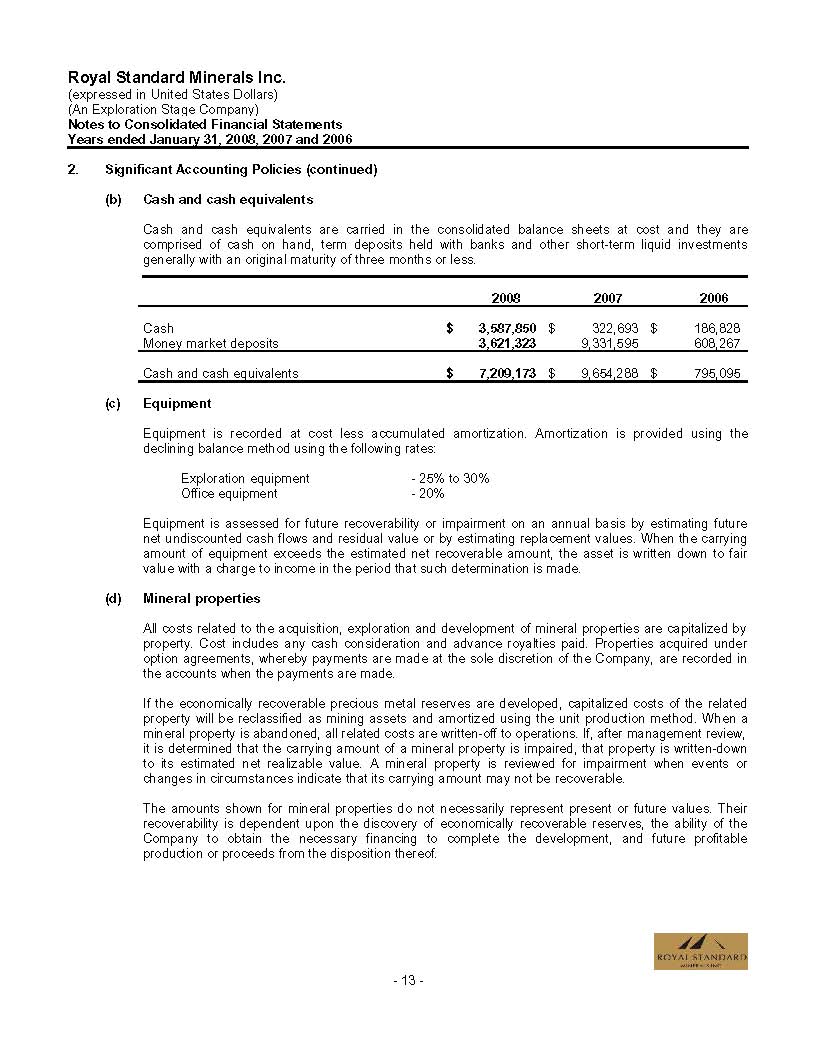
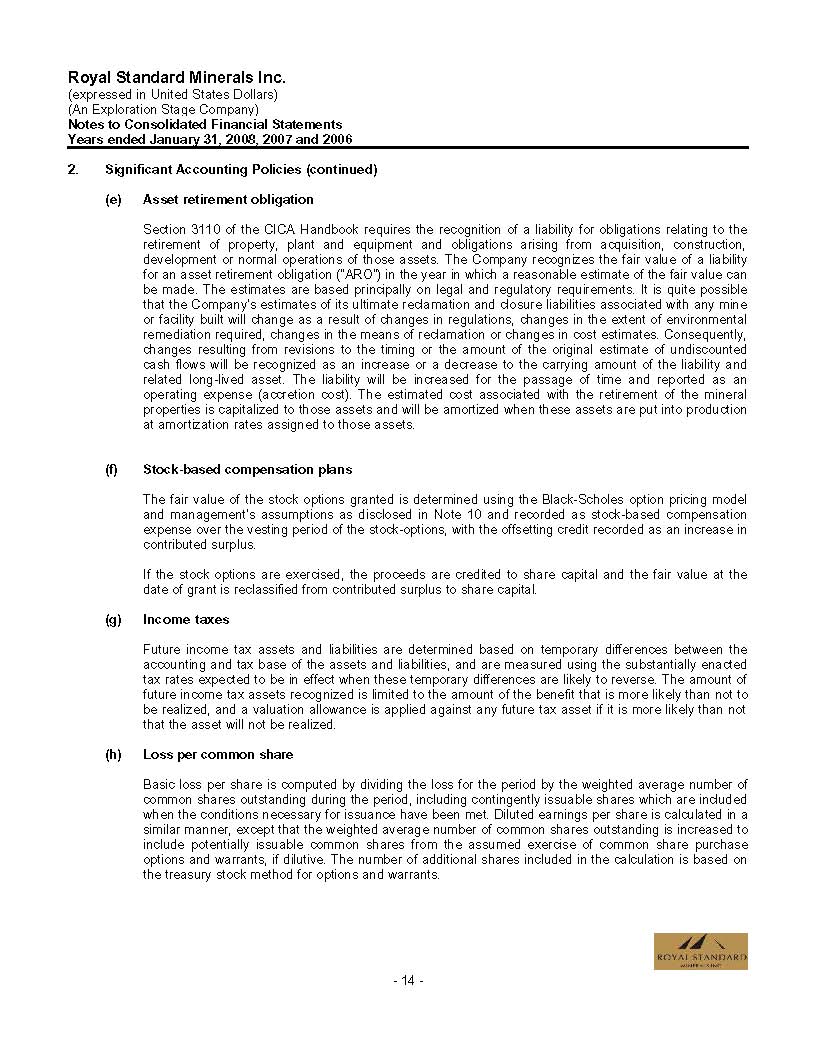
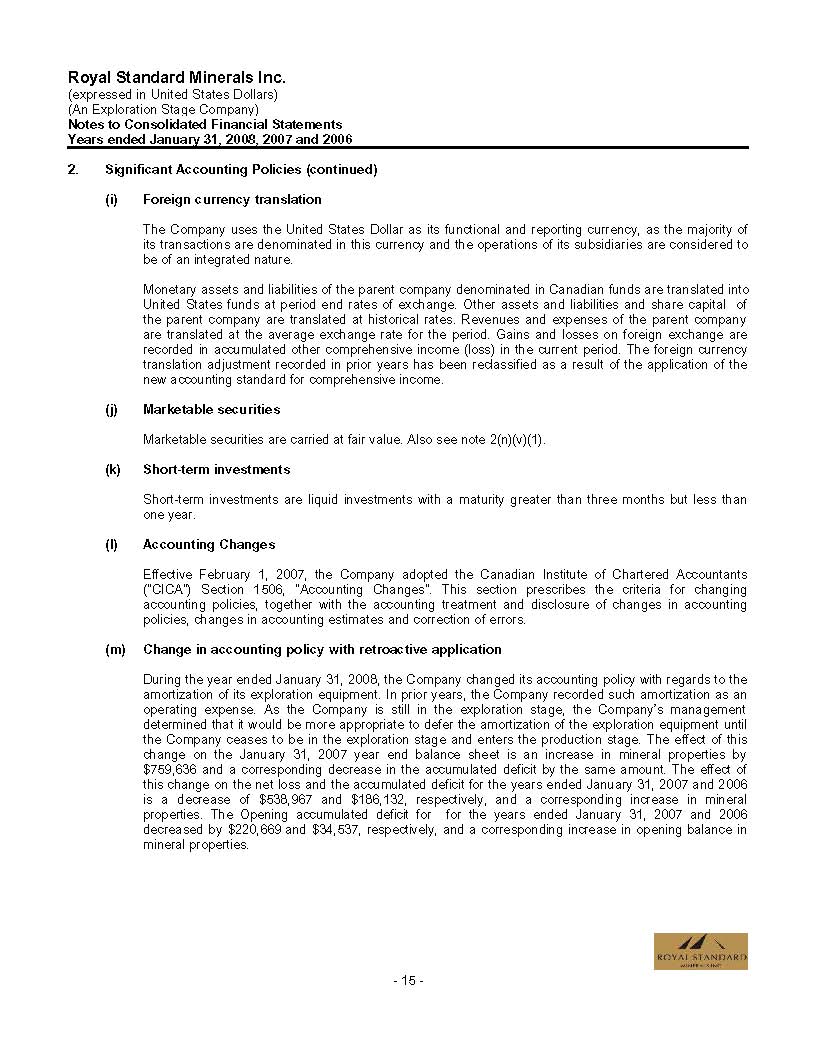
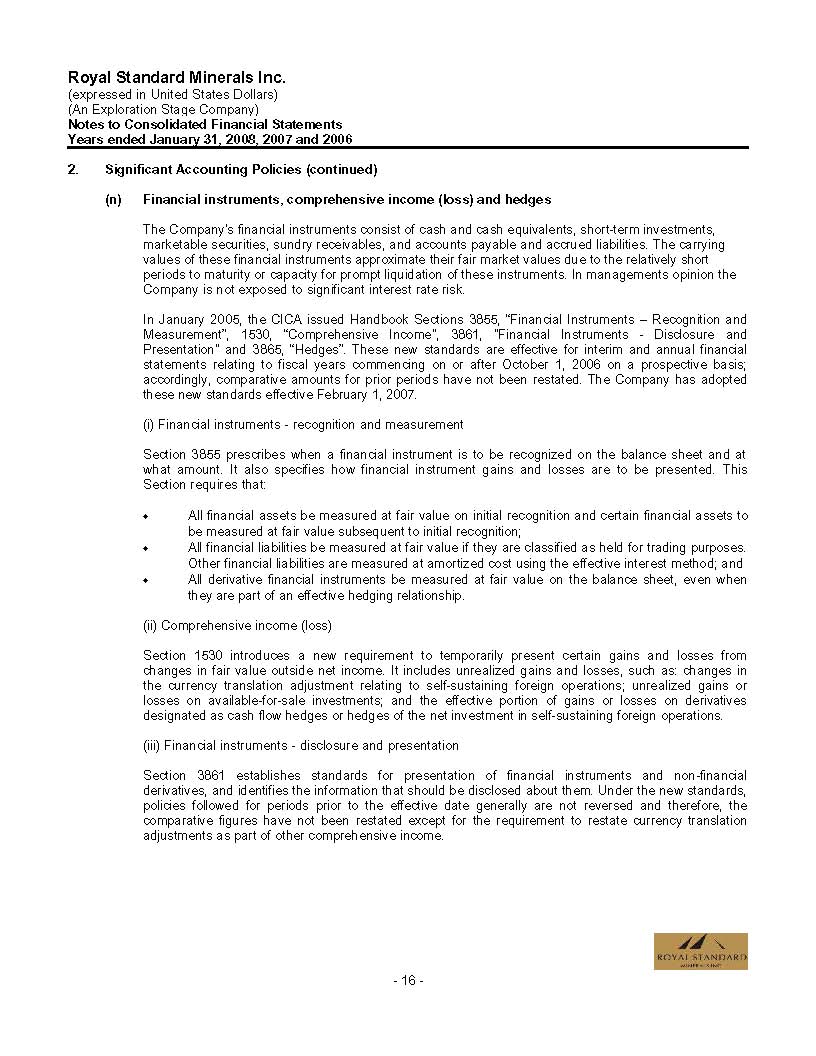
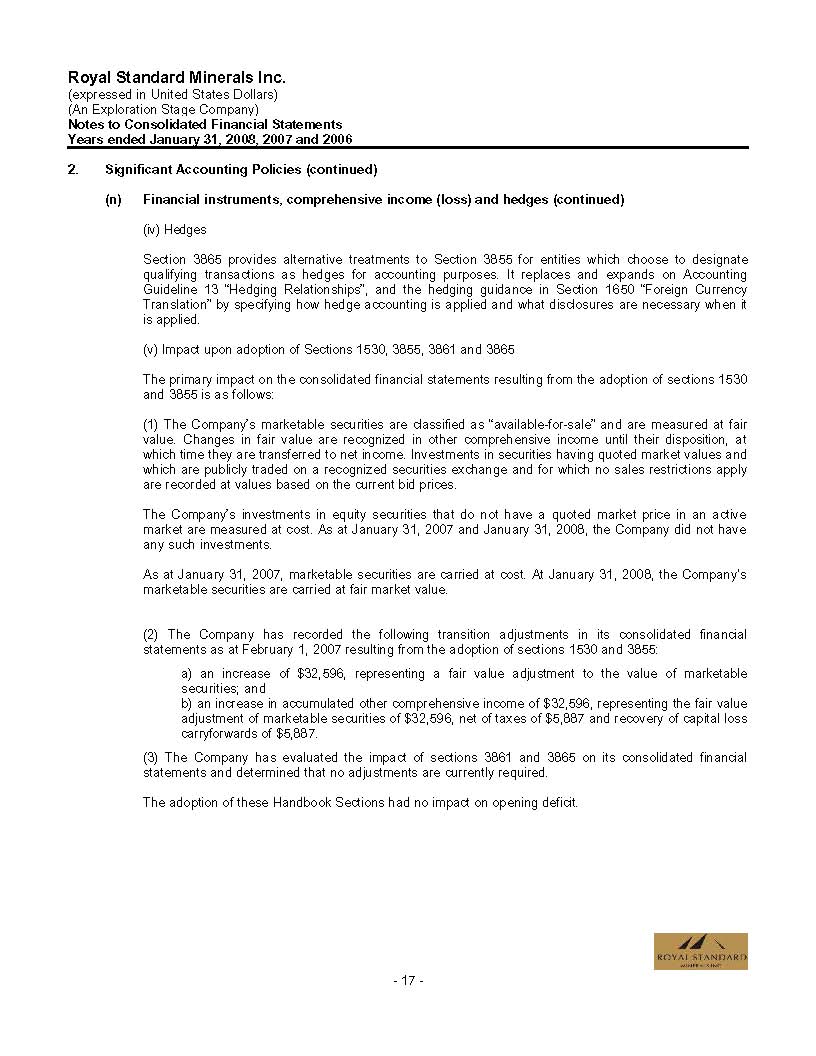
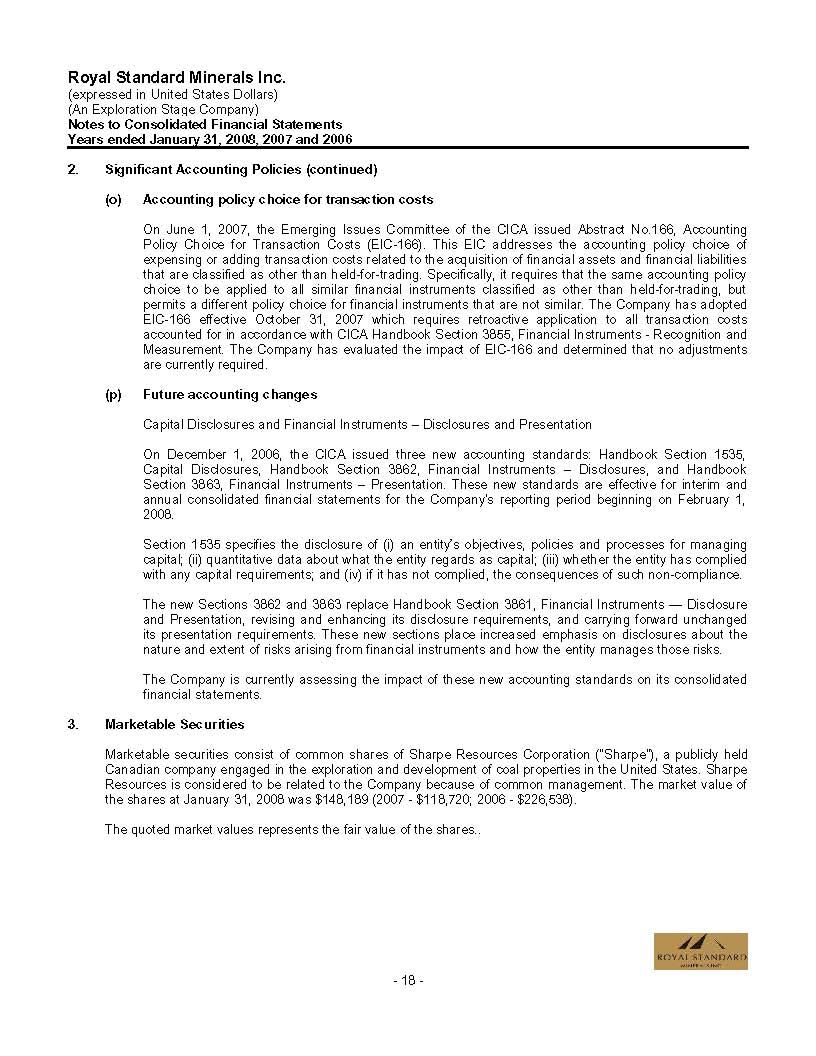
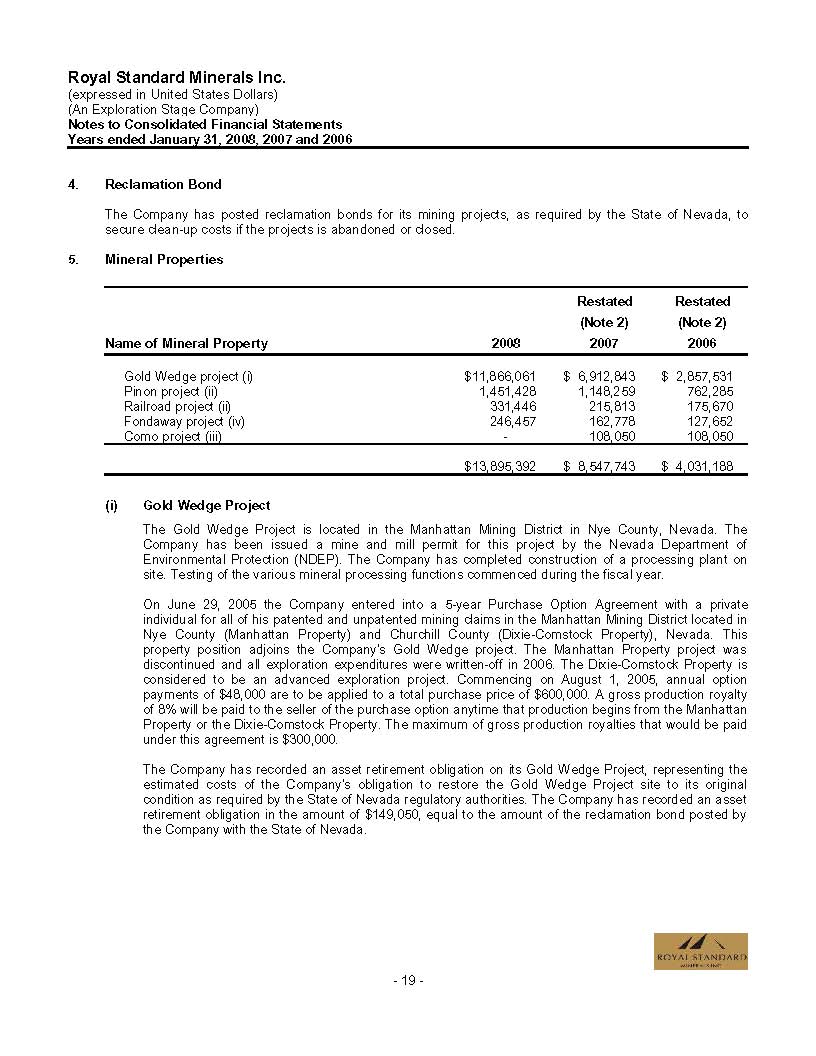
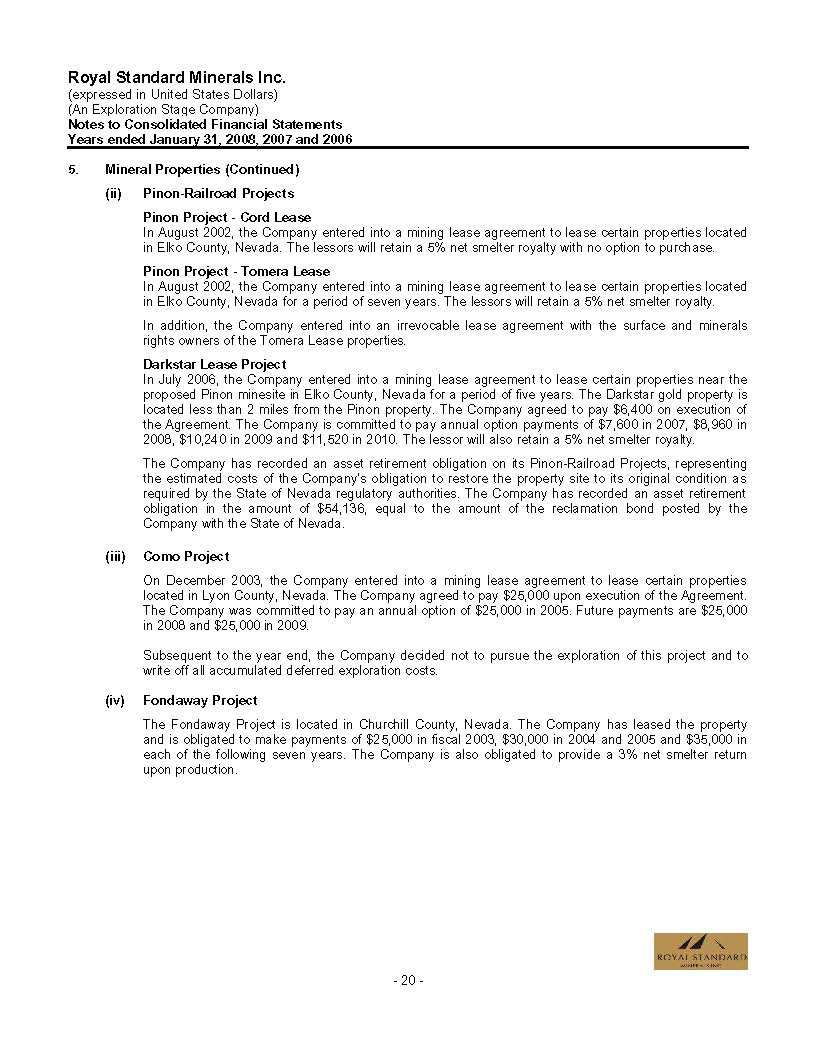
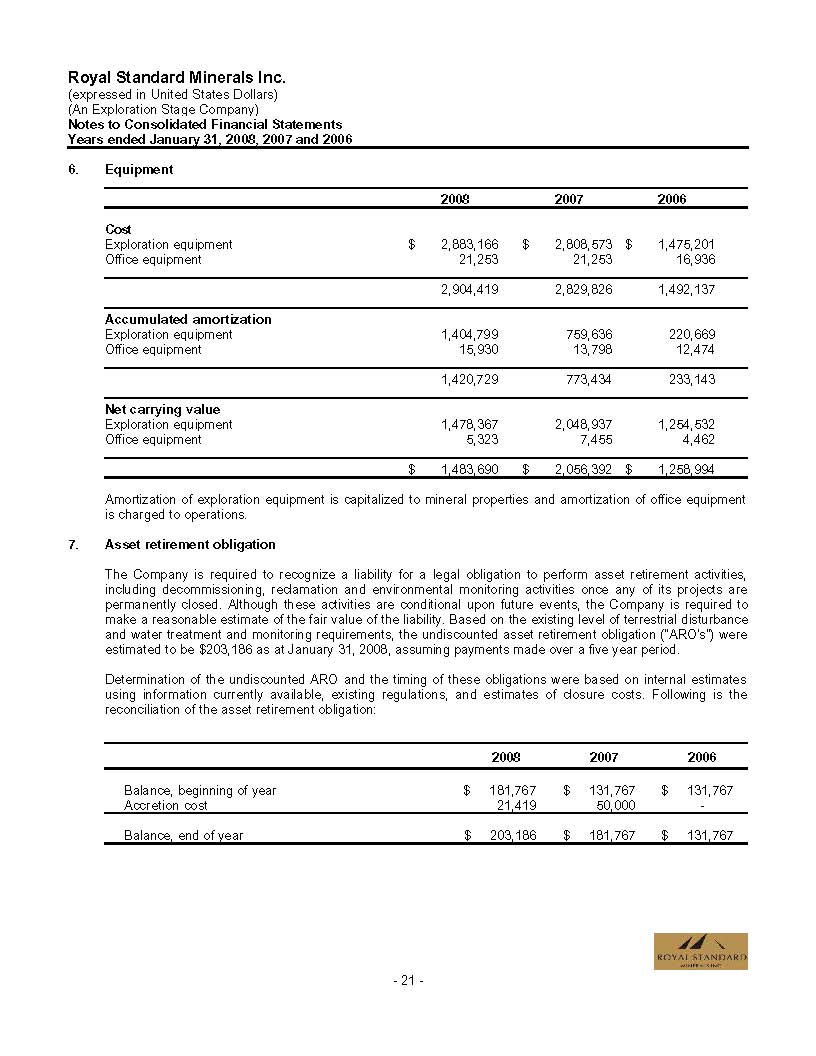
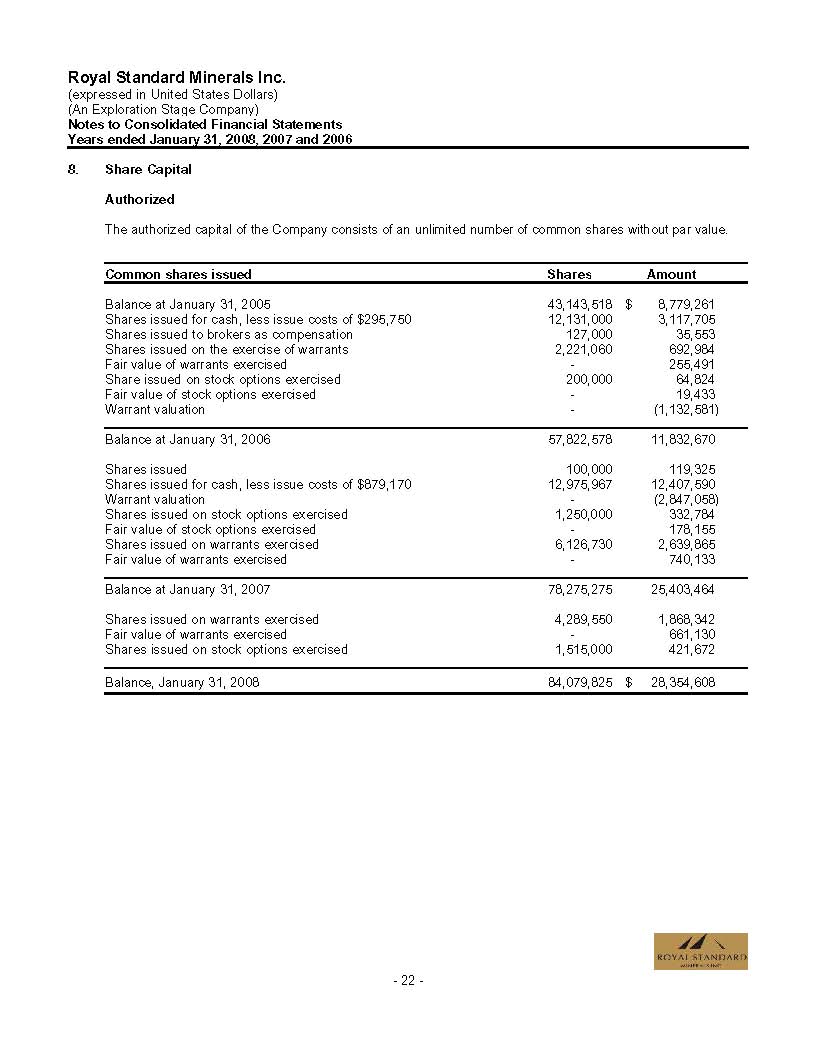
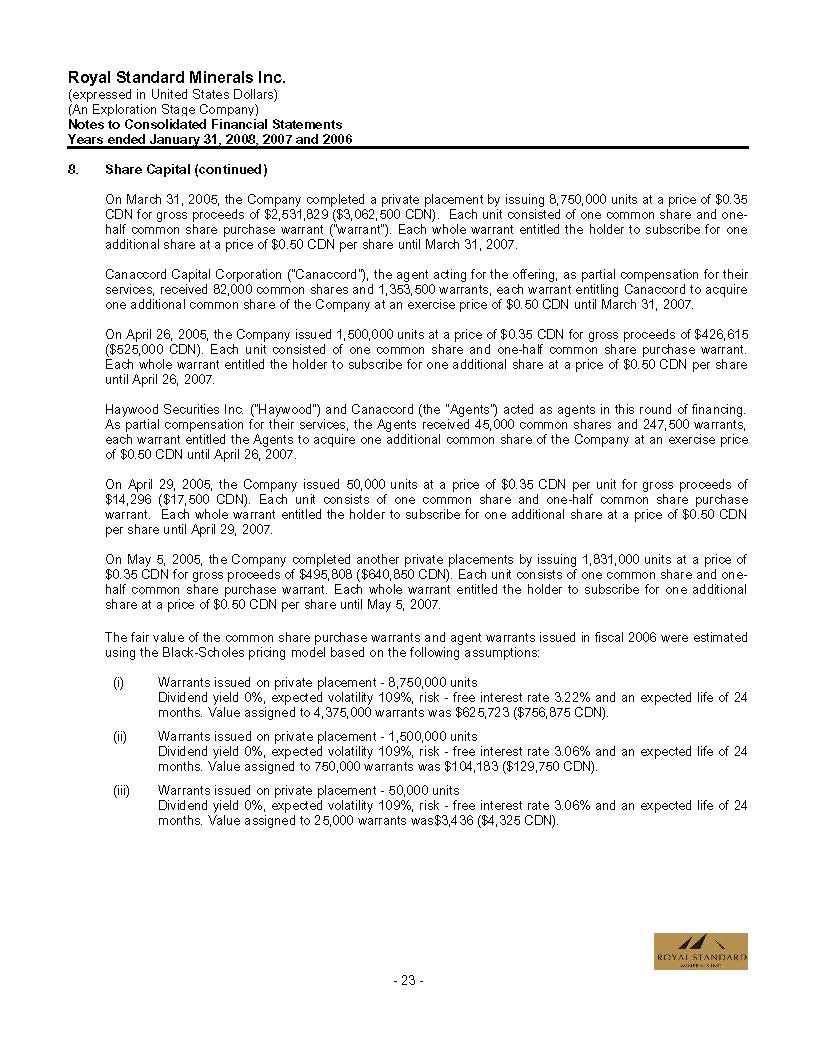
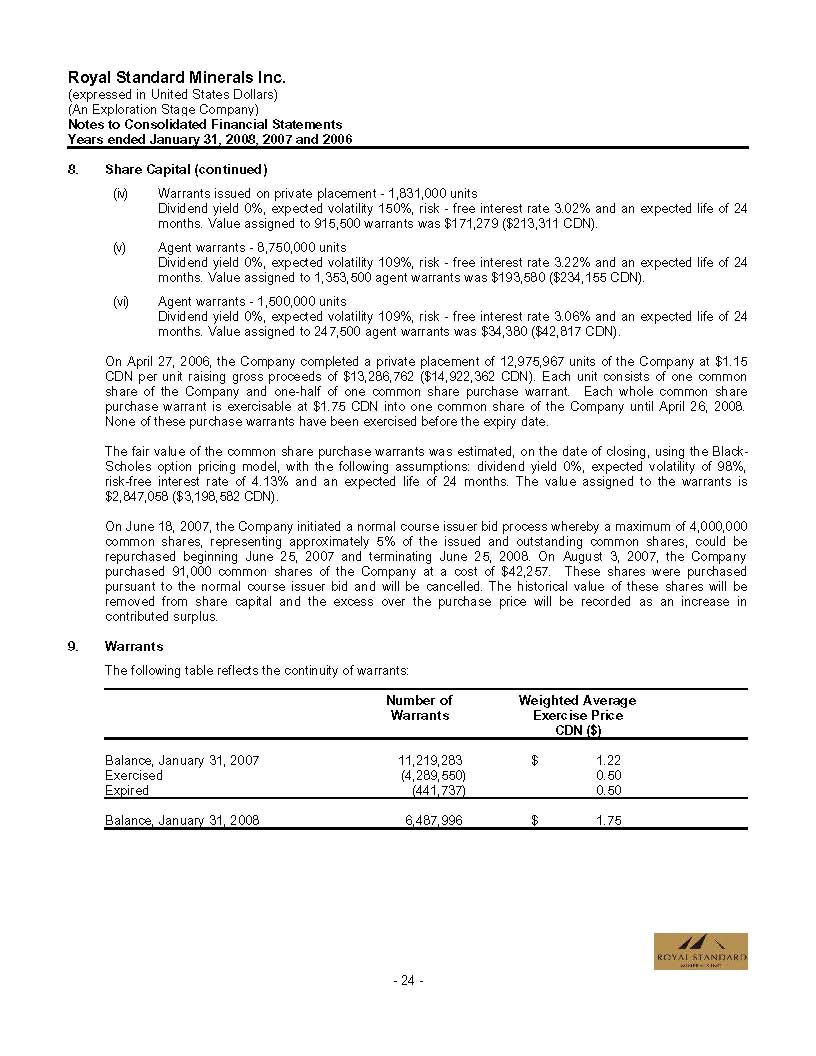
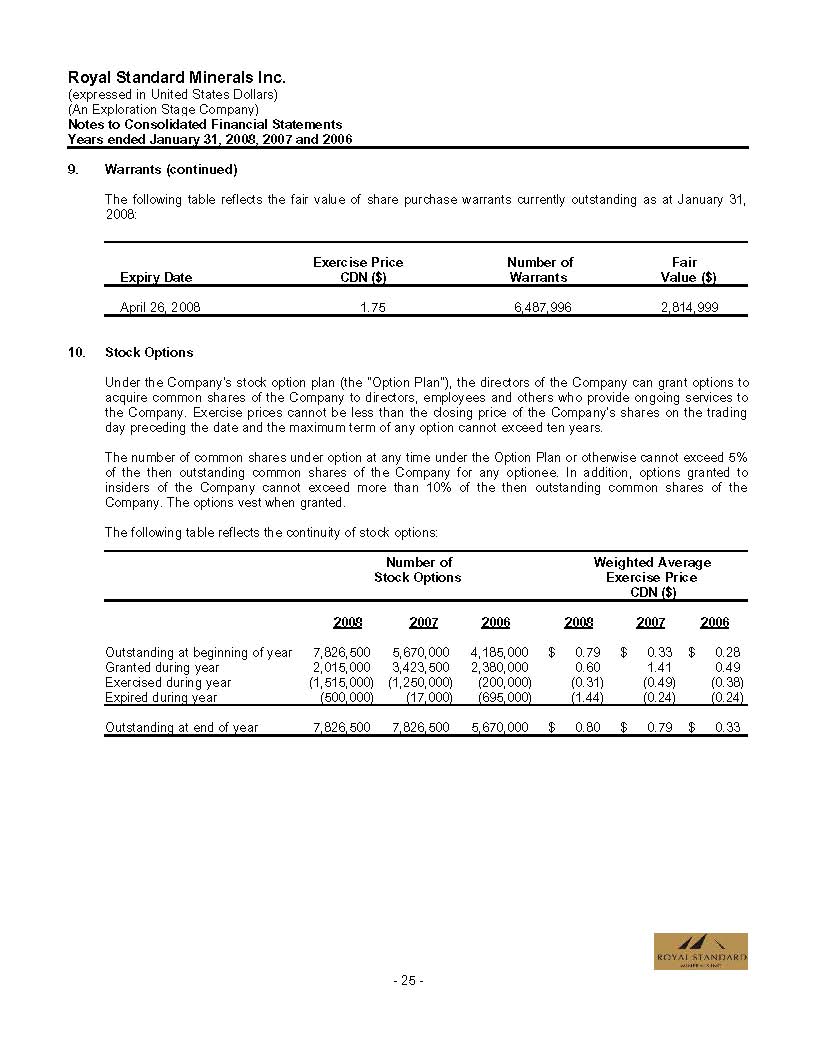
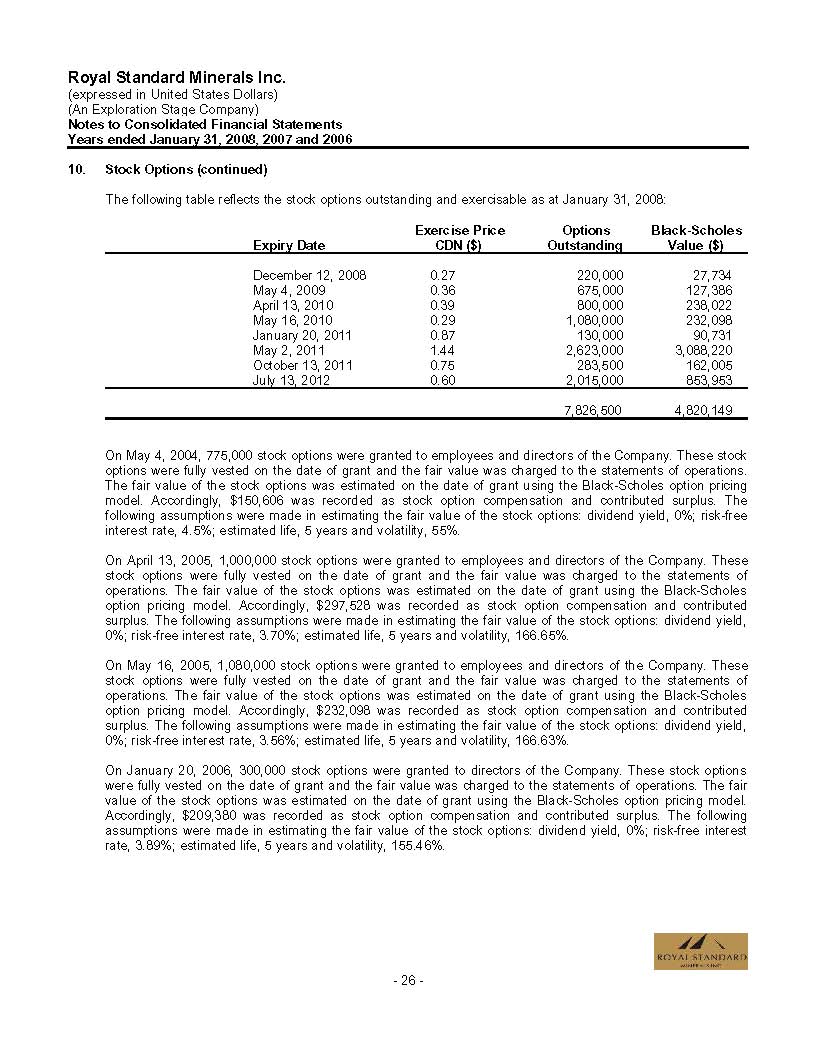
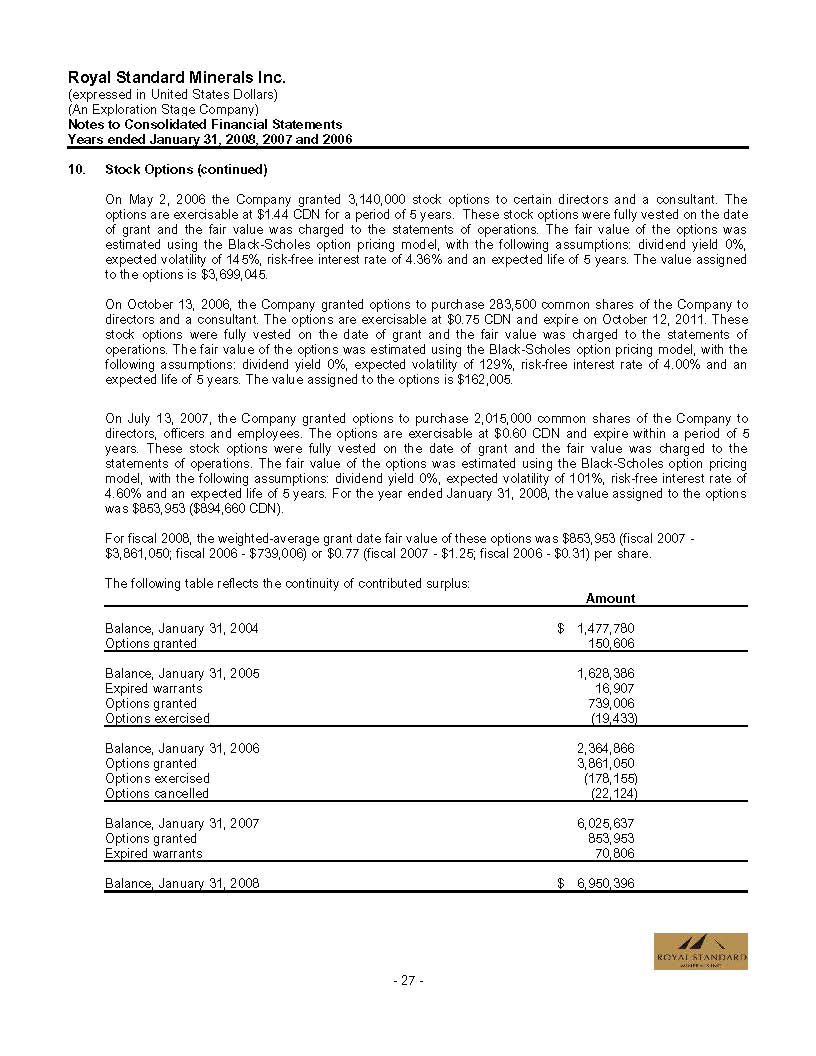
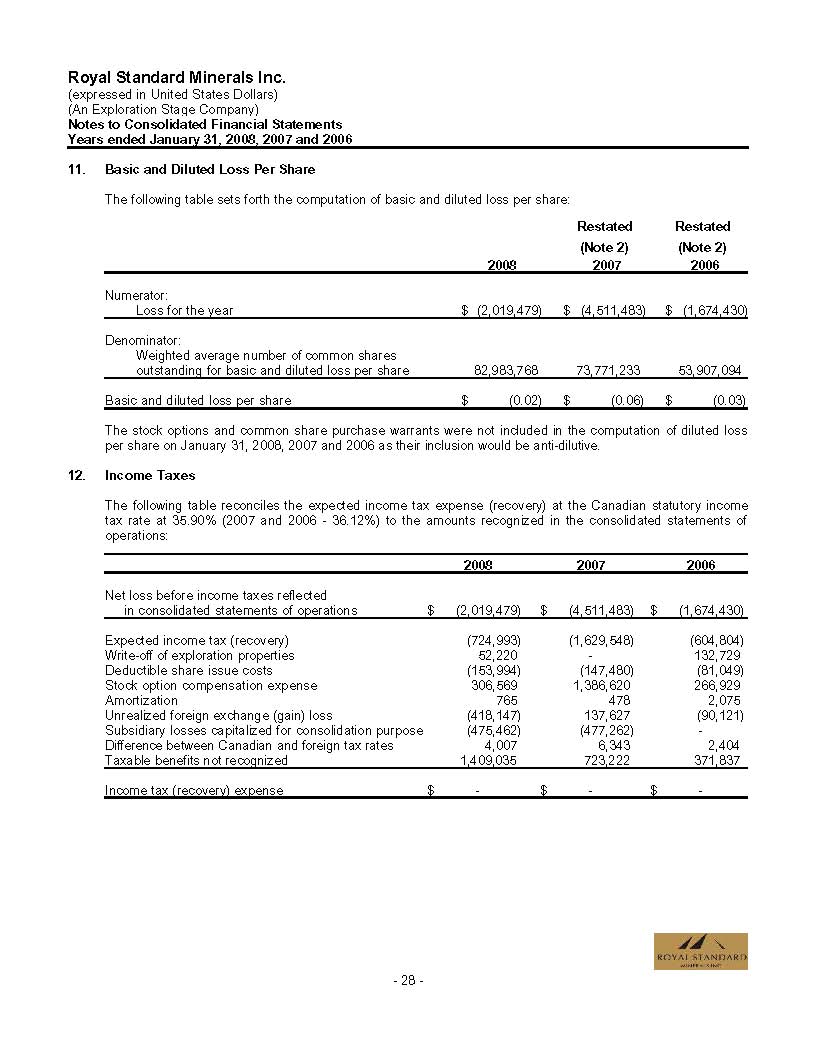
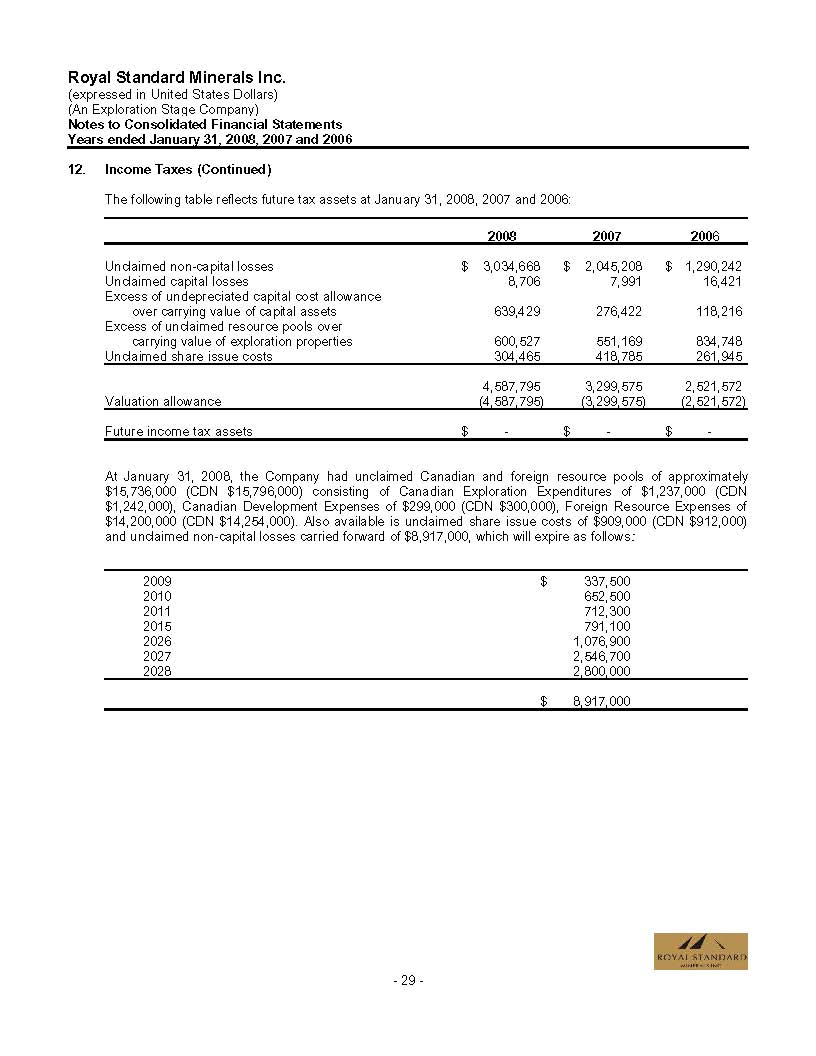
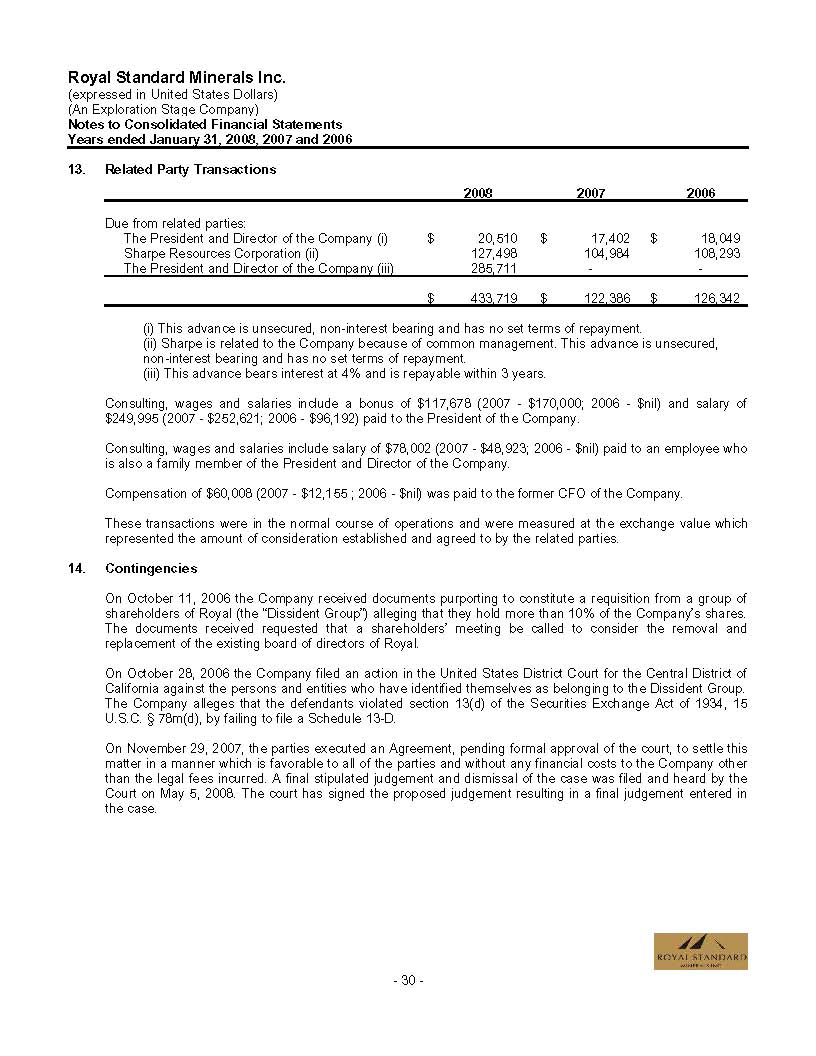
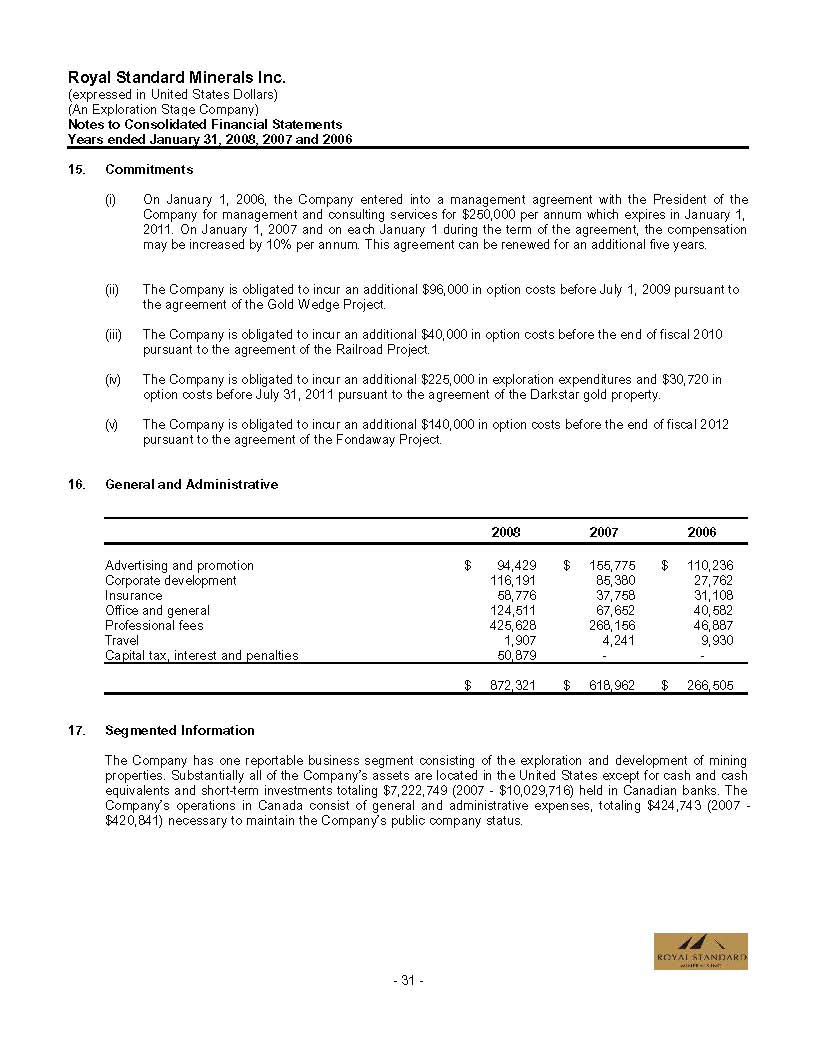
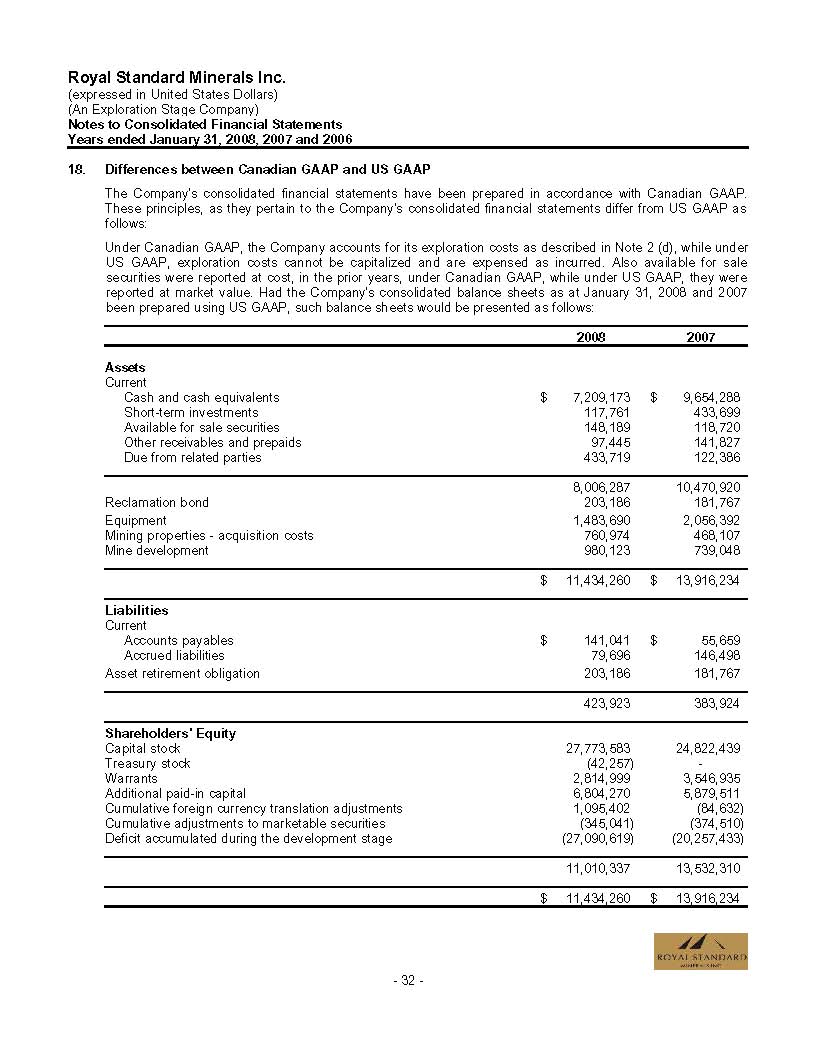
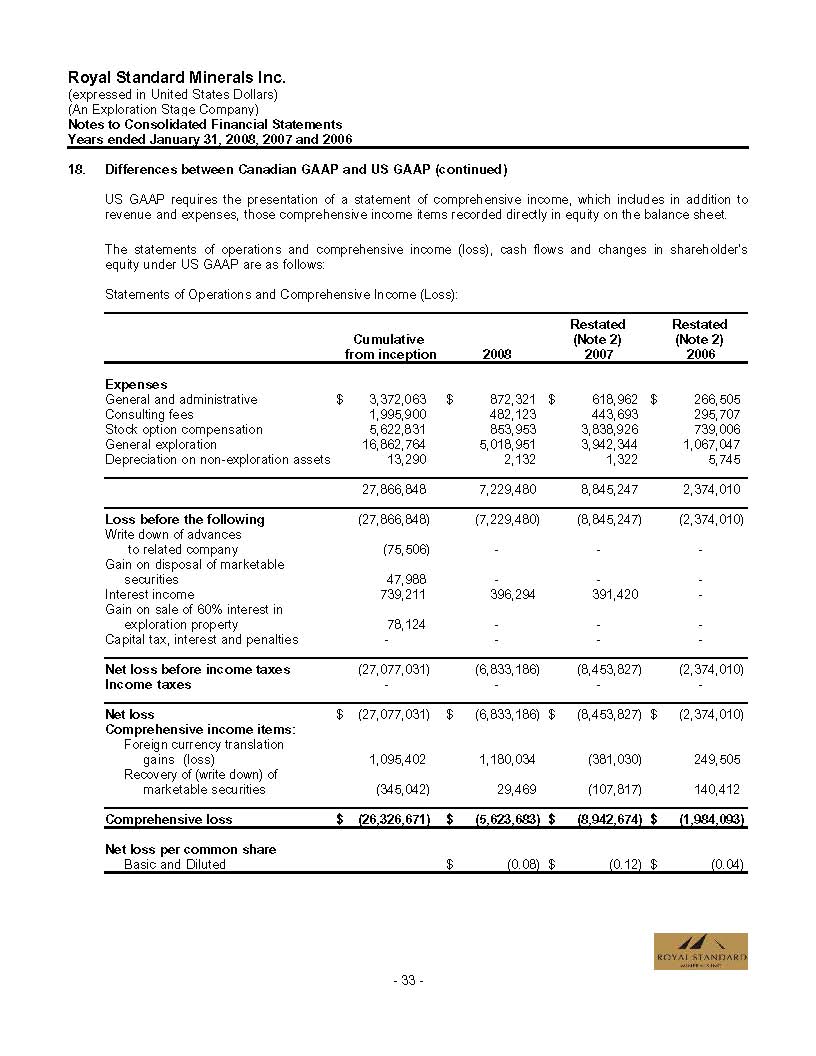
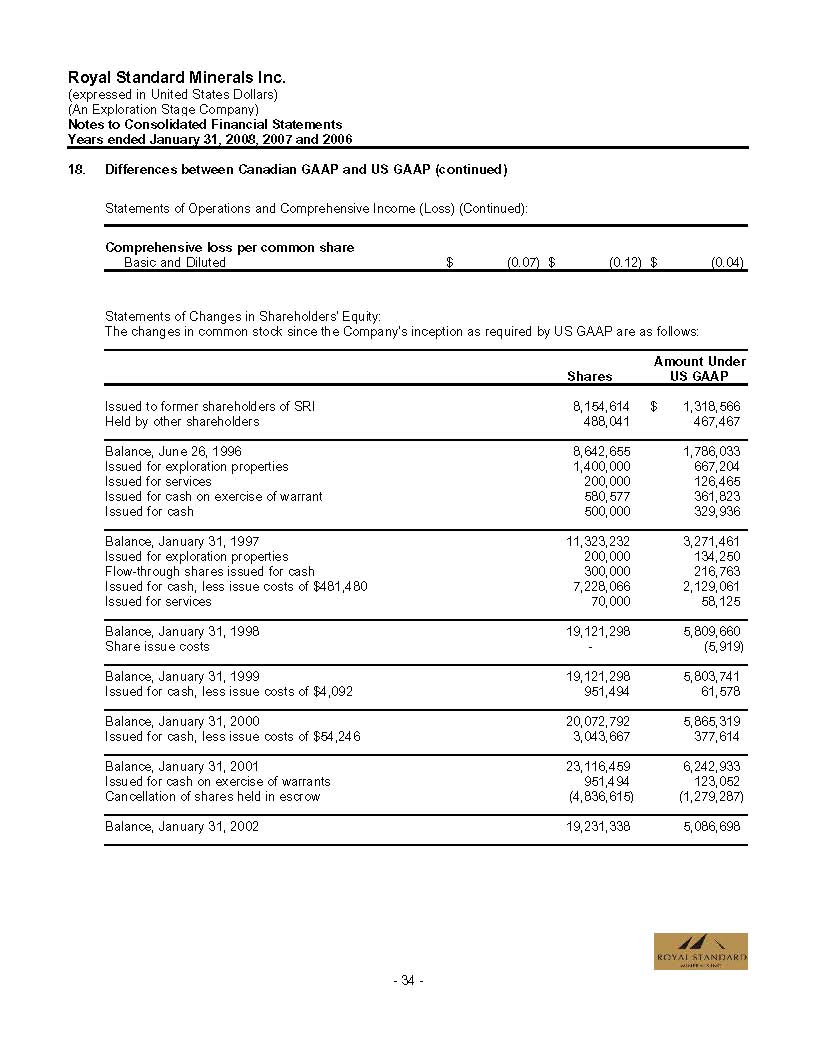
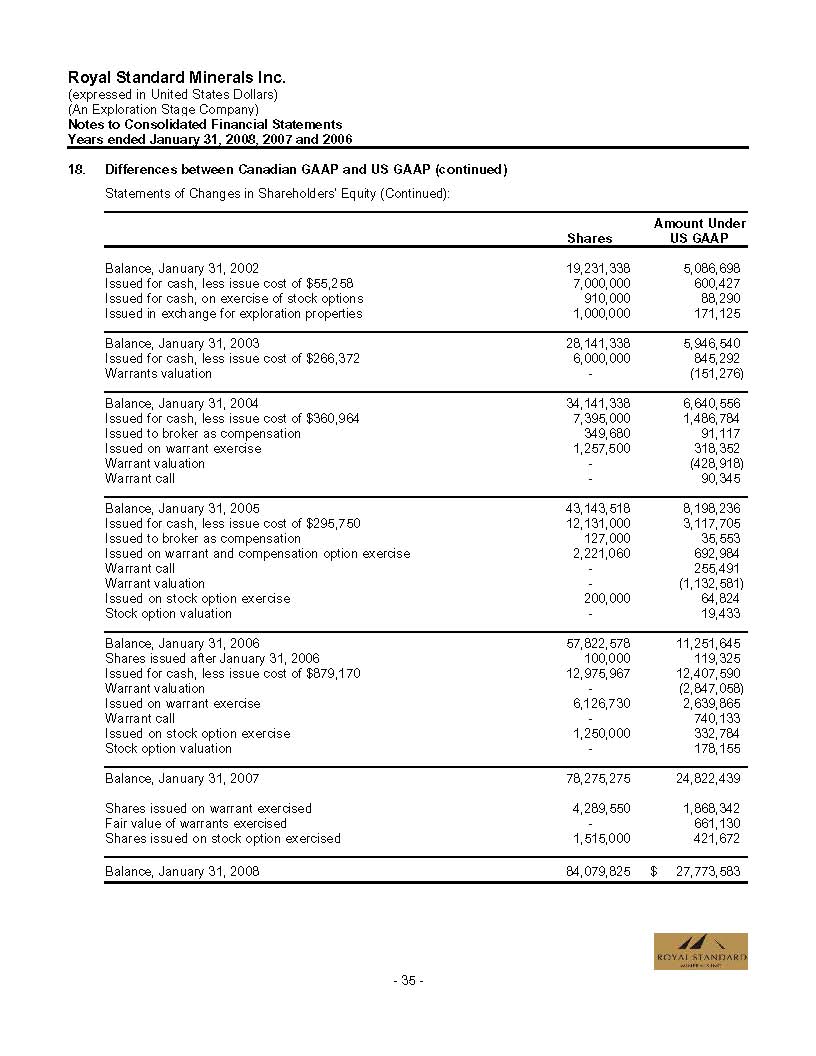
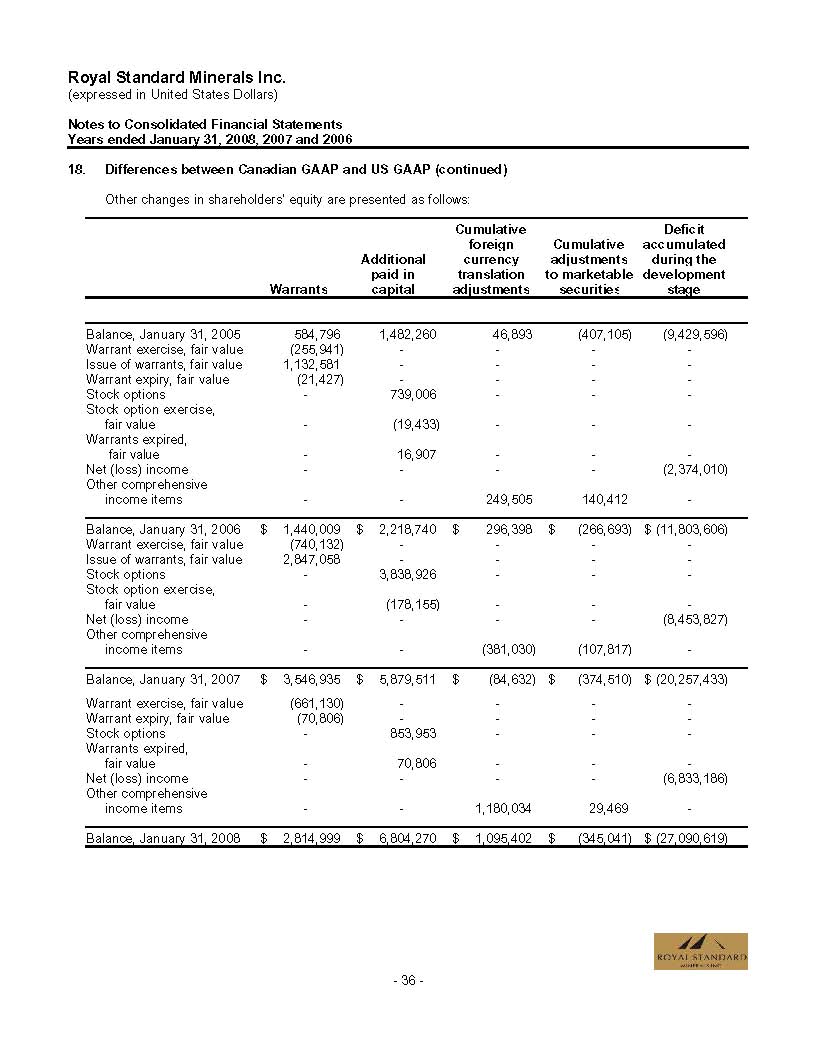
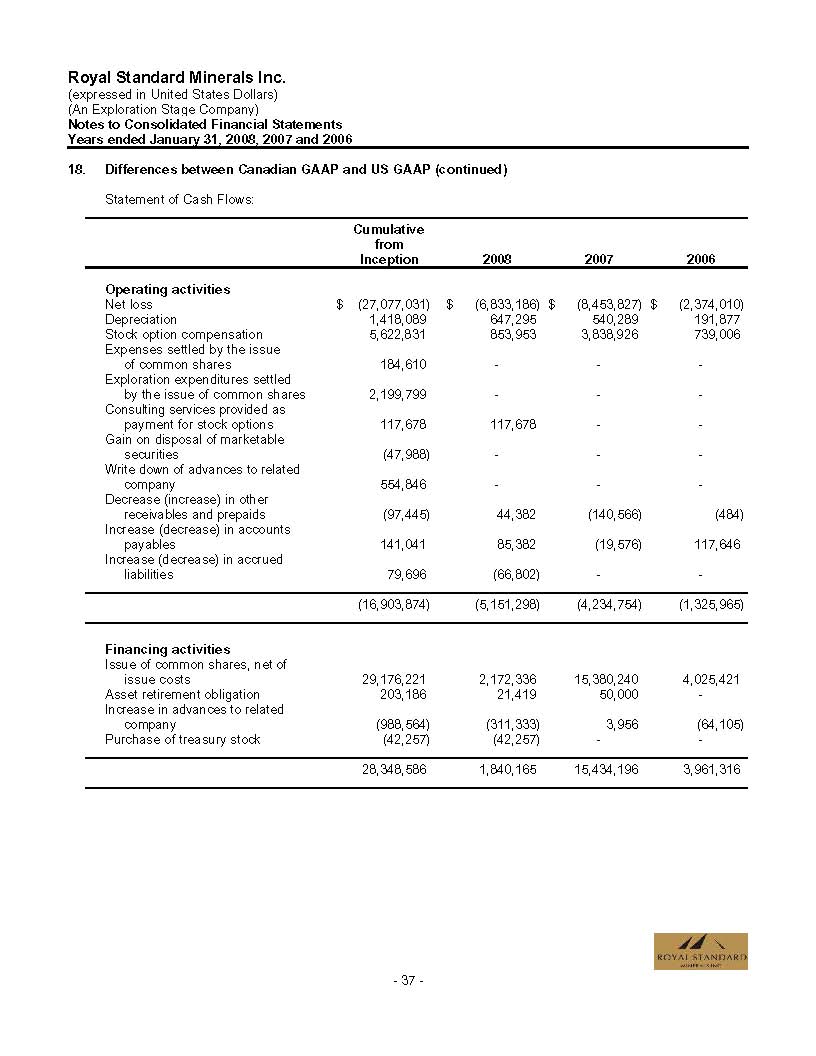
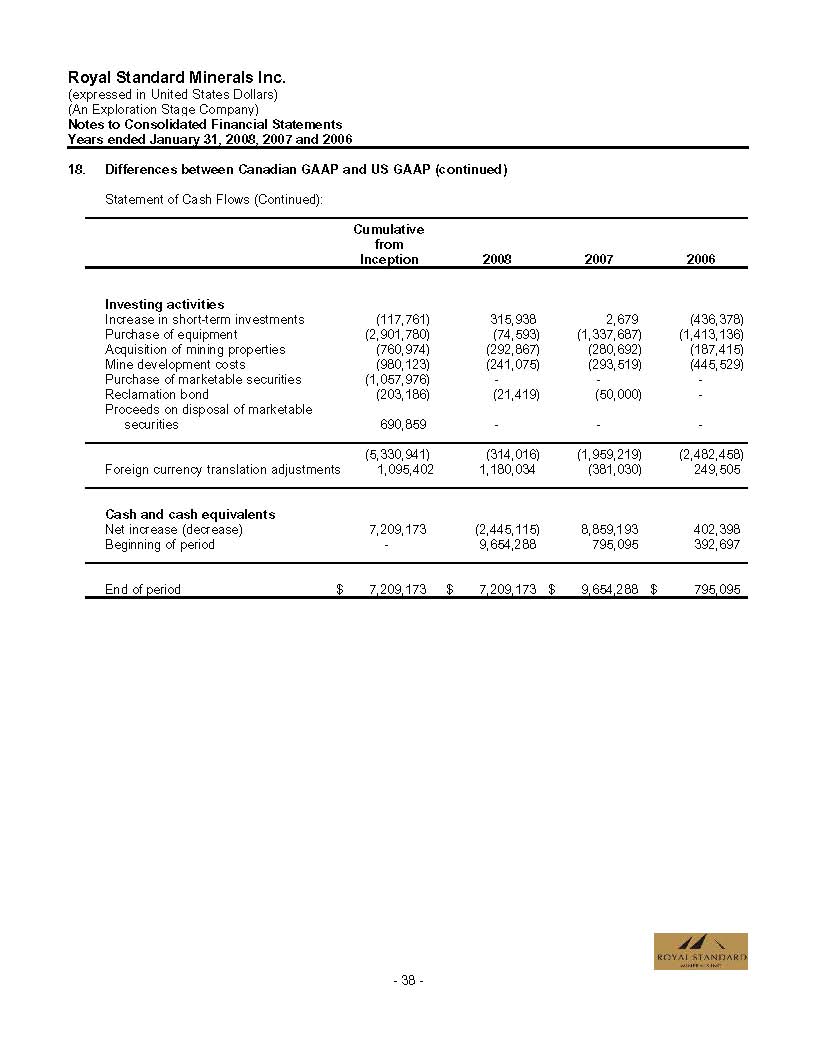
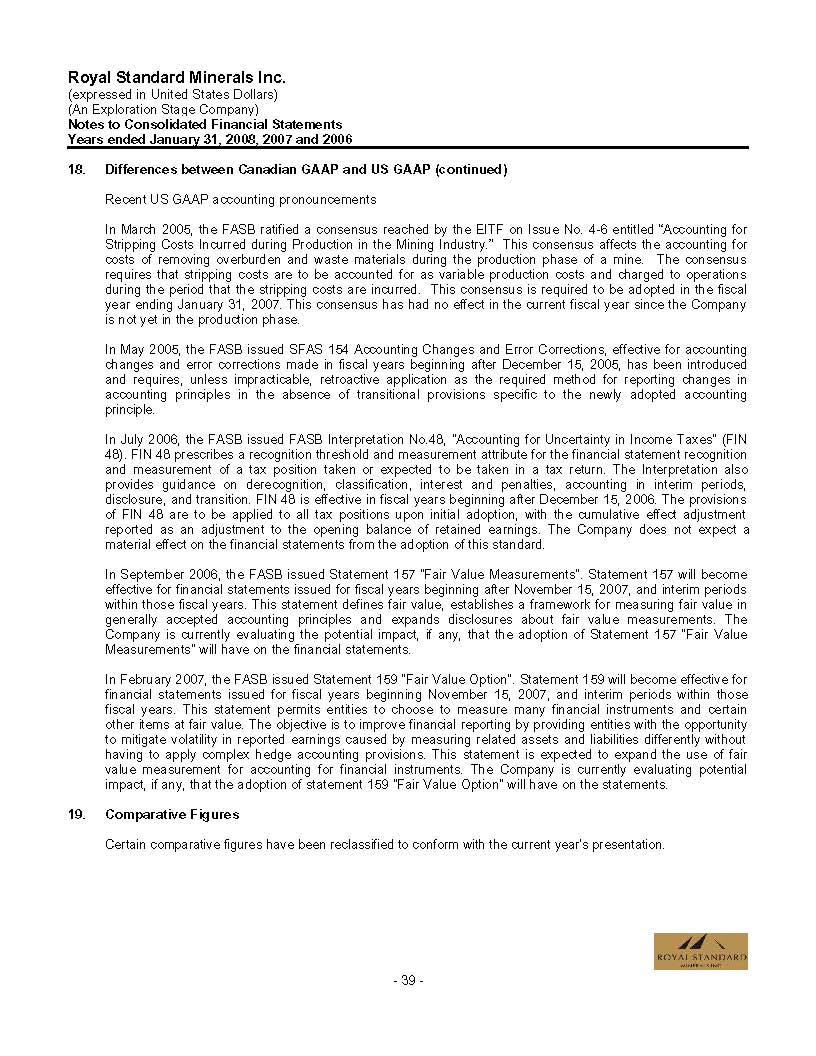
Management's Discussion and Analysis of Financial Condition and Results of Operations
The following discussion (the "MD&A") of the financial condition and results of operations of Royal Standard Minerals Inc. ("RSM", or "Company") constitutes management's review of the factors that affected the Company's financial and operating performance for the year ended January 31, 2008. The MD&A was prepared as of May 28, 2008 and should be read in conjunction with the audited annual financial statements for the years ended January 31, 2008 and 2007 of RSM including the notes thereto. Unless otherwise stated, all amounts discussed herein are denominated in United States dollars.
Overview
The Company is currently active in the State of Nevada, with projects in Nye (the Goldwedge and Manhattan projects), Elko (the Pinon, Railroad, and Dark Star projects) and Churchill (the Fondaway Canyon and Dixie-Comstock projects) Counties, Nevada. The Company's common shares are listed in Canada on the TSX Venture Exchange symbol RSM and on the US OTC:BB symbol RYSMF.
The Goldwedge project is considered to be an advanced exploration development project that is fully permitted by the Nevada Department of Environmental Protection (NDEP) for a mine and mill. This project was the major focus of the Company in fiscal 2008 and will continue to be its focus in fiscal 2009 along with the Pinon gold-silver project located in Elko County, Nevada.
The Company has been evaluating other investment opportunities in Nevada as part of an effort to improve upon its production capacity. Capital for the development of the currently controlled projects and any future acquisitions are envisioned to come from equity and debt financing.
Results of Operations
The net loss for the year ending January 31, 2008 was $2,019,479 as compared to the net loss of $4,511,483 for the year ending January 31, 2007. The decrease of $2,492,004 is principally the result of Stock Option Compensation of $853,953 for the year ending January 31, 2008 as compared to $3,838,926 for the year ending January 31, 2007.
General and administrative expenses increased from $618,962 for the year ending January 31, 2007 to $872,321 for the year ending January 31, 2008 an increase of $253,359 of which $157,472 was caused by increases in professional fees, the major portion of which were related to the settled litigation described in Note 14 of the consolidated financial statements as of January 31, 2008. The other increases are a direct result of continued activity on the Company's mineral projects. Consulting, wages and salaries increased from $443,693 for the year ending January 31, 2007 to $482,123 for the year ending January 31, 2008, an increase of $38,430. During the period ended January 31, 2008, the Company changed its accounting policy with regards to the amortization of its exploration equipment. In prior years, the Company recorded such amortization as an operating expense. As the Company is still in the exploration stage, the Company's management determined that it would be more appropriate to defer the amortization of the exploration equipment until the Company ceases to be in the exploration stage and enters the production stage. The effect of this change on the January 31, 2007 year end balance sheet is an increase in mineral properties by $759,636 and a corresponding decrease in the accumulated deficit by the same amount. The effect of this change on the net loss and the accumulated deficit for the years ended January 31, 2007 and 2006 is a decrease of $538,967 and $186,132 respectively and a corresponding increase in mineral properties. The opening accumulated deficit for the years ended January 31, 2007 and 2006 decreased by $220,669 and $34,537 respectively and a corresponding increase in opening balance in mineral properties.
Mineral Properties
The Company owns a 100% interest in a number of projects in the gold-silver districts in Nevada. These projects include the Goldwedge and Manhattan projects in Nye County, the Pinon, Railroad, and Dark Star projects in Elko County, the Fondaway Canyon, and Dixie-Comstock projects in Churchill County, Nevada.
Gold Wedge Project
The Gold Wedge project represents the most advanced project located in the Manhattan district about eight (8) miles south of the Round Mountain mine and has been issued a mine and mill permit by the Nevada Department of Environmental Protection (NDEP). RSM has completed construction of a processing plant on site which includes primary and secondary crushing facilities that feed a gravity recovery system. In addition, a heap leach pad, silt and fresh water ponds have been completed. Testing of the various mineral processing functions commenced during April 2007 using previously extracted stockpiles of low grade gold feed material to process into gold dore' using the Company's smelter. Completion of the test phase of the facility is not expected for several months. The Company has also commenced the underground development program which includes the exploration of defined mineralized zones concurrently with the second phase of decline development. The program has concentrated on the development of a spiral decline as a means to better explore the deposit at depth. As part of the program a series of crosscuts are constructed at specific intervals to effectively assess the potential mineralized zones. All material is sampled daily and analyzed for gold onsite at the company assay laboratory. The bulk sampling program is well underway and includes several months of stockpiled material on the surface.
On June 29, 2005 the Company entered into a 5-year Purchase Option Agreement with a private individual for all of his patented and unpatented mining claims in the Manhattan Mining District located in Nye County, Nevada. The land package totals approximately 1600 acres (4 patented, 70 unpatented claims). This property position adjoins the Company's Goldwedge Mine. The land package includes a number of exploration targets which are of interest to the Company. In addition, the Company's option includes the Dixie-Comstock claim group located in Churchill County, Nevada. The Dixie-Comstock is a 1500 acre property containing a gold system that has been explored by a number of major mining companies over the past 20 years. It is considered to be an attractive advanced exploration project. Annual option payments of $48,000 are to be applied to a total purchase price of $600,000. A gross production royalty of 8% will be paid to the owner anytime that production begins from the Manhattan Property or the Dixie-Comstock Property. The maximum of gross production royalties that would be paid under this agreement is $300,000.
The company has recorded an asset retirement obligation on its Gold Wedge Project in the amount of $149,050, representing the estimated costs of the Company's obligation to restore the property site to its original condition and which is equal to the amount of the reclamation bond posted by the Company with the State of Nevada.
Pinon-Railroad Project
The Company has also developed the necessary construction plans for the Pinon-Railroad project including surface, heap leach facilities design and open pit modeling of the deposits. All of this work was completed in preparation for the filing of a mining permit application with the US Bureau of Mines (BLM) and the Nevada Department of Environmental Protection (NDEP) by year-end 2007. A second objective is to update the feasibility studies for the Pinon/Railroad near surface oxide deposits.
Pinon Project - Cord Lease In August 2002, the Company entered into a mining lease agreement to lease certain properties located in Elko County, Nevada. The lessors will retain a 5% net smelter royalty with no option to purchase.
Pinon Project - Tomera Lease In August 2002, the Company entered into a mining lease agreement to lease certain properties located in Elko County, Nevada for a period of seven years. The lessors will retain a 5% net smelter royalty. In addition, the Company entered into an irrevocable lease agreement with the surface and minerals rights owners of the Tomera Lease properties.
Darkstar Lease Project In July 2006, the Company entered into a mining lease agreement to lease certain properties near the proposed Pinon mine site in Elko County, Nevada for a period of five years. The Darkstar gold property is located less than 2 miles from the Pinon property. The Company agreed to pay $6,400 on execution of the Agreement. The Company is committed to pay Annual option payments of $7,600 in 2007, $8,960 in 2008, $10,240 in 2009 and $11,520 in 2010. The lessor will also retain a 5% net smelter royalty.
The Company has recorded an asset retirement obligation on its Pinon-Railroad Projects, representing the estimated costs of the Company's obligation to restore the property site to its original condition as required by the State of Nevada regulatory authorities. The Company has recorded an asset retirement obligation in the amount of $54,136, equal to the amount of the reclamation bond posted by the Company with the State of Nevada.
Como Project
On December 2003, the Company entered into a mining lease agreement to lease certain properties located in Lyon County, Nevada. The Company agreed to pay $25,000 upon execution of the Agreement. The Company was committed to pay an annual option of $25,000 in 2005. Future payments are $25,000 in 2008 and $25,000 in 2009.
Subsequent to year-end, the Company decided not to pursue the exploration of this project and to write-off all accumulated deferred exploration costs.
Fondaway Project
The Fondaway Project is located in Churchill County, Nevada. The Company has leased the property and is obligated to make payments of $25,000 in fiscal 2003, $30,000 in 2004 and 2005 and $35,000 in each of the following seven years. The Company is also obligated to provide a 3% net smelter return upon production.
Liquidity and Capital Resources
The Company's Cash and cash equivalents balance as of January 31, 2008 was $7,209,173 compared to $9,654,288 at January 31, 2007, a decrease of $2,445,115. The Company also had $117,761 in short term investments at January 31, 2008, as compared to $433,699 at January 31, 2007, a decrease of $315,938.
On April 27, 2006, the Company completed a private placement of 12,975,967 units of the Company at $1.15 CDN per unit raising gross proceeds of $13,286,762 ($14,922,362 CDN). Each unit consisted of one common share of the Company and one-half of one common share purchase warrant. Each whole common share purchase warrant is exercisable at $1.75 CDN into one common share of the Company until April 26, 2008.
The fair value of the common share purchase warrants was estimated, on the date of closing, using the Black-Scholes option pricing model, with the following assumptions: dividend yield 0%, expected volatility of 98%, risk-free interest rate of 4.13% and an expected life of 24 months. The value assigned to the warrants is $2,847,058 ($3,198,582 CDN).
Current assets as at January 31, 2008 were $8,006,287 as compared to $10,438,324 at January 31, 2007. Mineral properties at January 31, 2008 were $13,895,392 compared to $8,547,743 at January 31, 2007 which represents an increase of $5,347,649, primarily reflecting the increased investment at the Company's Gold Wedge project. Equipment decreased from $2,056,392 at January 31, 2007 to $1,483,690 at January 31, 2008, primarily as a result of amortization. Total assets as at January 31, 2008 were $23,588,555 as compared to $21,224,226 at January 31, 2007. This represents an increase of $2,364,329 and is principally due to proceeds received from the exercise of stock options and warrants.
Current liabilities as at January 31, 2008 were $220,737 compared to $202,157 at January 31, 2007, and represent current trade payables.
Management believes that, subject to the achievement of significant revenue producing operations, equity and debt financings will remain the single major source of cash flow for the Corporation. However, there is no assurance that the Company can successfully obtain such financings in future periods.
The Company is authorized to issue an unlimited number of Common Shares without par value, of which 84,079,825 were outstanding at January 31, 2008, compared with 78,275,275 shares outstanding at January 31, 2007. On June 18, 2007, the Company initiated a normal course issuer bid process whereby a maximum of 4,000,000 common shares, representing approximately 5% of the issued and outstanding common shares presently outstanding, could be repurchased beginning June 25, 2007 and terminating June 25, 2008. On August 3, 2007, the Company purchased 91,000 common shares of the Company at a cost of $42,257. These shares purchased pursuant to the normal course issuer bid will be cancelled. The historical value of these shares will be removed from share capital and the excess over the purchase price will be recorded as an increase in contributed surplus.
At January 31, 2008 there were outstanding options to purchase 7,826,500 common shares of the Company with exercise prices from $0.27-$1.44 CDN per share and expiration dates ranging from December 2008 to July 2012. During the year ended January 31, 2008, options to purchase 1,515,000 shares of common stock were exercised at a weighted average exercise price of $0.31. On July 13, 2007, the Company granted options to purchase 2,015,000 common shares of the Company to directors, officers and employees. The options are exercisable at $0.60 CDN and expire within a period of 5 years. These stock options were fully vested on the date of grant and the fair value was charged to the statements of operations as consulting, wages and salaries. The fair value of the options was estimated using the Black-Scholes option pricing model, with the following assumptions: dividend yield 0%, expected volatility of 101%, risk-free interest rate of 4.60% and an expected life of 5 years. For year ending January 31, 2008, the value assigned to the options was $853,953 ($894,660 CDN).
The Company also had 6,487,996 warrants outstanding at January 31, 2008 with a weighted average exercise price of $1.75 CDN per share. These warrants expire April 26, 2008. None of these purchase warrants have been exercised before the expiry date.
Selected Annual Financial Information
The following selected financial information is derived from the annual financial statements of the Corporation and should be read in conjunction with such statements, including the notes thereto:
| | January 31 | | |
|---|
| 2008 | Restated 2007(1) | Restated 2006(1) | Cumulative from date of inception 6/26/1996 |
|---|
| Statement of Operations | | | | |
|---|
| Revenue | $0 | $0 | $0 | $0 |
|---|
| Interest Income | 396,294 | 391,420 | 0 | 739,211 |
|---|
| Administrative Expenses | (2,415,773) | (4,902,903) | (1,306,963) | (11,215,919) |
|---|
| Net loss for the year | (2,019,479) | (4,511,483) | (1,674,430) | (15,329,842) |
|---|
| Deficit, beginning of year | (14,051,103) | (9,539,620) | (7,865,190) | (740,740) |
|---|
| Deficit, end of year | ($16,070,582) | ($14,051,103) | ($9,539,620) | ($16,070,582) |
|---|
| Earnings (loss) per common share basic and diluted | ($0.02) | ($0.06) | ($0.03) | |
|---|
| January 31 |
|---|
| Balance Sheet | 2008 | 2007(1) |
|---|
| Current Assets | $8,006,287 | $10,438,324 |
|---|
| Interest in Mineral Properties and Related Deferred Exploration Costs | 13,895,392 | 8,547,743 |
|---|
| Equipment, Net | 1,483,690 | 2,056,392 |
|---|
| Current Liabilities | (220,737) | (202,157) |
|---|
1 See note 2 of the Consolidated Financial Statements (Audited) for the years ended January 31, 2008 and 2007.
Selected Quarterly Financial Information
The following is a summary of selected financial information of the Corporation for the quarterly periods indicated. These numbers have been restated (See note 2 of the Consolidated Financial Statements (Audited) for the Years ending January 31, 2008 and 2007.
| 3 Mos Ended January 31, 2008 | 3 Mos Ended October 31, 2007 | 3 Mos Ended July 31, 2007 | 3 Mos Ended April 30, 2007 | 3 Mos Ended January 31, 2007 | 3 Mos Ended October 31, 2006 | 3 Mos Ended July 31, 2006 | 3 Mos Ended April 30, 2006 |
|---|
| Revenue | $0 | $0 | $0 | $0 | $0 | $0 | $0 | $0 |
|---|
| Interest Income | 65,515 | 108,539 | 121,620 | 100,620 | 143,039 | 108,438 | 130,693 | 9,250 |
|---|
| Expenses (1) | (281,403) | (322,768) | (1,341,029) | (470,573) | 822,694 | (602,645) | (4,805,612) | (317,340) |
|---|
| Net Income (Loss) | ($215,888) | ($214,229) | ($1,219,409) | ($369,953) | $965,733 | ($494,207) | ($4,674,919) | ($308,090) |
|---|
| Net Income (Loss) per Common share basic and diluted | ($0.03) | $0.01 | ($0.01) | ($0.00) | ($0.00) | ($0.00) | ($0.05) | ($0.01) |
|---|
(1) Expenses in the 3 months ended January 31, 2007 reflect an adjustment of $1,749,130 for payroll and related expenses which were capitalized to the Gold Wedge Project in Mineral Properties.
Mineral Properties
The following table summarizes the mineral properties and expenditures during the year ended
| January 31, 2008. |
|---|
| Ending Balance January 31, 2007(1) | Additions (See details below) | Ending Balance January 31, 2008 |
|---|
| Gold Wedge Project | $6,912,843 | $4,953,218 | $11,866,061 |
|---|
| Pinon Project | 1,148,259 | 303,169 | 1,451,428 |
|---|
| Railroad Project | 215,813 | 115,633 | 331,446 |
|---|
| Fondaway Project | 162,778 | 83,679 | 246,457 |
|---|
| Como Project | 108,050 | (108,050) | 0 |
|---|
$8,547,743 $5,347,649 $13,895,392
- (1)
- Restated (See note 2 of the Consolidated Financial Statements (Audited) for the Years ending January 31, 2008 and 2007.
Activity during the period 4,953,218 4,055,312 1,362,551 11,866,061 Closing balance $11,866,061 $6,912,843 $2,857,531 $11,866,061
- (1)
- See note 2 of the Consolidated Financial Statements (Audited) for the Years ended January 31, 2008 and 2007.
| Detail of Mineral Properties |
|---|
| Cumulative |
|---|
| from date of |
|---|
| Restated | Restated | inception of |
|---|
| For the years ending | January 31, 2008 | January 31, 2007(1) | January 31, 2006(1) | exploration phase |
|---|
| Gold Wedge Project | | | | |
|---|
| Opening balance | $6,912,843 | $2,857,531 | $1,494,980 | $0 |
|---|
| Property Acquisition costs | 93,463 | 171,376 | 184,892 | 599,862 |
|---|
| Travel | 77,588 | 77,737 | 70,862 | 290,141 |
|---|
| Mine development costs | 241,075 | 293,519 | 237,867 | 982,208 |
|---|
| Drilling | 606,223 | 53,185 | 78,790 | 884,639 |
|---|
| General exploration | 0 | 5,023 | 38,776 | 133,353 |
|---|
| Professional fees | 0 | 0 | 33,740 | 72,636 |
|---|
| Consulting | 1,146,119 | 1,377,706 | 243,297 | 3,471,045 |
|---|
| Office and general | 729,941 | 335,767 | 79,701 | 1,145,909 |
|---|
| Analysis and assays | 23,899 | 30,063 | 22,240 | 118,621 |
|---|
| Supplies, Equipment and | | | | |
|---|
| transportation | 1,389,747 | 1,171,969 | 186,254 | 2,762,848 |
|---|
| Amortization | 645,163 | 538,967 | 186,132 | 1,404,799 |
|---|
| Cumulative |
|---|
| from date of |
|---|
| Restated | Restated | inception of |
|---|
| For the years ending | January 31, 2008 | January 31, 2007(1) | January 31, 2006(1) | exploration phase |
|---|
| Pinon Project | | | | |
|---|
| Opening balance | $1,148,259 | $762,285 | $600,538 | $0 |
|---|
| Property Acquisition costs | 19,017 | 34,047 | 40,258 | 444,587 |
|---|
| Travel | 14,978 | 0 | 801 | 26,828 |
|---|
| Drilling | 0 | 8,333 | 72,780 | 130,600 |
|---|
| General exploration | 0 | 0 | 0 | 7,765 |
|---|
| Professional fees | 0 | 0 | 0 | 66,273 |
|---|
| Office and general | 54,413 | 15,296 | 2,698 | 98,120 |
|---|
| Geologist | 0 | 0 | 25,008 | 32,653 |
|---|
| Consulting | 207,590 | 151,133 | 19,537 | 402,492 |
|---|
| Reclamation costs | 0 | 167,785 | 0 | 167,785 |
|---|
| Analysis and assays | 7,171 | 9,380 | 382 | 74,042 |
|---|
| Supplies, Equipment and | | | | |
|---|
| transportation | 0 | 0 | 283 | 283 |
|---|
| Activity during the period | 303,169 | 385,974 | 161,747 | 1,451,428 |
|---|
| Closing balance | $1,451,428 | $1,148,259 | $762,285 | $1,451,428 |
|---|
| Railroad Project | | | | |
|---|
| Opening balance | $215,813 | $175,670 | $175,670 | $0 |
|---|
| Property Acquisition costs | 115,633 | 40,143 | 0 | 331,446 |
|---|
| Activity during the period | 115,633 | 40,143 | 0 | 331,446 |
|---|
| Closing balance | $331,446 | $215,813 | $175,670 | $331,446 |
|---|
| Fondaway Project | | | | |
|---|
| Opening balance | $162,778 | $127,652 | $96,028 | $0 |
|---|
| Property Acquisition costs | 64,754 | 35,126 | 31,624 | 227,181 |
|---|
| Travel | 3,279 | 0 | 0 | 3,279 |
|---|
| Drilling | 15,646 | 0 | 0 | 15,646 |
|---|
| Analysis and assays | 0 | 0 | 0 | 351 |
|---|
Activity during the period 83,679 35,126 31,624 246,457 Closing balance $246,457 $162,778 $127,652 $246,457
(1) See note 2 of the Consolidated Financial Statements (Audited) for the Years ended January 31, 2008 and 2007.
| Cumulative |
|---|
| from date of |
|---|
| Restated | Restated | inception of |
|---|
| For the years ending | January 31, 2008 | January 31, 2007(1) | January 31, 2006(1) | exploration phase |
|---|
| Como Project | | | | |
|---|
| Opening balance | $108,050 | $108,050 | $86,330 | $0 |
|---|
| Property Acquisition costs | 35,933 | 0 | 0 | 71,628 |
|---|
| Travel | 0 | 0 | 0 | 2,806 |
|---|
| Geologist | 0 | 0 | 0 | 5,098 |
|---|
| Consulting | 0 | 0 | 0 | 41,532 |
|---|
| Rent | 1,477 | 0 | 21,720 | 55,052 |
|---|
| Analysis and assays | 0 | 0 | 0 | 9,138 |
|---|
| Written off | (145,460) | 0 | 0 | (185,254) |
|---|
| Activity during the period | (108,050) | 0 | 21,720 | 0 |
|---|
| Closing balance | $0 | $108,050 | $108,050 | $0 |
|---|
| Manhattan Project | | | | |
|---|
| Opening balance | $0 | $0 | $191,065 | $0 |
|---|
| Property Acquisition costs | 0 | 0 | 0 | 27,707 |
|---|
| Travel | 0 | 0 | 0 | 28,253 |
|---|
| General Exploration | 0 | 0 | 1,458 | 63,219 |
|---|
| Consulting | 0 | 0 | 0 | 47,743 |
|---|
| Analysis and assays | 0 | 0 | 0 | 25,601 |
|---|
| Written off | 0 | 0 | (192,523) | (192,523) |
|---|
| Activity during the period | 0 | 0 | (191,065) | 0 |
|---|
| Closing balance | $0 | $0 | $0 | $0 |
|---|
| Other Projects | | | | |
|---|
| Opening balance | $0 | $0 | $54,053 | $0 |
|---|
| Cumulative expenditures | | | | |
|---|
| From date of inception | 0 | 0 | 0 | 3,410,396 |
|---|
| Expenditures during the year | 0 | 0 | 120,891 | 161,548 |
|---|
| Written off | 0 | 0 | (174,944) | (3,571,944) |
|---|
| Activity during the period | 0 | 0 | (54,053) | 0 |
|---|
| Closing balance | $0 | $0 | $0 | $0 |
|---|
| TOTAL | $13,895,392 | $8,547,743 | $4,031,186 | $13,895,392 |
|---|
Transactions with Related Parties
Years Ended January 31 2008 2007 2006
| Due from (to) related parties |
|---|
| The President & Director of the |
|---|
| Company(1) Sharpe Resources Corporation(2) | $20,510 127,498 | $17,402 104,984 | $18,049 108,293 |
|---|
| The President & Director of the | | | |
|---|
| Company(3) | 285,711 | 0 | 0 |
|---|
| $433,719 | $122,386 | $126,342 |
|---|
- (1)
- This advance is unsecured, non-interest bearing and has no set terms of repayment.
- (2)
- Sharpe is related to the Company because of common management. This advance is unsecured, non-interest bearing and has no set terms of repayment.
- (3)
- This advance bears interest at 4% and is repayable within 3 years.
Consulting, wages and salaries include a bonus of $117,678 (2007 - $170,000; 2006 - $nil) and salary of $249,995 (2007 - $252,621; 2006 - $96,192) paid to the President of the Company.
Consulting, wages and salaries include salary of $78,002 (2007 - $48,923; 2006 - $nil) paid to an employee who is also a family member of the President and Director of the Company.
Compensation of $60,008 (2007 - $12,155; 2006 - $nil) was paid to the former CFO of the Company.
These transactions were in the normal course of operations and were measured at the exchange value which represented the amount of consideration established and agreed to by the related parties.
Contingencies and Commitments
1. On October 11, 2006 the Company received documents purporting to constitute a requisition from a group of shareholders of Royal (the "Dissident Group") alleging that they hold more than 10% of the Company's shares. The documents received requested that a shareholders' meeting be called to consider the removal and replacement of the existing board of directors of Royal.
On October 28, 2006 the Company filed an action in the United States District Court for the Central District of California against the persons and entities who have identified themselves as belonging to the Dissident Group. The Company alleges that the defendants violated section 13(d) of the Securities Exchange Act of 1934, 15 U.S.C 78m(d), by failing to file a Schedule 13-D.
On November 29, 2007, the parties executed an Agreement, pending formal approval of the court, to settle this matter in a manner which is favorable to all of the parties and without any financial costs to the Company other than the legal costs incurred. A final stipulated judgment and dismissal of the case was filed and heard by the Court on May 5, 2008. The Court has signed the proposed judgment resulting in a final judgment entered in the case.
- On January 1, 2006, the Company entered into a management agreement with the President of the Company for management and consulting services for $250,000 per annum which expires in January 1, 2011. On January 1, 2007 and on each January 1 during the term of the agreement, the compensation may be increased by 10% per annum. This agreement can be renewed for an additional five years.
- The Company is obligated to incur an additional $96,000 in option costs before July 1, 2009 pursuant to the agreement of the Gold Wedge Project.
- The Company is obligated to incur an additional $40,000 in option costs before the end of fiscal 2010 pursuant to the agreement of the Railroad Project.
- The Company is obligated to incur an additional $225,000 in exploration expenditures and $30,720 in option costs before July 31, 2011 pursuant to the agreement of the Darkstar gold property.
- The Company is obligated to incur an additional $140,000 in option costs before the end of fiscal 2012 pursuant to the agreement of the Fondaway Project.
Changes in Accounting Policies
Accounting Changes
Effective February 1, 2007, the Company adopted the Canadian Institute of Chartered Accountants ("CICA") Section 1506, "Accounting Changes". This section prescribes the criteria for changing accounting policies, together with the accounting treatment and disclosure of changes in accounting policies, changes in accounting estimates and correction of errors.
Change in accounting policy with retroactive application
During the year ended January 31, 2008, the Company changed its accounting policy with regards to the amortization of its exploration equipment. In prior periods, the Company recorded such amortization as an operating expense. As the Company is still in the exploration stage, the Company's management determined that it would be more appropriate to defer the amortization of the exploration equipment until the Company ceases to be in the exploration stage and enters the production stage. The effect of this change on the January 31, 2007 year end balance sheet is an increase in mineral properties by $759,636 and a corresponding decrease in the accumulated deficit by the same amount. The effect of this change on the net loss and the accumulated deficit for the years ended January 31, 2007 and 2006 is a decrease of $538,967 and $186,132 respectively and a corresponding increase in mineral properties. The Opening accumulated deficit for the years ended January 31, 2007 and 2006 decreased by $220,669 and $34,537 respectively and a corresponding increase in opening balance in mineral properties.
Financial instruments, comprehensive income (loss) and hedges
In January 2005, the CICA issued Handbook Sections 3855, "Financial Instruments - Recognition and Measurement", 1530, "Comprehensive Income", 3861, "Financial Instruments
- Disclosure and Presentation" and 3865, "Hedges". These new standards are effective for interim and annual financial statements relating to fiscal years commencing on or after October 1, 2006 on a prospective basis; accordingly, comparative amounts for prior periods have not been restated. The Company has adopted these new standards effective February 1, 2007.
(a) Financial instruments - recognition and measurement
Section 3855 prescribes when a financial instrument is to be recognized on the balance sheet and at what amount. It also specifies how financial instrument gains and losses are to be presented. This Section requires that:
- All financial assets be measured at fair value on initial recognition and certain financial assets to be measured at fair value subsequent to initial recognition;
- All financial liabilities be measured at fair value if they are classified as held for trading purposes. Other financial liabilities are measured at amortized cost using the effective interest method; and
- All derivative financial instruments be measured at fair value on the balance sheet, even when they are part of an effective hedging relationship.
- (b)
- Comprehensive income (loss)
Section 1530 introduces a new requirement to temporarily present certain gains and losses from changes in fair value outside net income. It includes unrealized gains and losses, such as: changes in the currency translation adjustment relating to self-sustaining foreign operations; unrealized gains or losses on available-for-sale investments; and the effective portion of gains or losses on derivatives designated as cash flow hedges or hedges of the net investment in self-sustaining foreign operations.
- (c)
- Financial Instruments - disclosure and presentation
Section 3861 establishes standards for presentation of financial instruments and non-financial derivatives, and identifies the information that should be disclosed about them. Under the new standards, policies followed for periods prior to the effective date generally are not reversed and therefore, the comparative figures have not been restated except for the requirement to restate currency translation adjustments as part of other comprehensive income.
- (d)
- Hedges
Section 3865 provides alternative treatments to Section 3855 for entities which choose to designate qualifying transactions as hedges for accounting purposes. It replaces and expands on Accounting Guideline 13 "Hedging Relationships", and the hedging guidance in Section 1650 "Foreign Currency Translation" by specifying how hedge accounting is applied and what disclosures are necessary when it is applied.
- (e)
- Impact upon adoption of Sections 1530, 3855, 3861 and 3865
The primary impact on the consolidated financial statements resulting from the adoption of sections 1530 and 3855 is as follows:
- (1)
- The Company's marketable securities are classified as "available-for-sale" and are measured at fair value. Changes in fair value are recognized in other comprehensive income until their disposition, at which time they are transferred to net income. Investments in securities having quoted market values and which are publicly traded on a recognized securities exchange and for which no sales restrictions apply are recorded at values based on the current bid prices.
The Company's investments in equity securities that do not have a quoted market price in an active market are measured at cost. As at January 31, 2008 the Company did not have any such investments.
As at January 31, 2007, marketable securities are carried at cost. At January 31, 2008, the Company's marketable securities are carried at fair market value.
- (2)
- The Company has recorded the following transition adjustments in its interim consolidated financial statements as at February 1, 2007 resulting from the adoption of sections 1530 and 3855:
i) an increase of $32,596, representing a fair value adjustment to the value of marketable securities; and ii) an increase in accumulated other comprehensive income of $32,596, representing the fair value adjustment of marketable securities of $32,596, net of taxes of $5,887 and recovery of capital loss carry forwards of $5,887.
- (3)
- The Company has evaluated the impact of section 3861 and 3865 on its consolidated financial statements and determined that no adjustments are currently required.
The adoption of these Handbook Sections had no impact on opening deficit.
Accounting policy choice for transaction costs
On June 1, 2007, the Emerging Issues Committee of the CICA issued Abstract No.166, Accounting Policy Choice for Transaction Costs (EIC-166). This EIC addresses the accounting policy choice of expensing or adding transaction costs related to the acquisition of financial assets and financial liabilities that are classified as other than held-for-trading. Specifically, it requires that the same accounting policy choice to be applied to all similar financial instruments classified as other than held-for-trading, but permits a different policy choice for financial instruments that are not similar. The Company has adopted EIC-166 effective October 31, 2007 which requires retroactive application to all transaction costs accounted for in accordance with CICA Handbook Section 3855, Financial Instruments - Recognition and Measurement. The Company has evaluated the impact of EIC-166 and determined that no adjustments are currently required.
Future accounting changes
Capital Disclosures and Financial Instruments - Disclosures and Presentation
On December 1, 2006, the CICA issued three new accounting standards: Handbook Section 1535, Capital Disclosures, Handbook Section 3862, Financial Instruments - Disclosures, and Handbook Section 3863, Financial Instruments - Presentation. These new standards are effective for interim and annual consolidated financial statements for the Company's reporting period beginning on February 1, 2008.
Section 1535 specifies the disclosure of (i) an entity's objectives, policies and processes for managing capital; (ii) quantitative data about what the entity regards as capital; (iii) whether the entity has complied with any capital requirements; and (iv) if it has not complied, the consequences of such non-compliance. .
The new Sections 3862 and 3863 replace Handbook Section 3861, Financial Instruments — Disclosure and Presentation, revising and enhancing its disclosure requirements, and carrying forward unchanged its presentation requirements. These new sections place increased emphasis on disclosures about the nature and extent of risks arising from financial instruments and how the entity manages those risks.
The Company is currently assessing the impact of these new accounting standards on its consolidated financial statements.
Disclosure Controls and Procedures
RSM's President and Chief Financial Officer ("CFO") are responsible for establishing and maintaining the Company's disclosure controls and procedures. Access to material information is facilitated by the small size of RSM's management team. The President and the CFO, after evaluating the effectiveness of the RSM disclosure controls and procedures as of January 31, 2008, have concluded that the Company's disclosure controls and procedures were adequate and effective to ensure that material information relating to RSM and its subsidiaries would have been known to them.
The President and CFO have designed internal controls over financial reporting to provide reasonable assurance regarding the reliability of financial reporting and the preparation of financial statements for external purposes in accordance with Canadian GAAP.
Risk and Uncertainties
At the present time, the Corporation's viability and potential success lie in its ability to develop, exploit and generate revenue out of its current and future precious metal properties. The Corporation's ability to acquire and develop it current precious metal properties and any new properties is a function of its ability to raise the necessary capital to pursue the efforts successfully.
The Corporation has limited financial resources and there is no assurance that additional capital will be available to it for further acquisitions, exploration and development of new or existing projects. Although the Corporation has been successful in the past in obtaining financing there is no guarantee that it will be successful in the future or that the terms of such financing will be favorable. Failure to obtain such additional financing could result in delay or indefinite postponement of further exploration and development of the property interests of the Corporation with the possible dilution or loss of such interests.
Forward Looking Statements
This MD&A includes certain "forward-looking statements" within the meaning of applicable Canadian securities legislation. All statements, other than statements of historical facts, included in this MD&A that address activities, events or developments that the Corporation expects or anticipates will or may occur in the future, including such things as future business strategy, competitive strengths, goals, expansion and growth of the Corporation's businesses, operations, plans and other such matters are forward-looking statements. When used in this MD&A, the words "estimate", "plan", "anticipate", "expect", "intend", "believe" and similar expressions are intended to identify forward-looking statements. These statements involve known and unknown risks, uncertainties and other factors which may cause the actual results, performance or achievements of the Corporation to be materially different from any future results, performance or achievements expressed or implied by such forward-looking statements. Such factors include, among others, risks related to joint venture operations, actual results of current exploration activities, changes in project parameters as plans continue to be refined unavailability of financing, fluctuations in the precious metal prices and other factors. Although the Corporation has attempted to identify important factors that could cause actual results to differ materially, there may be other factors that cause results not to be anticipated, estimated or intended. There can be no assurance that such statements will prove to be accurate as actual results and future events could differ materially from those anticipated in such statements. Accordingly, readers should not place undue reliance on forward-looking statements.
Additional Information
Additional information relating to the Corporation, including the annual information form of the Corporation, can be found on SEDAR at www.sedar.com and on the Corporation's website at www.royalstandardminerals.com.
\s\ Roland M. Larsen
Roland M. Larsen President
Heathsville, VA May 28, 2008
Item 18. Financial Statements.
Not applicable.
Item 19. Exhibits.
None
SIGNATURES
The registrant hereby certifies that it meets all of the requirements for filing on Form 20-F and that it has duly caused and authorized the undersigned to sign this annual report on its behalf.
ROYAL STANDARD MINERALS INC. (Registant) /s/ Roland M. Larsen Roland M. Larsen, President & CEO
Date: July 27, 2008
Risks Associated with Forward Looking Statements. This Form 20-F contains certain forward-looking statements within the meaning of Section 27A of the Securities Act of 1933, as amended (the "Securities Act"), and Section 21e of the securities Exchange Act of 1934, as amended (the "Exchange Act"), which are intended to be covered by the safe harbors created thereby. Investors and shareholders are cautioned that all forward-looking statements involve risks and uncertainty, including without limitation, the ability of the Company to continue its mineral exploration strategy, complete recommended work programs, the success of the Company in locating mineral bodies in commercially recoverable quantities, the ability of the Company to develop the mineral bodies either on its own or in partnership with third parties, the ability of the Company to acquire interests in mineral exploration properties or mining claims, as well as market prices for mineral resources, competition and general market conditions. Although the Company believes that the assumptions underlying the forward-looking statements contained herein are reasonable, any of the assumptions could be inaccurate, and therefore, there can be no assurance that the forward-looking statements included in this Form 20-F will prove to be accurate. In light of the significant uncertainties inherent in the forward-looking statements included herein, the inclusion of such information should not be regarded as a representation by the Company or any other person that the objectives and plans of the Company will be achieved.
CERTIFICATIONS
I, Roland M. Larsen, certify that:
- I have reviewed this annual report on Form 20-F of Royal Standard Minerals Inc.;
- Based on my knowledge, this annual report does not contain any untrue statement of a material fact or omit to state a material fact necessary to make the statements made, in light of the circumstances under which such statements were made, not misleading with respect to the period covered by this annual report;
- Based on my knowledge, the financial statements, and other financial information included in this annual report, fairly present in all material respects the financial condition, results of operations and cash flows of the registrant as of, and for, the periods presented in this report;
- The company's other certifying officers and I are responsible for establishing and maintaining disclosure controls and procedures (as defined in Exchange Act Rules 13a-15(e) and 15d-15(e)) and internal control over financial reporting (as defined in Exchange Act Rules 13a-15(f) and 15d-15(f)) for the company and have:
- Designed such disclosure controls and procedures, or caused such disclosure controls and procedures to be designed under our supervision, to ensure that material information relating to the company, including its consolidated subsidiaries, is made known to us by others within those entities, particularly during the period in which this report is being prepared:
- Designed such internal control over financial reporting, or caused such internal control over financial reporting to be designed under our supervision, to provide reasonable assurance regarding the reliability of financial reporting and the preparation of financial statements for external purposes in accordance with generally accepted accounting principles;
- Evaluated the effectiveness of the company's disclosure controls and procedures and presented in this report our conclusions about the effectiveness of the disclosure controls and procedures, as of the end of the period covered by this report based on such evaluation; and
- Disclosed in this report any change in the company's internal control over financial reporting that occurred during the period covered by the annual report that has materially affected, or is reasonably likely to materially affect, the company's internal control over financial reporting; and
- The company's other certifying officers and I have disclosed, based on our most recent evaluation of internal controls over financial reporting, to the company's auditors and the audit committee of company's board of directors (or persons performing the equivalent function):
- All significant deficiencies and material weaknesses in the design or operation of internal control over financial reporting which are reasonably likely to adversely affect the company's ability to record, process, summarize and report financial information; and
- Any fraud, whether or not material, that involves management or other employees who have a significant role in the company's internal control over financial reporting.
Date: July 27, 2008
\s\ Roland M. Larsen Roland M. Larsen President & CEO
CERTIFICATIONS
I, Kimberly Koerner, certify that:
- I have reviewed this annual report on Form 20-F of Royal Standard Minerals Inc.;
- Based on my knowledge, this annual report does not contain any untrue statement of a material fact or omit to state a material fact necessary to make the statements made, in light of the circumstances under which such statements were made, not misleading with respect to the period covered by this annual report;
- Based on my knowledge, the financial statements, and other financial information included in this annual report, fairly present in all material respects the financial condition, results of operations and cash flows of the registrant as of, and for, the periods presented in this report;
- The company's other certifying officers and I are responsible for establishing and maintaining disclosure controls and procedures (as defined in Exchange Act Rules 13a-15(e) and 15d-15(e)) and internal control over financial reporting (as defined in Exchange Act Rules 13a-15(f) and 15d-15(f)) for the company and have:
- Designed such disclosure controls and procedures, or caused such disclosure controls and procedures to be designed under our supervision, to ensure that material information relating to the company, including its consolidated subsidiaries, is made known to us by others within those entities, particularly during the period in which this report is being prepared:
- Designed such internal control over financial reporting, or caused such internal control over financial reporting to be designed under our supervision, to provide reasonable assurance regarding the reliability of financial reporting and the preparation of financial statements for external purposes in accordance with generally accepted accounting principles;
- Evaluated the effectiveness of the company's disclosure controls and procedures and presented in this report our conclusions about the effectiveness of the disclosure controls and procedures, as of the end of the period covered by this report based on such evaluation; and
- Disclosed in this report any change in the company's internal control over financial reporting that occurred during the period covered by the annual report that has materially affected, or is reasonably likely to materially affect, the company's internal control over financial reporting; and
- The company's other certifying officers and I have disclosed, based on our most recent evaluation of internal controls over financial reporting, to the company's auditors and the audit committee of company's board of directors (or persons performing the equivalent function):
- All significant deficiencies and material weaknesses in the design or operation of internal control over financial reporting which are reasonably likely to adversely affect the company's ability to record, process, summarize and report financial information; and
- Any fraud, whether or not material, that involves management or other employees who have a significant role in the company's internal control over financial reporting.
Date: July 27, 2008
\s\ Kimberly Koerner Kimberly Koerner Director
Royal Standard Minerals Inc.
Certification Pursuant to Section 906 of the Sarbanes-Oxley Act of 2002
I, Roland M. Larsen, Chief Executive Officer of Royal Standard Minerals Inc. ("the Company"), certify that:
- the annual report on Form 20F of the Company for the fiscal year ending January 31, 2008 as filed with the Securities and Exchange Commission on the date hereof (the "report") fully complies with the requirements of Section 13(a) or 15(d) of the Securities and Exchange Act of 1934; and
- the information contained in the Report fairly presents, in all material respects, the financial condition and results of operations of the Company.
/s/ Roland M. Larsen Roland M. Larsen Chief Executive Officer July 27, 2008
Royal Standard Minerals Inc.
Certification Pursuant to Section 906 of the Sarbanes-Oxley Act of 2002
I, Kimberly Koerner, Director of Royal Standard Minerals Inc. ("the Company"), certify that:
- the annual report on Form 20F of the Company for the fiscal year ending January 31, 2008 as filed with the Securities and Exchange Commission on the date hereof (the "report") fully complies with the requirements of Section 13(a) or 15(d) of the Securities and Exchange Act of 1934; and
- the information contained in the Report fairly presents, in all material respects, the financial condition and results of operations of the Company.
/s/ Kimberly Koerner Kimberly Koerner Director July 27, 2008













































